Exhibit 8

Contents
at a Glance
Getting Started 3
Preparing Your Phone for Use 4
Turning Your Phone On and Off 9
Display Information and Key Functions 11
Making and Receiving Calls 13
During a Call 16
Functions and Settings 19
T28 WORLD Features 20
Using the Menus 21
Your Personal Phone Book 27
Using the Call List 35
Your Voice Mail Service 37
Personalizing Your Phone 39
Sending and Receiving Text Messages (SMS) 46
Diverting Incoming Calls 56
Security for Your Phone and Subscription 58
Handling More than One Call Simultaneously 65
Setting Network Preferences 70
Knowing the Call Time/Call Cost 73
Using Two Voice Lines 75
Voice Control 76
Calling Card Calls 79
Sending and Receiving Fax and Data Calls 82
Extras 84
The Profile Concept 88
Accessories 91
Online Services 99
Additional Information 103
Quick Keys 104
Troubleshooting 106
Ericsson Mobile Internet 108
Technical Data 109
Glossary 110
Guidelines for Safe and Efficient Use 115
Warranty 121
Declaration of Conformity 123
Index 125
Ericsson T28 WORLD
First edition (September 1999)
This manual is published by Ericsson
Mobile Communications AB, without any
warranty. Improvements and changes to
this manual necessitated by typographical
errors, inaccuracies of current information,
or improvements to programs and/or equip-
ment, may be made by Ericsson Mobile
Communications AB at any time and with-
out notice. Such changes will, however, be
incorporated into new editions of this
manual.
All rights reserved.
©Ericsson Mobile Communications AB,
1999
Publication number: EN/LZT 108 3026 R1B
Printed in Sweden
INNOVATRON PATENTS
Marianne.book Page 1 Friday, October 1, 1999 2:00 PM

Please note!
Some of the services in this manual are not supported by all net-
works. This also applies to the GSM International Emergency
Number 112 (or 911 in the Americas).
Please contact your network operator or service provider if you are
in doubt whether you can use a particular service or not.
Note! You should read the Guidelines for Safe and Efficient Use
and the Warranty chapters before using your mobile phone
Note! This manual is also available in multiple languages on a
CD-ROM that is part of the box contents you have received.
The symbol on our products signifies that they have been certi-
fied according to the EMC directive 89/336/EEC, the Telecommu-
nications directive 91/263/EEC, and the Low Voltage directive
73/23/EEC when applicable. The products fulfil the requirements
according to the following standards:
Cellular Phones and Accessories in Combination:
ETS 300 342-1 EMC for European digital cellular telecommunica-
tions.
Accessories Without Direct Connection to a Cellular Phone:
EN 50081 Electromagnetic compatibility, Generic Emission
Standard, and EN 50082 Electromagnetic compatibility, Generic
Immunity Standard.
Marianne.book Page 2 Friday, October 1, 1999 2:00 PM
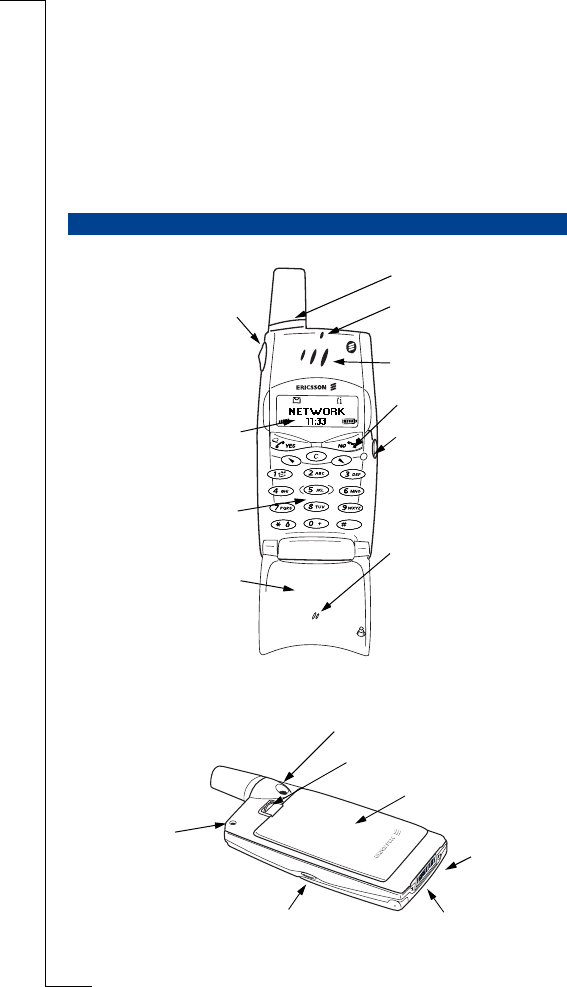
4 Preparing Your Phone for Use
Preparing Your Phone
for Use
Front
Back
OVERVIEW
A
ntenna
Indicator light
Earpiece
Power On/Off
Flip release button
Microphone
Volume key
Display
Keypad
Flip
Connector for external antenna
Hole for belt clip
Battery release catch
Flip release button
Handsfree
connector
Charging
connector
Battery
Marianne.book Page 4 Friday, October 1, 1999 2:00 PM
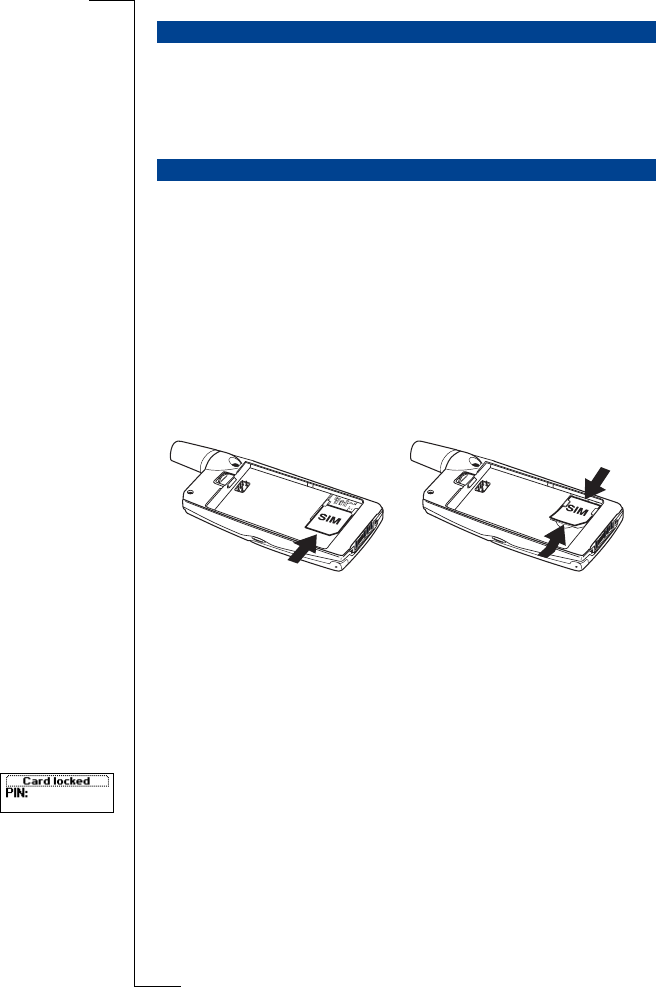
Preparing Your Phone for Use 5
You need to do the following to use your phone:
•insert the SIM card
•attach the battery to the phone
•charge the battery
When you register as a subscriber with a network operator, you get a SIM
(Subscriber Identity Module) card. The SIM card contains a computer chip
that keeps track of your phone number, the services included in your subscrip-
tion, and your Phone Book information, among other things.
SIM cards come in two sizes. One is the size of a credit card and the other is
smaller. Your phone uses the smaller card. Many credit card-sized SIM cards
have a perforated smaller card that you can take out easily. Before you can use
your phone, you must insert the SIM card as shown below.
Inserting and Removing the SIM Card
1. Remove the battery if
attached. Slide the SIM card
into the slot, under the silvery
holders, with the golden con-
nectors facing down and the
cut corner to the right.
2. Raise the edge of the SIM card
and slide it out.
The PIN
Most SIM cards are supplied with a security code, also known as PIN
(Personal Identity Number), which you need to access the network. Every
time you turn on your phone, you are asked to enter your PIN. You will find
your PIN in the information from your operator.
Some operators may have services that require a second PIN, your PIN2.
You should be careful with your PIN, since it is your protection against
unauthorized use of your subscription.
ASSEMBLY
THE SIM CARD
Marianne.book Page 5 Friday, October 1, 1999 2:00 PM
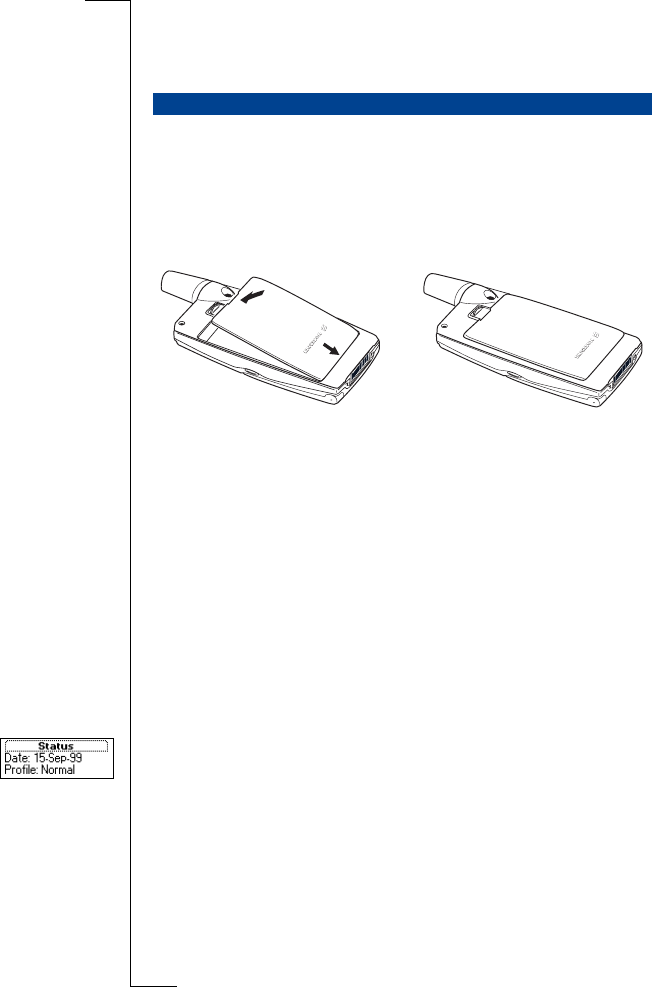
6 Preparing Your Phone for Use
If your PIN is entered incorrectly three times in a row, the SIM card is
blocked. If this happens, you can unlock it by using your PUK (Personal
Unblocking Key code), which you also get from your operator.
Your T28 WORLD comes with a lithium battery. The battery is not charged
when you buy your phone, but there may be enough power to switch the
phone on. We recommend that you charge the battery up to three hours before
you use the phone for the first time.
Attaching the Battery to Your Phone
When to Charge the Battery
The battery that comes with your phone can be charged whenever you wish
without affecting its performance. You can also charge the battery when the
phone is off.
To remind you that you will soon need to charge the battery or replace it with
a charged one:
•an alarm signal (a short beep) sounds and the message
Attention! Battery low
appears in the display
•the indicator light on top of the phone starts flashing red
If you have an Ericsson-approved battery, you can check the remaining talk
and standby times in the Status menu by sliding the volume key upwards or
downwards in standby mode. You can move downwards in the menu by press-
ing é. The remaining standby and talk times depend on the type of battery
you use and your position in the network. Please note that these times are
approximate and you may have 20% less time than is shown in the display.
Note! The phone turns itself off when the battery can no longer power it
satisfactorily.
THE BATTERY
•Place the battery on the back of the phone and push until you hear a click.
Marianne.book Page 6 Friday, October 1, 1999 2:00 PM

Preparing Your Phone for Use 7
Charging the Battery
Note! The mains plug may look different depending on the mains socket in
your country. The mains plug may not be used for other products than Erics-
son chargers.
To indicate charging:
•the indicator on the top of the phone shows a steady red light (or green, if
the phone is switched on)
•the message
Charging only
is shown in the display
•the battery meter in the display pulses continuously
Note! If you charge a new battery that is empty, or a battery that has not been
used for a long time, it may take a while until you get an indication of
charging in the display. Only then can you switch on and use your phone.
An Ericsson-approved battery is indicated by
Ericsson Optimized charging
each
time you start charging the battery when the phone is switched on. For the best
charging, talk and standby times in the long run, we recommend that you use
only Ericsson-approved batteries with your phone.
Batteries that are not Ericsson-approved are charged slowly for safety reasons.
These are indicated by
Charging alien battery
each time you start charging the bat-
tery when the phone is switched on.
Tip! You can use the phone while the battery is being charged. However, this
lengthens the charging time.
3. Connect the charger to the phone
as shown. The flash symbol on the
plug must face upwards.
1. Make sure that the battery is
attached to the phone.
2. Connect the charger to the mains.
Marianne.book Page 7 Friday, October 1, 1999 2:00 PM
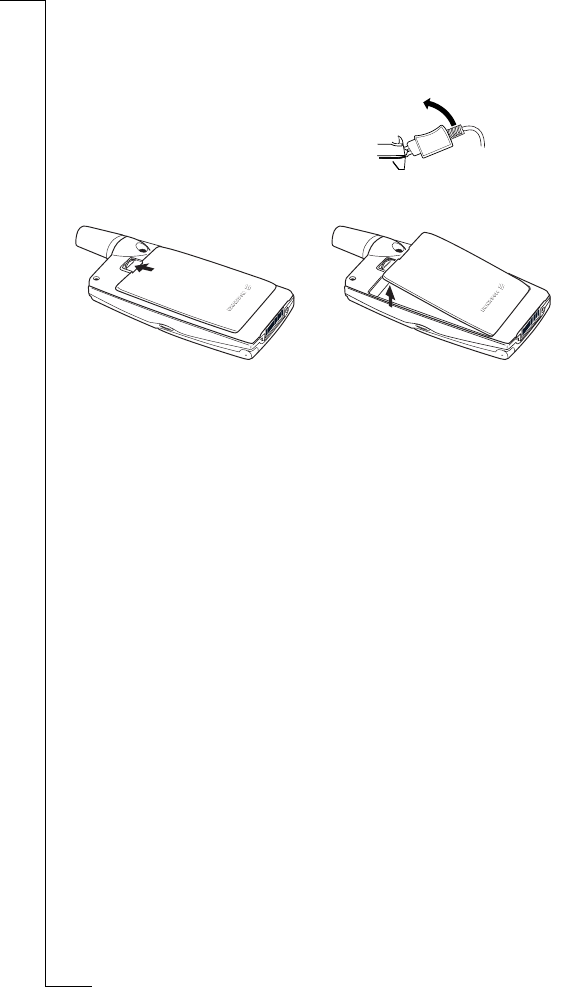
8 Preparing Your Phone for Use
When the battery is fully charged, the battery meter in the display is full and
the indicator on the top of the phone shows a steady green light.
Disconnecting the Charger
Removing the Battery
•Disconnect the charger from the phone by
moving the plug upwards.
2. Lift the battery away from the
phone.
1. Slide the release catch upwards.
Marianne.book Page 8 Friday, October 1, 1999 2:00 PM

Turning Your Phone On and Off 9
Turning Your Phone On
and Off
1. Open the flip by pressing the flip release button on the right side of the
phone.
2. Press and hold the NO key until you hear a tone.
If “PIN:” Appears in the Display
Some SIM cards are protected with a PIN code. If
PIN:
appears in the display
after you have turned on the phone:
1. Enter your PIN. If you make a mistake while entering your PIN, erase the
wrong number by pressing the C key.
2. Press YES.
Note! If your PIN is entered incorrectly three times in a row, the SIM card is
blocked. You can unblock it by using your PUK. See “The SIM Card Lock” on
page 58.
If ‘Phone locked’ appears in the display, enter your phone lock code. See
“The Phone Lock” on page 59.
Network Search
After you have turned on the phone (and entered your PIN), the phone
searches for a network.
When a network is found, the phone beeps three times. The indicator light on
top of the phone flashes green once every second and your network operator’s
name (in most cases abbreviated) appears in the display.
This is called standby mode. You can now make and receive calls.
Note! See “Error Messages” on page 106, if you do not reach standby.
TURNING YOUR PHONE ON
Marianne.book Page 9 Friday, October 1, 1999 2:00 PM

10 Turning Your Phone On and Off
The first time you turn on your phone, you may want to choose the ring signal
type and set the clock and date. For more information about these and other
settings, see “Personalizing Your Phone” on page 39.
Display Language
Most modern SIM cards automatically set the display language to the lan-
guage of the country where you bought your SIM card, (
Automatic
). If this is
not the case, the preset language is
English
. To change the display language, see
“Display Language” on page 43.
If your phone shows a language that you do not understand, you can change it
to
Automatic
, or
English
, in the following ways:
To change the display language to Automatic
1. If not in standby mode, press and hold the NO key to go to standby.
2. Press the ç arrow key.
3. Enter 8888.
4. Press the é arrow key.
To change the display language to English
1. If not in standby mode, press and hold the NO key to go to standby.
2. Press the ç arrow key.
3. Enter 0000.
4. Press the é arrow key.
•In standby mode, press and hold the NO key until you hear a tone.
INITIAL SETTINGS
TURNING YOUR PHONE OFF
Marianne.book Page 10 Friday, October 1, 1999 2:00 PM
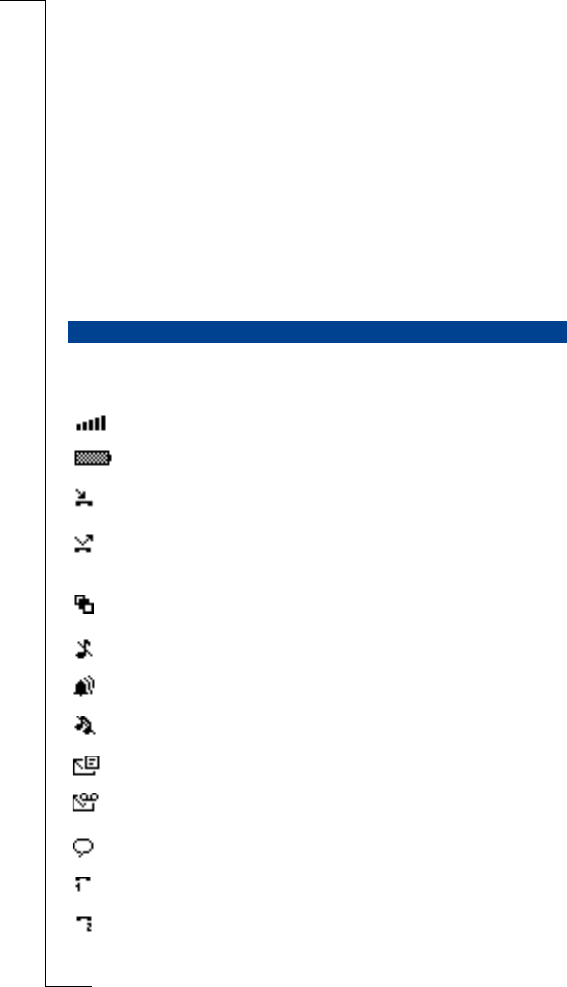
Display Information and Key Functions 11
Display Information and
Key Functions
In standby mode, the display shows the name of your operator, the time, the
signal strength and the battery power. Other icons appear if you receive any
messages, divert all your incoming calls, set the alarm clock and so on.
In this chapter, you will also learn about the key functions.
The table below shows and explains each icon which may appear in standby.
DISPLAY INFORMATION
Icon Name Explanation
Signal strength meter Tells you the strength of the network
signal.
Battery meter Tells you the status of the battery.
Missed call
indicator You have missed an incoming call.
Divert indicator
Accept Some/None
indicator
All incoming calls will be diverted to a
defined number.
No calls or only certain calls from num-
bers in a list are received.
Profile indicator Another profile than Normal has been
chosen.
Ring signal off
indicator No sound can be heard when you
receive a call.
Alarm indicator The alarm clock has been set and is on.
Silent indicator All audible signals are turned off, except
the alarm and timer.
SMS indicator You have received a text message.
Voice mail indicator You have received a voice message,
depending on your subscription.
Voice label in phone
indicator Indicates that voice dialling is set to
Start on Flip.
Line 1 indicator Line 1 is in use for outgoing calls – if
you subscribe to the Two Line Service
Line 2 indicator Line 2 is in use – if you subscribe to the
Two Line Service.
Marianne.book Page 11 Friday, October 1, 1999 2:00 PM

12 Display Information and Key Functions
Note! Each menu has got its own symbol. See “Menu Graphics” on page 21.
The table below explains the key functions.
Note! For information about the key functions in the menus, see “Moving
through the Menus” on page 23.
Ciphering indicator Ciphering is currently not being
provided by the network.
Home zone indicator You are in your home zone.
Does not appear on all networks.
KEY FUNCTIONS
Key Use
Flip release button To open the flip and answer incoming calls.
(To end a call, close the flip.)
YES To make calls and answer calls.
To voice dial, press and hold the key.
To enter the Call List from standby.
To choose a menu, sub-menu or setting.
NO To turn the phone on or off, press and hold the key in
standby.
To end a call.
To reject a call.
To go back one level in the menus, to exit a setting or to
leave a setting unchanged.
To get back to standby mode, press and hold the key.
ç and é To enter the menu system.
To move (scroll) through menus, lists and text.
C (Clear) To erase numbers and letters from the display.
To mute the microphone during a call, press and hold
down the key.
To set the phone silent, press and hold the key from
standby.
To delete an item from a list.
Number keys To enter the digits 0-9.
The 0 key enters the international prefix (+) if held down.
To call your Voice Mail, press and hold the 1 key.
To enter the phone book, press and hold any of the
numbers 2-9.
To move through menus using shortcuts.
To enter letters, for example when writing an SMS.
ûTo enter *.
To shift between upper- and lower-case letters.
# (Hash) To enter #.
Volume key
upwards and
downwards
To increase or decrease the volume of the earpiece or
handsfree loudspeaker during a call.
To reject an incoming call, quickly slide the key twice.
To voice dial, slide and hold the key when the flip is open
To move through the menus.
To open the flip without answering a call, slide and hold
the key while pressing the flip release button.
To enter the Status menu.
Marianne.book Page 12 Friday, October 1, 1999 2:00 PM
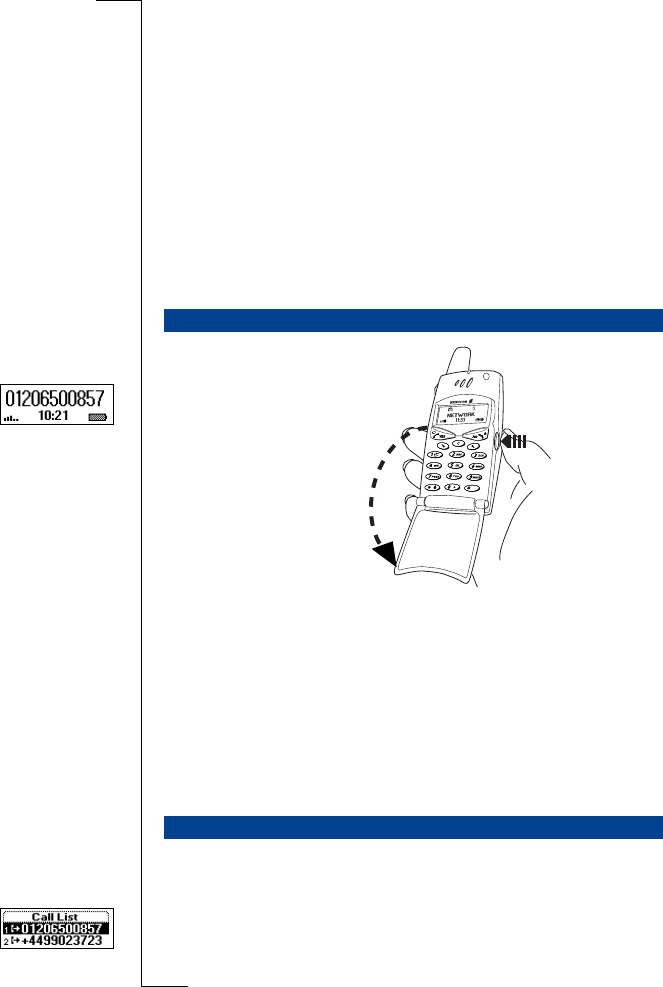
Making and Receiving Calls 13
Making and Receiving
Calls
In this chapter, we assume that you have turned on your phone and that you
are within range of a network. If you are abroad, you may use other networks,
provided your home network has an agreement that allows you to do this. See
“Setting Network Preferences” on page 70.
Note! Some countries may not use area codes.
While a call is in progress, a time counter automatically starts and you can see
how long you have been on the phone. If your network and subscription sup-
ports it, you see the cost of the call in the display. See “Knowing the Call
Time/Call Cost” on page 73.
Ending a Call
•Close the flip or press NO to end the call.
In the Call List you find numbers that you have dialled, answered or missed.
To re-dial a previously called number
1. Press YES to enter the Call List.
2. Press ç or é to choose the number you want to call.
3. Press YES to make the call.
MAKING A CALL
RE-DIALLING A PREVIOUSLY CALLED NUMBER
1
.Open the flip by pressing
the flip release button.
2
.Enter the area code and
phone number.
3
.Press YES.
Marianne.book Page 13 Friday, October 1, 1999 2:00 PM
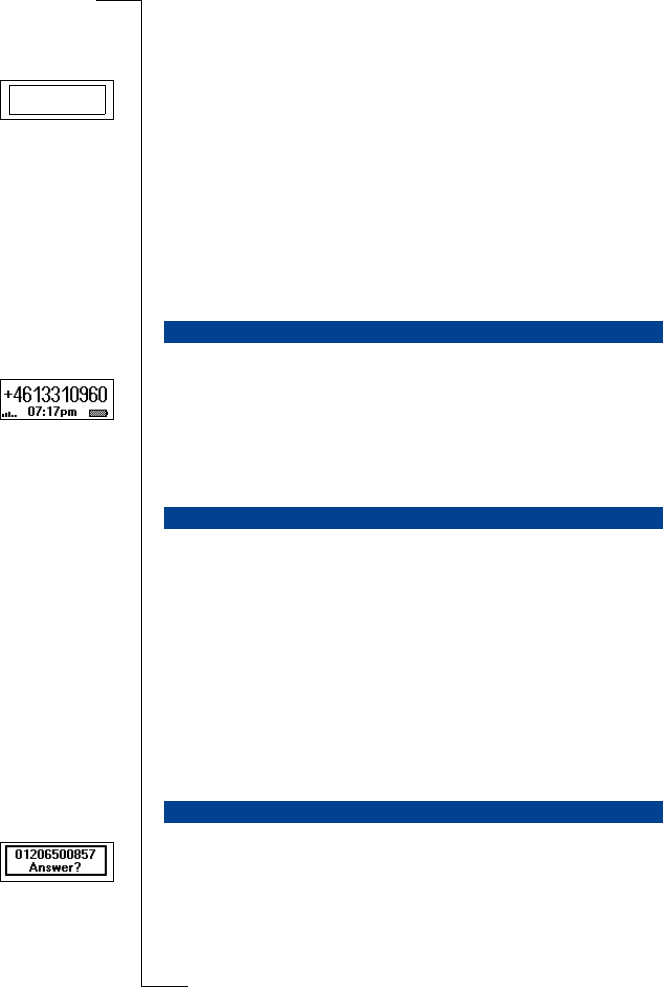
14 Making and Receiving Calls
For more information, see “Using the Call List” on page 35.
Automatic Re-Dialling
If the connection failed when you first called and the display shows
Retry?
,
you can re-dial the number by pressing YES. Your phone automatically re-
dials (up to 10 times)
•until the call is answered. When the call is successfully connected, you
hear a ring signal.
•until you press a key or receive a call.
Note! You do not need to take the phone to your ear until you hear the ring
signal.
Automatic re-dialling is not available for fax and data calls.
1. Press and hold the 0 key until a + sign appears.
The + replaces the international prefix number of the country from which
you are calling.
2. Enter the country code, area code (without the leading zero) and phone
number.
3. Press YES.
1. Enter 112 (the international emergency number, or in the Americas 911).
2. Press YES.
The international emergency number 112 (or 911) can normally be used in any
country, with or without a SIM card inserted, if a GSM network is within
range.
Note! Some network operators may require that a SIM card is inserted, and in
some cases that the PIN code has been entered as well.
Some networks may not use the international emergency number 112 (or 911).
911 can also be used in areas that use 112 as the international emergency
number, and vice versa.
When you receive a call, the phone rings and the display shows Answer?
If your subscription includes the Calling Line Identification (CLI) service and
the caller’s network sends the number, you see the caller’s number in the dis-
play. If the caller’s number and name are stored in the phone book, the caller’s
name is also shown.
MAKING INTERNATIONAL CALLS
MAKING EMERGENCY CALLS
RECEIVING A CALL
User busy
Retry?
Marianne.book Page 14 Friday, October 1, 1999 2:00 PM

Making and Receiving Calls 15
If the incoming call is a restricted number, the display shows Withheld. If the
incoming call is a number without any CLI service, Unknown is shown.
Answering a Call
Rejecting a Call
•Slide the volume key on the side of the phone twice.
The display shows
Busy tone
. The caller hears a busy tone if this is sup-
ported by the caller’s subscription. If Divert When Busy is on, the call is
diverted to the number you have specified. See “Diverting Incoming
Calls” on page 56.
Note! To open the flip without answering a call, you need to slide the volume
key while opening the flip. Then you may reject a call by pressing NO or by
closing the flip.
Ciphering is a built-in feature that scrambles your calls and messages to pro-
vide additional privacy.
An exclamation mark is shown in the display to indicate that ciphering is cur-
rently not being provided by the network.
CIPHERING
•Open the flip by pressing
the flip release button or
press YES if the flip is
open.
Busy tone
Marianne.book Page 15 Friday, October 1, 1999 2:00 PM
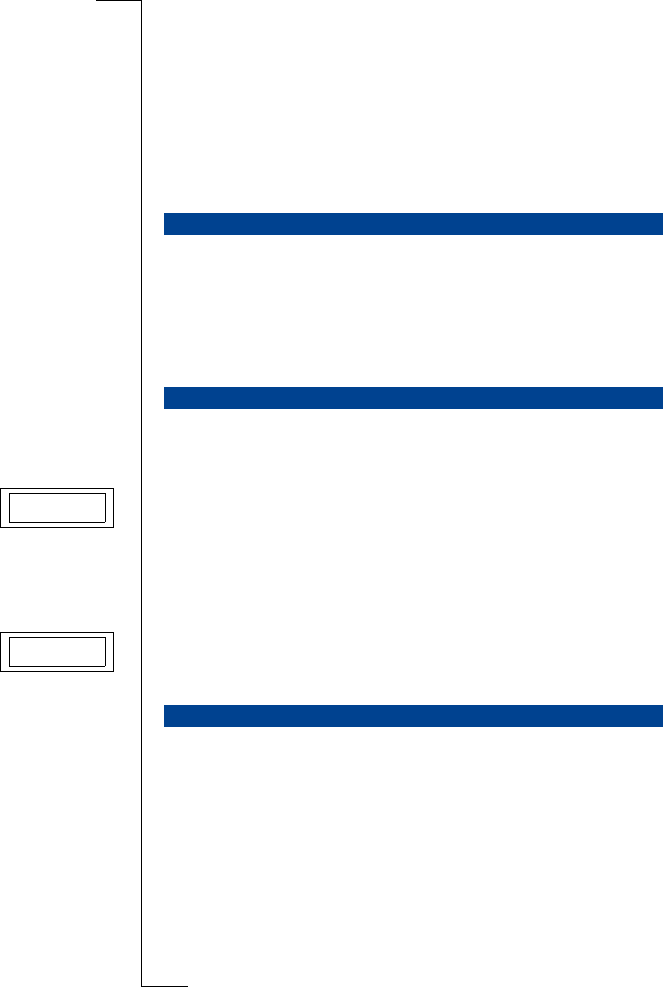
16 During a Call
During a Call
Your phone has several functions, which you might find helpful while a call is
in progress.
You can easily change the listening volume during a call by sliding the vol-
ume key on the side of the phone.
To change the listening volume during a call
•Slide upwards to increase the volume.
•Slide downwards to decrease the volume.
If you wish, you may turn the microphone off during a call.
To turn the microphone off temporarily during a call
1. Press and hold down the C key.
Muted
appears in the display.
2. To continue your conversation, release the C key.
Tip! Instead of pressing and holding the C key, you can put the call on hold.
To put a call on hold
1. Press YES.
Call held
appears in the display.
2. To continue your conversation, press YES again.
To use telephone banking services or to control an answering machine, you
need to use codes. These codes are sent as tone signals (also known as DTMF
tones or touch tones). With your mobile phone, you may use these codes dur-
ing a call. If you press 0-9, * and # during a call, these numbers and charac-
ters are sent as tone signals.
Tip! You can also save codes only or codes together with a phone number in
your Phone Book. See “Telephone Banking Services” on page 32. However, it
may be a risk to save your codes in the phone in case it is stolen.
CHANGING THE LISTENING VOLUME
MUTING THE MICROPHONE
SENDING TONE SIGNALS
Muted
Call held
Marianne.book Page 16 Friday, October 1, 1999 2:00 PM
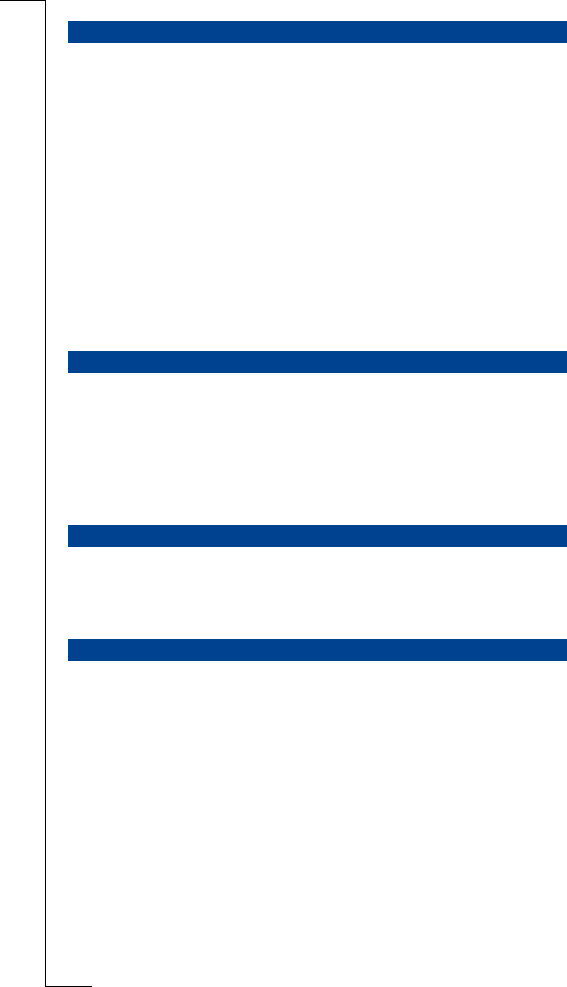
During a Call 17
If you want to make a note of a phone number during a call, you can use your
phone display as a notepad.
To use the notepad during a call
•Use the number keys to enter the number.
When you end the call, the number remains in the display or, if Ask to Save is
on, you will be asked to save the number in your phone book. You can also
find the number in Add Number in the Phone Book menu. See “Your Per-
sonal Phone Book” on page 27.
When you enter the number, the person you are talking to will hear the tones.
If you wish, you may turn the tones off during a call. See “Turn off Tones” on
page 42.
During a call, the display normally shows the duration in minutes and sec-
onds. Depending on your subscription, you may see the call cost displayed
instead.
Note! This depends on your network and SIM subscription. See “Knowing the
Call Time/Call Cost” on page 73.
If you turn on the minute minder, you hear a beep once every minute during a
call as a reminder of the duration of the ongoing call. See “Minute Minder” on
page 42.
Your phone is capable of handling more than one call simultaneously. You can
put the current call on hold and then make or answer a second call. You can
also set up a conference call with up to five people. See “Handling More than
One Call Simultaneously” on page 65.
THE NOTEPAD
CHECKING THE DURATION OR COST OF THE CALL
MINUTE MINDER
MORE THAN ONE CALL SIMULTANEOUSLY
Marianne.book Page 17 Friday, October 1, 1999 2:00 PM

18 During a Call
Marianne.book Page 18 Friday, October 1, 1999 2:00 PM

T28 WORLD Features 20
Using the Menus 21
Your Personal Phone Book 27
Using the Call List 35
Your Voice Mail Service 37
Personalizing Your Phone 39
Sending and Receiving Text Messages (SMS) 46
Diverting Incoming Calls 56
Security for Your Phone and Subscription 58
Handling More than One Call Simultaneously 65
Setting Network Preferences 70
Knowing the Call Time/Call Cost 73
Using Two Voice Lines 75
Voice Control 76
Calling Card Calls 79
Sending and Receiving Fax and Data Calls 82
Extras 84
The Profile Concept 88
Accessories 91
Online Services 99
FUNCTIONS AND SETTINGS
Marianne.book Page 19 Friday, October 1, 1999 2:00 PM

20 T28 WORLD Features
T28 WORLD Features
Your T28 WORLD is a small new generation phone: a Dual Band (GSM900/
1900) phone with a lithium battery; a phone of modern design and advanced
technology.
The active flip makes it possible for you to answer by just opening the flip. Or
why not use the Voice Control and say ‘Answer’ to answer a call or ‘Busy’ if
you wish to reject the call. You can also call a person by simply saying the
name.
The T28 WORLD has a ‘Profile’ feature which makes it possible for you to
change a few settings by just choosing a certain Profile, since each profile
includes a group of settings preset to suit a certain environment. For example,
when you go to a meeting, you can just choose the ‘Meeting’ profile and a
number of settings that suit a meeting are then set automatically.
The Profiles are also related to intelligent accessories such as a desktop
charger, a portable or vehicle handsfree. For example, you may place the T28
WORLD in a vehicle handsfree kit and the ‘In Car’ profile is chosen automat-
ically.
In the display of the T28 WORLD you can see a mixture of text and symbols,
which makes it easier for you to move through the menus when you want to
change a certain setting, turn on the Vibrating Alert, send a message, save a
number and so on.
An extra feature is the numbered shortcuts, which takes you to a certain
setting quickly and easily. You may also create your own favourite menu, ‘My
Shortcuts’, by including the settings you use most often. If you should need
help using the menus, the T28 WORLD is equipped with help texts to guide
you.
Marianne.book Page 20 Friday, October 1, 1999 2:00 PM
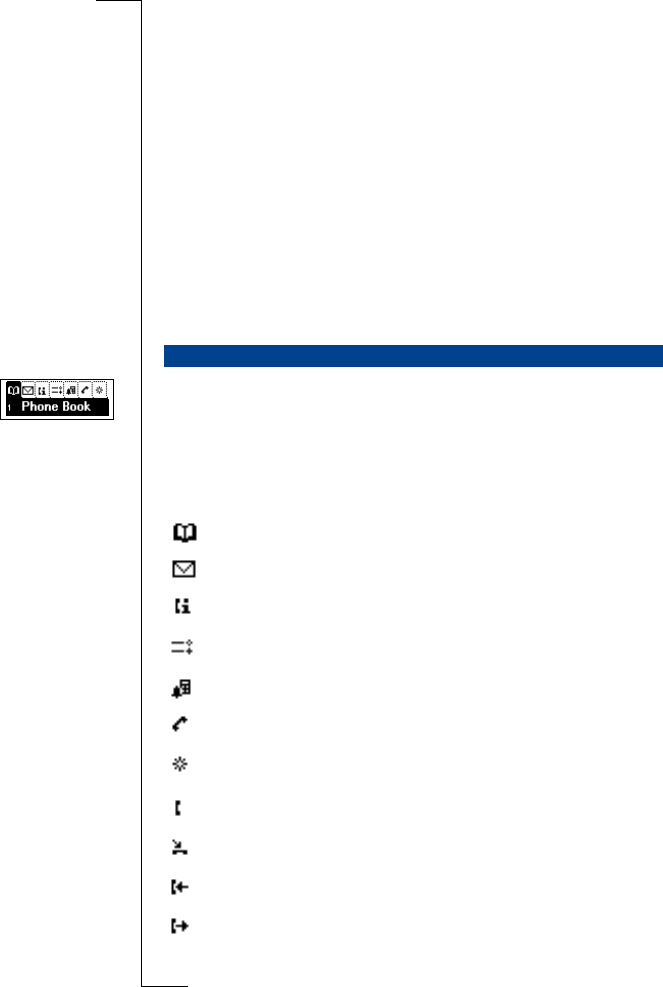
Using the Menus 21
Using the Menus
You can find all your phone functions in the menus. You use the menus every
time you want to change a setting in your phone, such as the ring signal. You
also use the menus to get the most out of your phone: to set the alarm clock,
send text messages, save important phone numbers, etc.
The menus are arranged in a loop, which you enter and move (scroll) through
with the ç and é keys or by using shortcuts. Each menu contains a list
of options. Some menus have sub-menus with additional options.
You enter the menus by pressing ç or é. At the top of the display, there
are icons symbolizing each menu. Besides these, there are symbols within the
sub-menus indicating missed calls, help texts, voice labels etc.
The table below illustrates and explains each menu icon and symbol.
MENU GRAPHICS
Symbol Name Description
Phone Book menu Your personal phone book.
Messages menu Handling of text and voice messages.
Call Info menu Call time and call cost information.
Settings menu Personal settings and profiles.
Extras menu Games, alarm clock and other extras.
Call Handling menu Handling of ongoing calls.
My Shortcuts menu A selection of your most frequently used
functions.
Ongoing call
indicator You have an ongoing call.
Missed calls
indicator Indicates a missed call in the call list, in
the missed calls list and in standby.
Answered call
indicator Indicates an answered call in the call list.
Dialled number
indicator Indicates a dialled number in the call list.
Marianne.book Page 21 Friday, October 1, 1999 2:00 PM

22 Using the Menus
Phone memory
indicator Indicates that a phone book entry is
saved in the phone memory and the SIM
memory is full.
Group indicator Indicates that a phone book entry is a
group.
Unread SMS
indicator Indicates that a text message has not
been read.
Unchecked Voice
Mail Indicates that a voice message has not
been checked.
Phone book
look up indicator Indicates that you can enter the phone
book by pressing ç.
SIM card memory
indicator Indicates that a phone book entry is
saved in the SIM card memory.
Voice label in phone
indicator Indicates that a voice label has been
recorded for an entry in the phone only.
Indicates that voice dialling is set to Start
on Flip.
Voice label in car
indicator Indicates that a voice label has been
recorded for an entry in the car handsfree
kit.
Voice label in phone
and in car indicator Indicates that a voice label has been
recorded for an entry in the phone and in
the car handsfree kit.
Preferred network
indicator Indicates that a network is preferred and
can be used.
Forbidden network
indicator Indicates that a network is forbidden and
cannot be used.
Home zone
indicator Indicates that you are in your home zone.
Does not appear on all networks.
Help text indicator Indicates a help text.
Lock indicator Indicates that the card lock or phone lock
is on.
Symbol Name Description
Marianne.book Page 22 Friday, October 1, 1999 2:00 PM

Using the Menus 23
There are two ways of moving through the menus:
•scrolling with ç or é
•using shortcuts
Scrolling by Using ç or é
Note! For information about how to enter letters, see “Entering Letters” on
page 28.
Tip! Once in the menu system, you can press and hold the ç or é key or
slide and hold the volume key until you reach the menu or sub-menu that you
want instead of pressing the ç or é key repeatedly.
Using Shortcuts
A quicker way to move through the menus is to use the shortcuts. You simply
enter the number of the menu or sub-menu to which you want to go, but you
first need to enter the menus by pressing ç or é. To get back to standby,
you press and hold NO as normal.
Tip! A quicker way to enter the ‘Find and Call’ function is to press and hold
é. A quicker way to enter the first sub-menu in the ‘My Shortcuts’ menu is
to press and hold ç.
Note! Your phone may not have all the menu alternatives described in this
manual since many of them are network- and subscription-dependent.
Because of this, the shortcut numbers may vary between phones.
In the instructions in this manual we use the ç and é keys to describe
the functions and settings, since the shortcut numbers may vary between
phones due to your subscription and network.
The following instruction tells you how to set the key sound to ‘Tone’.
MOVING THROUGH THE MENUS
Press... to...
ìscroll left or up through menus or functions.
îscroll right or down through menus or functions.
YES select a menu, sub-menu or setting.
NO go back one level in the menu system, exit a setting or
leave a setting unchanged.
go back to standby mode by pressing and holding the
key.
Cdelete an item from a list.
HOW TO INTERPRET THE INSTRUCTIONS
Marianne.book Page 23 Friday, October 1, 1999 2:00 PM

24 Using the Menus
To set the key sound
1. Scroll to
Settings
, YES,
Sounds & Alerts
, YES,
Key Sound
, YES.
2. Select
Tone
.
Interpret the instruction as follows:
1. From the standby mode, use é or ç to scroll to the
Settings
menu.
2. Press YES to select the menu.
Now you are in the
Settings
menu.
The name of the menu that you have chosen is shown at the top of the
display (
Settings
).
3. Press YES to select the
Sounds & Alerts
sub-menu.
(You do not need to scroll with the arrow keys since this is the first sub-
menu in the main menu
Settings
).
4. Use é or ç to scroll to the
Key Sound
sub-menu.
Press YES to select the sub-menu.
5. Use é or ç to scroll to
Tone
.
Press YES to select the
Tone
alternative.
Now you have set the key sound to ‘Tone’.
To go back to standby mode, press and hold the NO key.
This is how to interpret the same instruction as above when using shortcuts:
To set the key sound
1. Press é or ç to enter the menu system.
2. Press 4 to select the
Settings
menu.
3. Press 1 to select the
Sounds & Alerts
sub-menu.
4. Press 5 to select the
Key Sound
sub-menu.
5. Select
Tone
.
When you move through the menu system, the display changes. The following
hints can help you:
•Black text within a frame at the top indicates the menu you have chosen.
•Inverted text on a black layer indicates your position in the menu system.
If you press YES you enter this menu or select this setting.
•Grey text indicates a function that is temporarily unavailable, for example
due to your subscription or due to a certain setting which is not on.
•Text marked with a tick indicates the current setting or settings selected.
•Text marked with a filled button indicates the current setting selected.
Note! Most sub-menus in the ‘Call Handling’ menu are shown in grey text
when no call is active. However, they are shown in black text during a call.
DISPLAY TEXT
Marianne.book Page 24 Friday, October 1, 1999 2:00 PM

Using the Menus 25
You can place your favourite settings in the menu My Shortcuts. In this way,
you can quickly and easily reach the settings you use most.
When you buy your phone, My Shortcuts contains a few settings which you
can remove if you wish. You can also add a setting from another menu to My
Shortcuts.
To add a setting to My Shortcuts
1. Scroll to
My Shortcuts
, YES,
Edit Shortcuts
, YES.
2. Select a setting from the list by pressing *.
3. Enter the position number you want for your setting in this menu.
4. Press YES.
If you want to add another setting, repeat steps 2 and 3.
To remove a setting from
My Shortcuts
, repeat steps 1 and 2.
5. Press YES to exit the list.
Tip! A quicker way to enter the first sub-menu in the ‘My Shortcuts’ menu is
to press and hold ç.
To help you use the functions and settings of the menus, your phone includes
pop-up help texts that explain the sub-menus.
These help texts are set to On when you buy your phone, but you may turn
them off at any time.
To turn the help texts on or off
1. Scroll to
Settings
, YES,
Display
, YES,
Help Functions
, YES,
Menu Help
, YES.
2. Select
On
or
Off
.
MY SHORTCUTS
HELP TEXTS
Marianne.book Page 25 Friday, October 1, 1999 2:00 PM

26 Using the Menus
Find and Call
Find and Send*
Add Number
Find and Edit
Voice Labels
Delete All
Groups
Email Addresses
Calling Cards
Options
Memory Status
Fixed Numbers
Info Numbers
ServiceNumbers
Call Voicemail
Inbox
Send New
Unsent
Templates
Sent Items
Options
Alarm Clock
Timer
Stopwatch
Calculator
Games
Accessories
Sounds & Alerts
Profiles
Call Options
Networks
Display
Language
Time and Date
Locks
Voice Control
Handsfree
Master Reset
Switch to Line 1
Next Incoming
Show MyNumber
Hide My Number
Turn off Tones*
Hold Call*
Switch Calls*
Release Active*
Retrieve Call*
Join Calls*
Transfer Call*
Extract Part*
Release All*
Select Profile
Ring Volume
Switch to Line 1
Edit Shortcuts
Please note that many of the menu alternatives
are network- and subscription-dependent.
* Only available during a call.
Missed Calls
Call List
Last Call
Credit
Total Cost
Tariff
Total Time
Outgoing Time
Clear Call List
Reset
Counters
Options
Note! The default display language is English.
The English display texts may differ from the US
English texts.
Marianne.book Page 26 Friday, October 1, 1999 2:00 PM

Your Personal Phone Book 27
Your Personal
Phone Book
You can create a personal phone book by saving phone numbers and accom-
panying names (an entry). An easy way to make calls is by recalling the phone
numbers or names saved in your phone book.
Before you start creating your personal phone book, there are a few things you
need to know. You need to learn about the memories, how to save the numbers
with the international (+) sign and how to enter letters.
Phone Book Memories
You can save phone numbers and names in:
•the card memory on the SIM card
•the phone memory
Your entries are first saved in the positions on your SIM card. The actual
number of memory positions available depends on your SIM card.
Saving your numbers in the card memory allows you to use the numbers
saved on the SIM card even when you change phones, i.e. when you insert
your SIM card into another phone.
By saving your numbers in the phone memory, they are always available to
you in your phone, even if you change SIM cards. The phone memory holds
99 positions in which your entries are saved when all SIM positions are
occupied.
International Numbers
If you intend to use your phone both at home and abroad, it is a good idea to
save all phone numbers as international phone numbers, i.e. with the (+) sign,
(which automatically replaces the international dialling prefix for the country
you are calling from) followed by the country code, the area code and the
phone number.
CREATING A PERSONAL PHONE BOOK
Marianne.book Page 27 Friday, October 1, 1999 2:00 PM

28 Your Personal Phone Book
To enter an international phone number
•Press and hold 0 to enter the + sign.
Exclude the leading zero in the area code.
You can enter letters when you use the phone book and when you compose a
short message (SMS). See “Sending and Receiving Text Messages (SMS)” on
page 46.
Press the appropriate key, 1–9, 0 or #, repeatedly until the character you want
appears in the display.
Example:
•To enter an ‘A’, press 2 once.
•To enter a ‘B’, quickly press 2 twice.
•To enter lower-case letters, enter the letter, for example an ‘A’, and then
press *. An ‘a’ appears. Lower-case letters now appear until you press *
again.
•To enter numbers, press and hold any number key.
•To delete letters and numbers, press the C key.
You may also use the volume key as a shortcut to certain letters:
•To enter a ‘B’, slide the volume key upwards and press 2.
•To enter a ‘C’, slide the volume key downwards and press 2.
Tip! You can choose another alphabet by pressing and holding #.
ENTERING LETTERS
Press… to get…
1 Space - ? ! ‚ . : ; " ’ < = > ( ) 1
2 A B C Å Ä Æ à Ç 2 Γ
3 D E F è É 3 ∆ Φ
4 G H I ì 4
5J K L 5 Λ
6 M N O Ñ Ö Ø ò 6
7P Q R S ß 7 Π Σ
8 T U V Ü ù 8
9 W X Y Z 9
0 + & @ / ¤ % $ £ ¥ § ¿ ¡ 0 Θ Ξ Ψ Ω
## * ↵
Marianne.book Page 28 Friday, October 1, 1999 2:00 PM
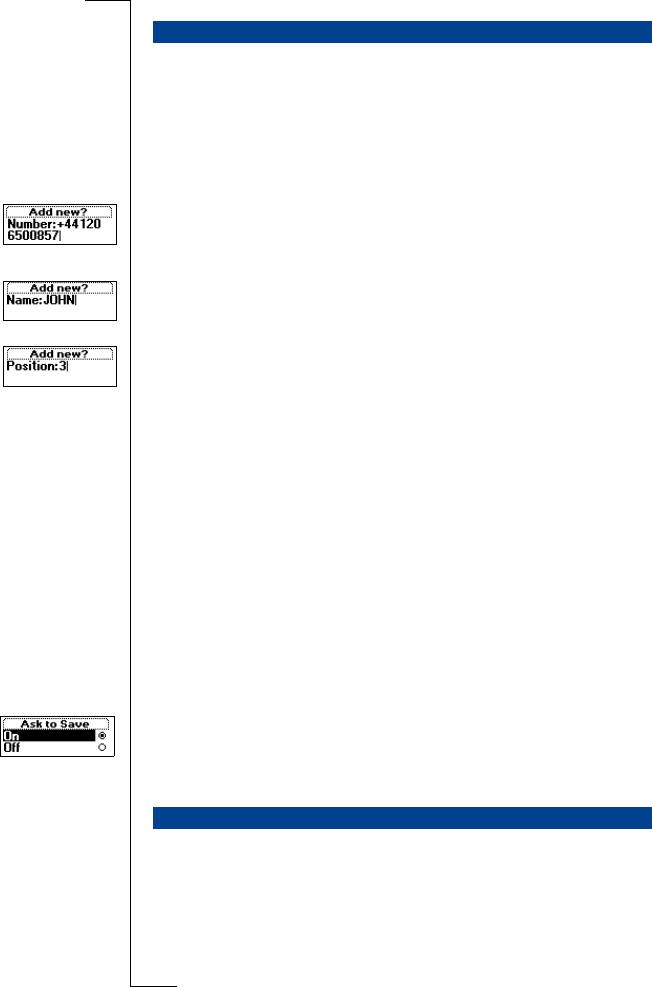
Your Personal Phone Book 29
Every phone number that you save gets a position number. You can save the
phone numbers together with a name to make it easier for you to keep track of
your phone numbers.
To save a number together with a name
1. Scroll to
Phone Book
, YES,
Add Number
, YES.
A list of numbers used but not saved appears.
2. Select
Add New?
or any of the numbers from the list by pressing YES.
3. Enter a phone number that you wish to save (including the (+) sign and the
country code) and press YES.
4. Enter a name that you want to associate with the phone number and press
YES.
5. You now have three options:
•To save the number in the suggested first empty position, press YES.
•To save the number in another position, press C to erase the position
number, enter a new position number and press YES.
•To save the number in the phone memory, you need to know how many
positions you have got on your SIM card. You can check this in
Memory Status in the Phone Book menu. If, for example, you have
200 positions on your SIM, you can enter position number 201 to save
a number in the phone memory.
If you have turned Voice Dialling on, you are asked if you want to add a voice
label to your phone book entry. See “Voice Control” on page 76.
Ask to Save
If you wish to be asked to save any dialled or answered number that is not
already saved in your phone book, you can turn on the Ask to Save option.
To turn the Ask to Save function on or off
1. Scroll to
Settings
, YES,
Display
, YES,
Help Functions
, YES,
Ask to Save
, YES.
2. Select
On
or
Off
.
Note! Your subscription must support the Calling Line Identification service.
You can either call a number by using the name saved with it or you can call
the number by using the position number that it was saved in.
The order of searching for names and numbers depends on the sort order you
have chosen, i.e. by name or by position.
SAVING A NUMBER TOGETHER WITH A NAME
CALLING A NUMBER SAVED IN THE PHONE BOOK
Marianne.book Page 29 Friday, October 1, 1999 2:00 PM
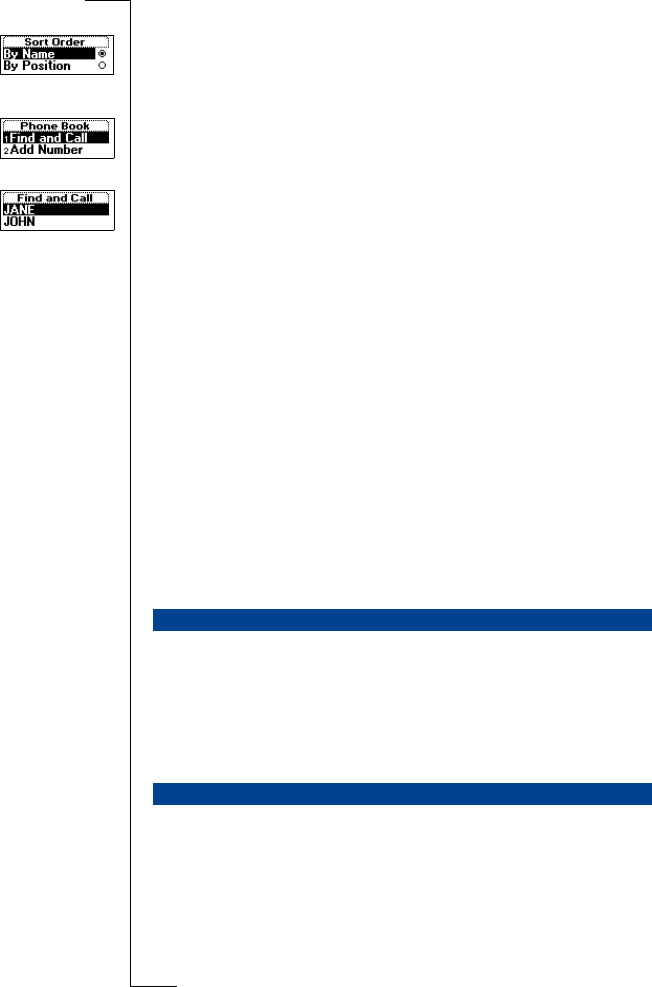
30 Your Personal Phone Book
To choose a sort order
1. Scroll to
Phone Book
, YES,
Options
, YES,
Sort Order
, YES.
2. Select a sort order.
To call a number saved in the phone book
1. Scroll to
Phone Book
, YES,
Find and Call
, YES.
2. Enter the position number or the name (or the first few letters of the name)
associated with the number that you want to call.
3. Press YES.
If the name displayed is not the one you want, press ç or é until you
find the correct name and number.
4. Press YES to make the call.
Tip! A quicker way to enter the ‘Find and Call’ function is to press and hold
é
.
Shortcuts to Phone Book Entries
When in standby, you can find an entry by:
•entering the position number followed by #.
•pressing and holding one of the keys 2-9 to find an entry beginning with a
specific letter.
For example, pressing and holding 2 takes you to the first entry beginning
with the letter A (or closest following).
Once you are in the list of phone book entries you can use ç or é to
scroll through the positions, or enter a position number or a letter to go to a
certain entry.
You can call the phone numbers that you have saved in positions 1–9 in the
memory by entering the position number and then pressing YES.
Example:
1. Enter the number 3.
2. Press YES to make the call.
You may need to change the names and numbers in the phone book from time
to time. You may also want to change the position number of an entry.
Editing a Phone Number In the Phone Book
You need to find the phone book entry that you wish to edit. You can use
either the stored position or the name. See “Calling a Number Saved In the
Phone Book” on page 29.
SPEED DIALLING
KEEPING THE PHONE BOOK UP TO DATE
Marianne.book Page 30 Friday, October 1, 1999 2:00 PM
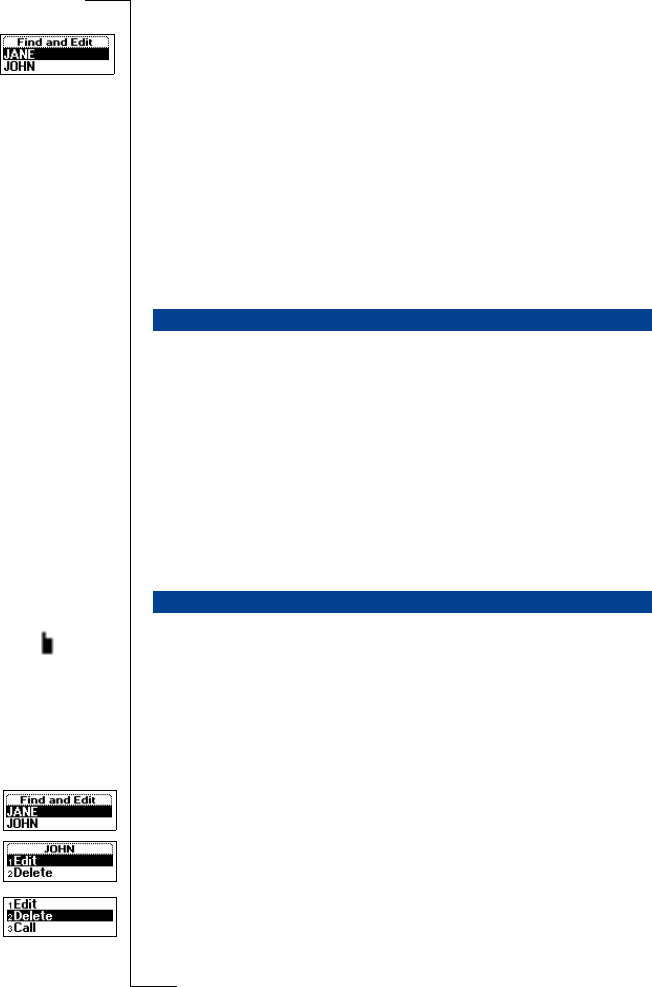
Your Personal Phone Book 31
To edit an entry
1. Scroll to
Phone Book
, YES,
Find and Edit
, YES.
2. Enter the position number or the name of the entry that you wish to edit.
Press YES.
If the name displayed is not the one you want, press ç or é until you
find the correct name and number.
3. Press YES to select the entry.
4. Select
Edit
.
5. Edit the number and press YES.
Use the ç or é keys to move the cursor. Use the C key to delete.
6. Edit the name and press YES.
7. Edit the position number and press YES.
If you try to save a phone number in a position which already contains a
phone number, the message
Overwrite?
appears together with the name saved in
that position. You now have two options:
To save the number in the selected position
•Press YES to replace the number with the new one.
To save the number in a different position
1. Press NO.
2. Enter the new position number.
3. Press YES to save the number in the new position.
When all SIM card positions are full, an icon appears next to the position
number, see margin. From now on your entries are stored in the phone
memory.
If all positions, including the phone memory are full, you have to delete an old
number by entering a position that is already occupied and press YES.
To delete an entry from the memory
1. Scroll to
Phone Book
, YES,
Find and Edit
, YES.
2. Enter the position number or the name of the number that you want to
delete and press YES. (This depends on the sort order, i.e. by name or by
position.)
3. Press YES.
4. Select
Delete
.
5. Press YES to confirm your choice.
OVERWRITE PROTECTION
WHEN THE CARD MEMORY IS FULL
Marianne.book Page 31 Friday, October 1, 1999 2:00 PM

32 Your Personal Phone Book
To delete all entries from the phone memory
1. Scroll to
Phone Book
, YES,
Delete All
, YES.
2. The question
Delete all in phone memory?
appears.
Press YES.
3. Enter the phone lock code (
0000
or another one that you have chosen
yourself).
All entries in the phone memory are deleted.
If you use telephone banking services, you can save the phone number of your
banking service together with your personal codes, or you can save your codes
only. You need to add a pause (
p
) between the phone number and the codes.
You insert a pause by pressing and holding the * key. Usually, a # is required
after each code. Sometimes a pause is required, too. Talk to your bank if you
are in doubt about how to use # and pause (
p
).
Note! It may be a risk to save your codes in the phone in case it is stolen.
To save a phone number with codes
1. Scroll to
Phone Book
, YES,
Add Number
, YES,
Add new?
, YES.
2. After entering the phone number, press and hold the * key until the pause
character
p
appears in the display.
3. Enter the code and #. If required, enter a pause, the next code and so on.
4. Enter the name that you want to associate with the phone number and code
and press YES.
5. Press YES to save.
If you want to save the number in a different position than the one
suggested, see “Saving a Number Together with a Name” on page 29.
To make a call with tone signal codes, proceed as described in “Calling a
Number Saved In the Phone Book” on page 29. When you make the call, the
phone dials the number, waits until the call is answered and then sends the
code. If you insert another pause and another code, it pauses again, sends the
next code and so on.
To save codes only
1. Scroll to
Phone Book
, YES,
Add Number
, YES,
Add new?
, YES.
2. Enter the code followed by a # and if required, a pause, another code and
so on.
3. Press YES.
4. Enter a name that you want to associate with your codes and press YES.
5. Press YES to save.
TELEPHONE BANKING SERVICES
Delete all in
phone memory?
Marianne.book Page 32 Friday, October 1, 1999 2:00 PM
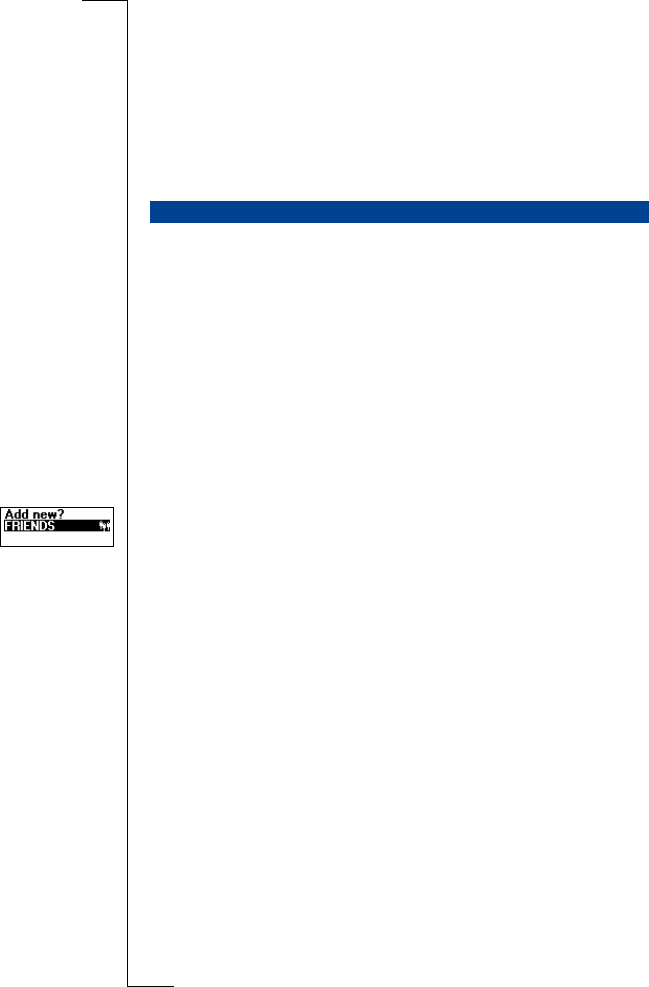
Your Personal Phone Book 33
During a call, you can retrieve these codes from the phone book and send
them.
To send the codes during a call
1. Scroll to
Phone Book
, YES,
Find and Send
, YES.
2. Enter the name (or first few letters) or position number of your codes and
press YES.
3. Press YES to send the codes.
The T28 WORLD allows you to create groups of phone book entries. In this
way you can send a text message to several recipients at the same time. See
“Sending and Receiving Text Messages (SMS)” on page 46.
To create a new group
1. Scroll to
Phone Book
, YES,
Groups
, YES,
Add new?
, YES.
2. Enter a name for the group and press YES.
3. Scroll to
Add new?
, YES.
4. Select an entry in your phone book.
5. To add the next member, press YES at
Add new?
.
To add a new member to an existing group
1. Scroll to
Phone Book
, YES,
Groups
, YES.
2. Select the group that you want to edit.
3. Scroll to
Edit
, YES,
Add new?
, YES.
4. Select an entry in your phone book.
To delete a member from a group
1. Scroll to
Phone Book
, YES,
Groups
, YES.
2. Select the group that you want to edit.
3. Select
Edit
.
4. Scroll to the member that you want to delete and press C.
5. Press YES to confirm your choice.
To delete a group
1. Scroll to
Phone Book
, YES,
Groups
, YES.
2. Select the group that you want to delete.
3. Select
Delete
.
4. Press YES to confirm your choice.
GROUPS
Marianne.book Page 33 Friday, October 1, 1999 2:00 PM
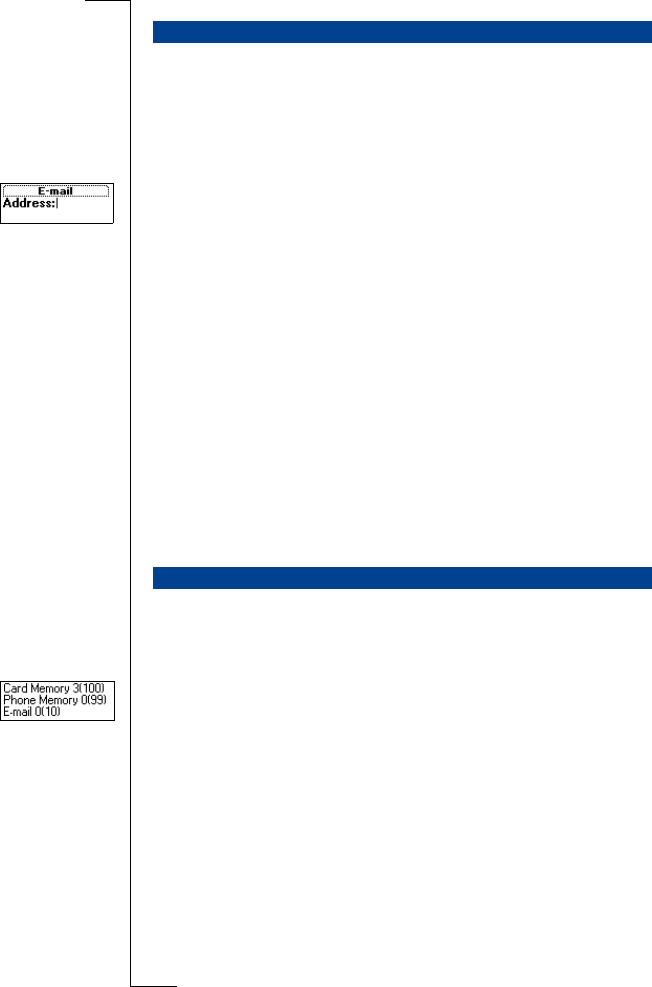
34 Your Personal Phone Book
You can save e-mail addresses to be used when you want to send a text mes-
sage as an e-mail. See “Sending and Receiving Text Messages (SMS)” on page
46. You can save 10 e-mail addresses, each consisting of 60 characters.
To save an e-mail address
1. Scroll to
Phone Book
, YES,
Email Addresses
, YES,
Add new?
, YES.
2. Enter an e-mail address and press YES.
3. Enter a name and press YES.
Tip! The @ sign is accessed by pressing the 0 key three times.
To edit an e-mail address
1. Scroll to
Phone Book
, YES,
Email Addresses
, YES.
2. Select the entry that you want to edit.
3. Select
Edit
.
4. Edit the e-mail address and press YES.
5. Edit the name and press YES.
To delete an e-mail address
1. Scroll to
Phone Book
, YES,
Email Addresses
, YES.
2. Select the entry that you want to delete.
3. Select
Delete
.
4. Press YES to confirm your choice.
The Memory Status function in your phone book lets you check how many
memory positions you have left in your memories.
To check the status of your different phone book memories
1. Scroll to
Phone Book
, YES,
Memory Status
, YES.
2. Use ç or é to scroll through the list.
E-MAIL ADDRESSES
CHECKING THE STATUS OF THE MEMORIES
Marianne.book Page 34 Friday, October 1, 1999 2:00 PM

Using the Call List 35
Using the Call List
The Call List is a phone number log that saves information (time, date, phone
number and name) about the last 30 incoming and outgoing calls. Once your
list exceeds 30 calls, the oldest one is deleted.
The numbers that you have dialled are always saved. If your subscription
includes the Calling Line Identification (CLI) service and the caller’s network
sends the number, you will also find the numbers (together with a name if
saved in your phone book) of answered and missed calls in the Call List. If
the incoming call is a restricted number, the display shows Withheld. If the
incoming call is a number without any CLI service, Unknown is shown. You
can call any of the numbers in the Call List.
All the calls are saved together in chronological order. The last call you have
made is saved in the first position. If the same number is called more than
once, the latest call replaces earlier ones. If you check a call within 24 hours,
the time of the call is displayed. Otherwise, the time is replaced by the date.
Note! If you change SIM cards or turn the Call List off, the list is cleared.
Called numbers may remain in the SIM card memory though.
To call a number from the call list
1. Scroll to
Call Info
, YES,
Call List
, YES.
2. Scroll to the number that you want to call and press YES.
Tip! Press YES when the phone is in standby mode to go directly to the call
list.
WHAT CALLS ARE SAVED?
The Call List saves:
Dialled numbers
Answered calls
Missed calls
Marianne.book Page 35 Friday, October 1, 1999 2:00 PM

36 Using the Call List
To delete a number from the call list
1. Scroll to
Call Info
, YES,
Call List
, YES.
2. Scroll to the number you want to delete and press C.
The question
Delete?
appears in the display.
3. Press YES to delete the number.
To clear the call list
1. Scroll to
Call Info
, YES,
Clear Call List
, YES.
The question
Call List Clear?
appears in the display.
2. Press YES to clear the call list.
To turn the call list on or off
1. Scroll to
Call Info
, YES,
Options
, YES,
Set Call List
, YES.
2. Select
On
or
Off
.
If you select
Off
the question
Call List Clear?
appears in the display.
3. Press YES to clear the call list.
Missed Calls
If you have missed a call, the message
Missed Calls: 1
appears in standby mode,
where the number
1
indicates the number of missed calls.
1. Press YES to display the missed calls.
2. If you wish to call a number from the Missed Calls List, press YES at the
number you want to call.
Note! You can also see the Missed Calls List in the ‘Call Info’ menu. Missed
calls are also saved in the Call List.
To be able to see if you have missed a call, the Call List must be on.
Some operators offer subscriptions where your phone number is normally
hidden. You can choose to show or hide your number for a particular call, if
Calling Line Identification Restriction service (CLIR) is supported by your
subscription.
To hide your phone number for a particular call
1. Enter the phone number you wish to call.
2. Scroll to
Call Handling
, YES,
Hide My Number,
YES
.
3. Press YES to make the call.
To show your phone number for a particular call
1. Enter the phone number you wish to call.
2. Scroll to
Call Handling
, YES,
Show MyNumber,
YES
.
3. Press YES to make the call.
SHOWING AND HIDING YOUR NUMBER
Missed calls: 1
Marianne.book Page 36 Friday, October 1, 1999 2:00 PM
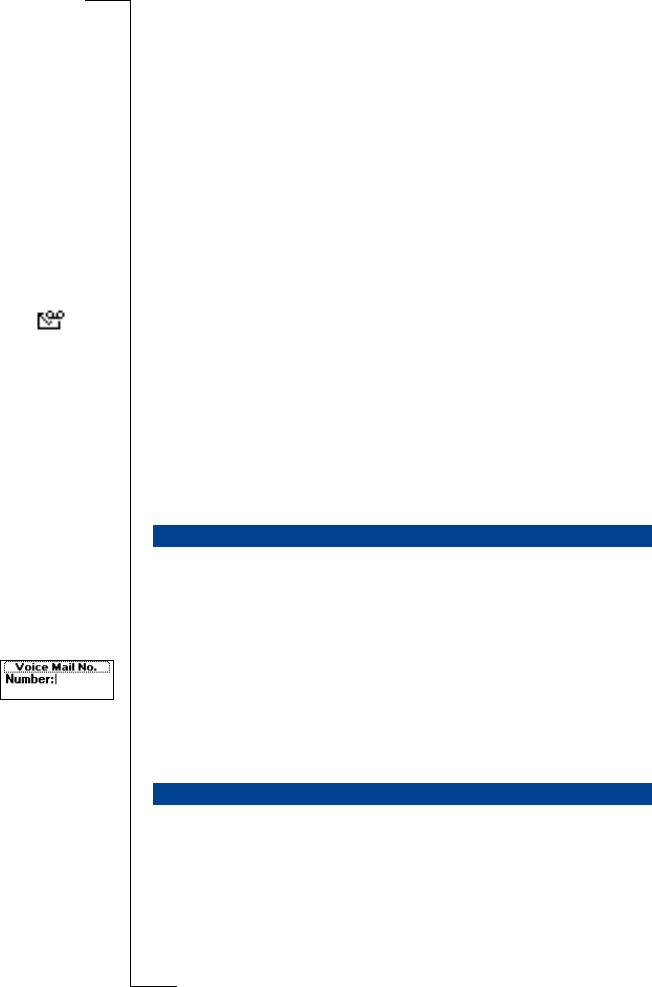
Your Voice Mail Service 37
Your Voice Mail Service
Note! This service depends on your subscription and operator.
The answering service of your network allows callers to leave a voice
message when you cannot answer your calls. Depending on your network
operator, you will be informed that you have received a voice message in dif-
ferent ways.
Some operators inform you by sending a specific Voice Mail indication. If
this is the case, the voice mail icon appears in the display.
Most operators, however, inform you by sending a text message, (i.e. an
SMS), for example asking you to call your Voice Mail Service. For more
information about receiving and reading text messages, see “Receiving a Mes-
sage” on page 50.
Note! For more information about your Voice Mail Service, please refer to the
information provided by your network operator.
If you want your phone to easily interact with your Voice Mail Service, you
can store the number to your Voice Mail Service. You will get the number in
the information provided by your network operator.
To store your Voice Mail number
1. Scroll to
Messages
, YES,
Options
, YES,
Voice Mail No.,
YES.
2. Enter your Voice Mail number and press YES.
Note! The number to your Voice Mail Service may be different if you are
calling from a network that is not your home network.
When you receive a voice mail, an alert signal sounds and the message
New
voicemail
appears in the display (only if you receive the specific voice mail
indication). If you want to check your voice mail now, press YES to call your
Voice Mail Service.
If you press NO, you can call your Voice Mail Service at a later time to listen
to your recorded messages.
COMMUNICATING WITH YOUR VOICE MAIL SERVICE
CALLING YOUR VOICE MAIL
Marianne.book Page 37 Friday, October 1, 1999 2:00 PM

38 Your Voice Mail Service
To call your Voice Mail Service
•Scroll to
Messages
, YES,
Call Voicemail
, YES.
Tip! You can also call your Voice Mail Service by pressing and holding 1
from standby.
To change your Voice Mail number
1. Scroll to
Messages
, YES,
Options
, YES,
Voice Mail No.,
YES.
2. Press and hold C to delete the existing number.
3. Enter your new Voice Mail number and press YES.
To change the message alert signal
1. Scroll to
Messages
, YES,
Options
, YES,
Message Alert
, YES.
2. Select the signal you want.
Tip! If you subscribe to the Two Line Service, you may have different Voice
Mail numbers for your two lines. You may also set different options for the two
lines. For example, you can set all incoming calls on Line 1 to be diverted to
your Voice Mail and let all incoming calls on Line 2 be connected.
Further information about your Voice Mail Service can be found in the
operating instructions supplied by your network operator.
CHANGING NUMBER AND SIGNAL
Marianne.book Page 38 Friday, October 1, 1999 2:00 PM

Personalizing Your Phone 39
Personalizing Your
Phone
You can choose to set your phone completely silent so that all signals except
the alarm and timer signals are turned off.
To set the phone silent
1. From standby, press and hold C.
2.
Silent on?
appears. Press YES.
An icon appears in standby.
To cancel, repeat step 1 and press YES at
Silent off?
.
You can set the volume in six steps. The first step means that two clicks are
heard when you receive a call. You can also turn the ring signal off (0). An
icon then appears in standby.
To set the ring signal volume
1. Scroll to
Settings
, YES,
Sounds & Alerts
, YES,
Ring Volume
, YES.
The level of the ring volume appears in the display.
2. Use ç to increase the volume, é to decrease it.
The phone rings once with the actual setting as you increase the volume.
3. Press YES to save the setting.
Tip! Use the volume key on the side of the phone to change the volume of the
ring signal silently.
You can choose a ring signal that rises in steps from the softest volume to the
loudest, Increasing Ring.
To set the ring signal to Increasing Ring
1. Scroll to
Settings
, YES,
Sounds & Alerts
, YES,
Increasing Ring
, YES.
2. Select
On
.
The Increasing Ring must be Off for the ring signal volume to apply.
SILENT
RING SIGNAL VOLUME
INCREASING RING
Marianne.book Page 39 Friday, October 1, 1999 2:00 PM
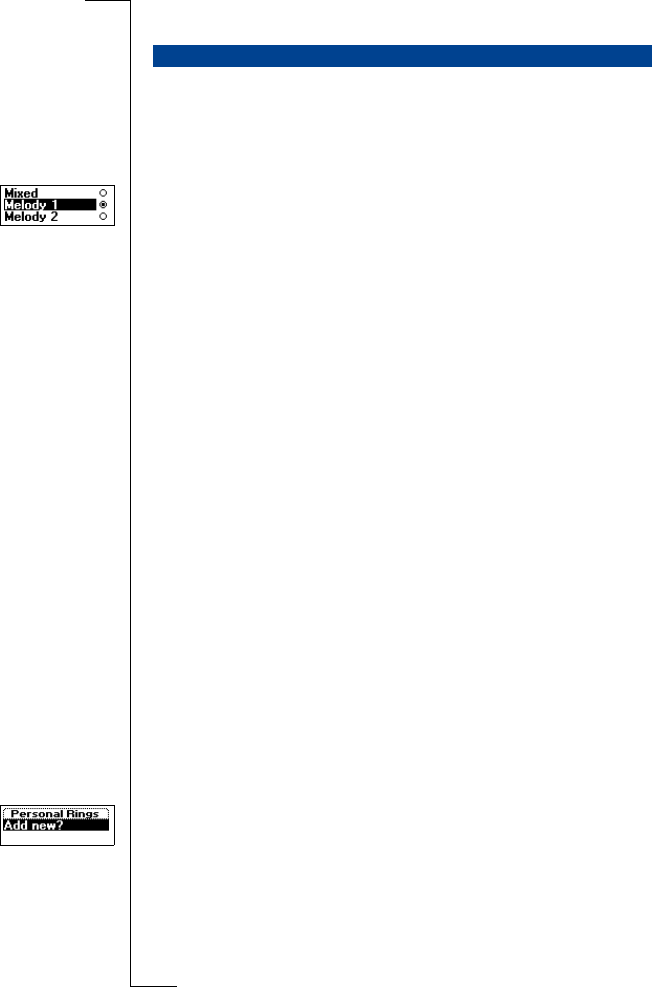
40 Personalizing Your Phone
Note! If the phone is set to silent, the increasing ring signal is not heard.
You can choose a ring signal from a list of different sounds and melodies. You
can also compose up to four melodies of your own by entering notes with the
keypad. See “Composing Ring Signals” on page 41.
To choose one of the ring signal types
1. Scroll to
Settings
, YES,
Sounds & Alerts
, YES,
Ring Signals
, YES,
Voice Calls
,
YES.
2. Select the ring signal type that you want.
Tip! If you do not wish to disturb other people, use the volume key on the side
of the phone to scroll silently.
Different Ring Signals for Line 1 and Line 2
If you subscribe to the Two Line Service, you can set different ring signals for
the two lines. L1 and L2 are displayed instead of Voice.
Different Ring Signals for Voice, Data and Fax Calls
Provided your SIM subscription supports Fax and Data calls, you can set dif-
ferent ring signals for voice, fax and data calls respectively.
Specific Ring Signals for Personal Calls
If your subscription includes the Calling Line Identification (CLI) service,
you can assign a personal ring signal to up to ten callers. You can, for exam-
ple, have one ring signal for your friend and another one for your colleague.
If the last seven digits of a caller’s number correspond to a number you have
specified, then that caller’s ring signal is used.
You can include question marks (?) in a phone number. For example,
012345??? means that calls from phone numbers between 012345000 and
012345999 will have the same personal ring signal. You get a question mark
by pressing and holding #.
To specify a caller’s number and the accompanying ring signal
1. Scroll to
Settings
, YES,
Sounds & Alerts
, YES,
Ring Signals
, YES,
Personal Rings
,
YES,
Add new?,
YES
.
2. Enter the caller’s number and press YES.
You can also recall it from the Phone Book by pressing ç.
3. Select the ring signal type you want.
RING SIGNAL TYPE
Marianne.book Page 40 Friday, October 1, 1999 2:00 PM
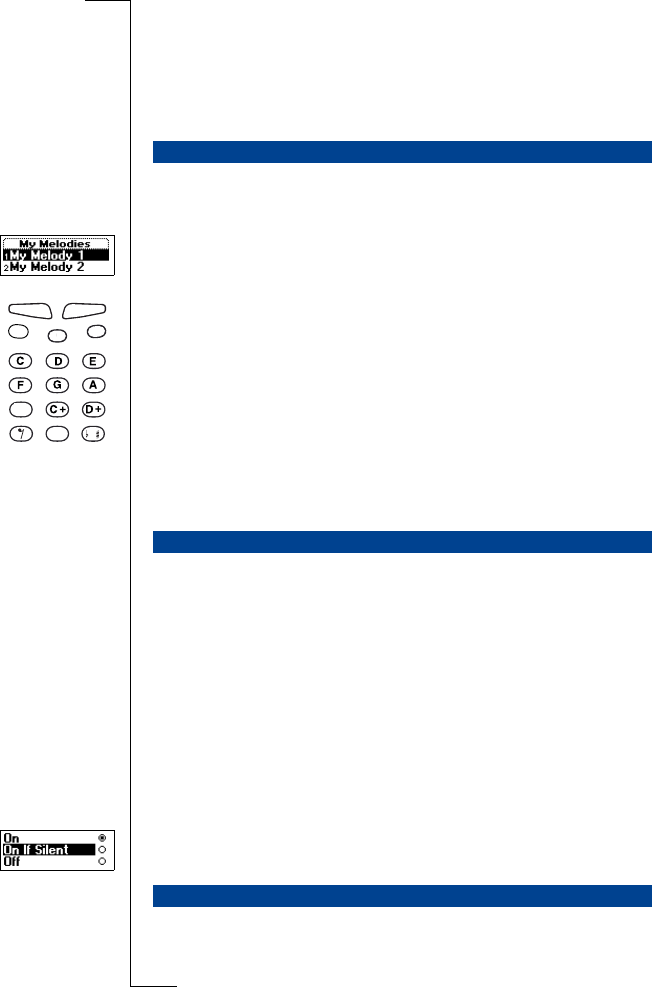
Personalizing Your Phone 41
To delete a caller’s number
1. Scroll to
Settings
, YES,
Sounds & Alerts
, YES,
Ring Signals
, YES,
Personal Rings
,
YES.
2. Scroll to the number you wish to delete and press YES.
3. Select
Delete
.
You can compose four different ring signals.
To compose a ring signal
1. Scroll to
Settings
, YES,
Sounds & Alerts
, YES,
Ring Signals
, YES,
My Melodies
,
YES.
2. Select
My Melody 1
,
My Melody 2
,
My Melody 3
or
My Melody 4
.
3. Press C to clear the display.
4. Use the keypad to enter notes.
The keypad now works as a keyboard (see figure in margin above):
•Press and hold a key to enter a long note.
•Press 0 to raise the note one octave.
•Press # once to raise the note one semitone.
•Press # twice to lower the note one semitone.
5. To listen to your melody, press YES.
6. Press YES again to save it or press NO to continue editing.
You can choose to be notified of an incoming call by the buzzing of the
Vibrating Alert. You can set the phone’s Vibrating Alert to one of the follow-
ing:
•On (all the time)
•On If Silent (on when the ring volume is turned off or when you have set
the phone to silent)
•Off (all the time)
Note! When your phone is placed in a desktop charger or a handsfree car kit,
the Vibrating Alert is turned off automatically.
To set the Vibrating Alert
1. Scroll to
Settings
, YES,
Sounds & Alerts
, YES,
Vibrating Alert
, YES.
2. Select the setting you want.
You can choose whether to hear clicks, tones or nothing (silent) when you
receive a voice or text message (SMS).
COMPOSING RING SIGNALS
VIBRATING ALERT
MESSAGE SIGNAL
B
Marianne.book Page 41 Friday, October 1, 1999 2:00 PM

42 Personalizing Your Phone
To set the message signal
1. Scroll to
Settings
, YES,
Sounds & Alerts
, YES,
Ring Signals
, YES,
Message Alert
,
YES.
2. Select the signal you want.
You can also find the Message Alert in Options in the Messages menu.
To change the alarm signal for the alarm clock
1. Scroll to
Settings
, YES,
Sounds & Alerts
, YES,
Ring Signals
, YES,
Alarm Signal
,
YES.
2. Select the signal you want.
You can choose whether to hear clicks, tones or nothing (silent) when you
press the keys.
To set the key sound
1. Scroll to
Settings
, YES,
Sounds & Alerts
, YES,
Key Sound
, YES.
2. Select the key sound you want.
If you turn on the minute minder, you hear a beep once every minute during a
call.
To turn the minute minder on or off
1. Scroll to
Settings
, YES,
Sounds & Alerts
, YES,
Minute Minder
, YES.
2. Select
On
or
Off
.
You can also find the minute minder in Options in the Call Info menu.
If you make a note of a number during a call, you use the display as a notepad,
see “The Notepad” on page 17. The person you are talking to will hear the
tone signals as you press the keys. If you wish to, you may turn the tone sig-
nals off.
Note! You can only turn the tones on or off during a call.
To turn the tone signals off during a call
1. Scroll to
Call Handling
, YES.
2. Select
Turn off Tones
.
ALARM SIGNAL
KEY SOUND
MINUTE MINDER
TURN OFF TONES
Marianne.book Page 42 Friday, October 1, 1999 2:00 PM

Personalizing Your Phone 43
To turn the tone signals on during a call
1. Scroll to
Call Handling
, YES.
2. Select
Turn on Tones
.
You can set the display light to automatic, off or on. In automatic mode, the
display light is turned off automatically a few seconds after you have pressed
the last key. It comes on again when you press a key, open the flip, or when
you receive a call or message.
To set the display light
1. Scroll to
Settings
, YES,
Display
, YES,
Light
, YES.
2. Select the display light setting you want.
Most modern SIM cards automatically set the display language to the lan-
guage of the country where you bought your SIM card, Automatic. If this is
not the case, the preset language is English.
To change the display language
1. Scroll to
Settings
, YES,
Language
, YES.
2. Select the language you want.
Tip! You can always choose English by pressing
ç
, 0000,
é
in standby.
You can always choose Automatic by pressing
ç
, 8888,
é
in standby.
When you turn on your phone, ‘Ericsson’ appears in the display. Instead of
this, you can write your own greeting.
Note! Some operators may have their own greeting.
To write a new greeting
1. Scroll to
Settings
, YES,
Display
, YES,
User Greeting
, YES.
2. Select
Custom
.
3. Write your new greeting, using the number keys. For information on how
to enter letters, see “Entering Letters” on page 28.
You may also edit your greeting.
4. Press YES to confirm your setting.
To set the standard greeting
1. Scroll to
Settings
, YES,
Display
, YES,
User Greeting
, YES.
2. Select
Standard
.
DISPLAY LIGHT
DISPLAY LANGUAGE
GREETING TEXT
Marianne.book Page 43 Friday, October 1, 1999 2:00 PM
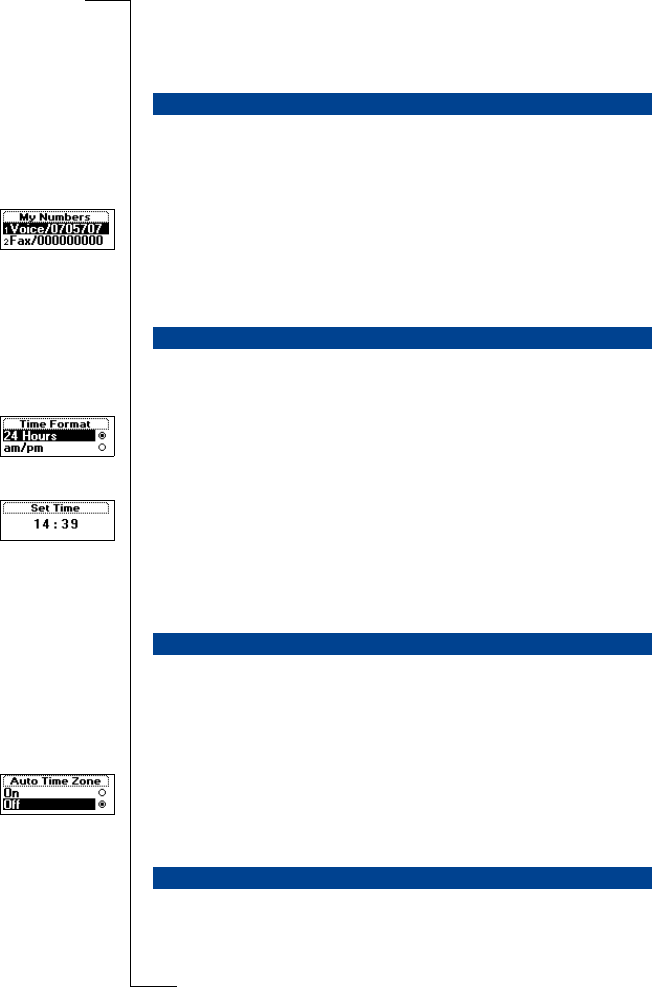
44 Personalizing Your Phone
To turn the greeting off
1. Scroll to
Settings
, YES,
Display
, YES,
User Greeting
, YES.
2. Select
Off
.
My Numbers allows you to check your phone number(s). If your phone
number cannot be retrieved from your SIM card, you can enter it yourself.
To enter your phone number
1. Scroll to
Settings
, YES,
Display
, YES,
My Numbers
, YES,
Voice
, YES.
2. Enter the number and then press YES.
Tip! You can also enter your fax and/or data number and your different
numbers for Line 1 and Line 2, if these are supported by your subscription.
The time is always displayed when the phone is in standby mode.
To set the time format
1. Scroll to
Settings
, YES,
Time and Date
, YES,
Time Format
, YES.
2. Select the 24-hour or 12-hour (am/pm) clock.
To set the clock
1. Scroll to
Settings
, YES,
Time and Date
, YES,
Set Time
, YES.
2. Enter the time in hours and minutes, and press YES.
Move from number to number by pressing ç or é.
If you select the 12-hour clock, you can alternate between am and pm by
pressing #.
With the Automatic Time Zone function, you will be asked whether to update
the clock when you enter a new time zone. You can choose to turn the function
off, if you like.
To turn the Automatic Time Zone off
1. Scroll to
Settings
, YES,
Time and Date
, YES,
Auto Time Zone
, YES.
2. Select
Off
.
Note! This service depends on the network.
When the phone is in standby mode, you can slide the volume key upwards or
downwards to see today’s date in the Status menu.
PHONE NUMBER DISPLAY
TIME
AUTOMATIC TIME ZONE
DATE
Marianne.book Page 44 Friday, October 1, 1999 2:00 PM

Personalizing Your Phone 45
To set the date format
1. Scroll to
Settings
, YES,
Time and Date
, YES,
Date Format
, YES.
2. Select the date format you want.
To set the date
1. Scroll to
Settings
, YES,
Time and Date
, YES,
Set Date,
YES.
2. Enter the year (two digits), month and day and then press YES.
If you have chosen another date format you must enter the date differently.
You can reset the phone’s settings to the way they were when you bought your
phone.
To reset the phone
1. Scroll to
Settings
, YES,
Master Reset
, YES.
2. Enter the phone lock code (
0000
) and press YES.
The phone lock code may be another one, in case you have changed it.
MASTER RESET
Marianne.book Page 45 Friday, October 1, 1999 2:00 PM

46 Sending and Receiving Text Messages (SMS)
Sending and Receiving
Text Messages (SMS)
The Short Message Service (SMS) allows you to send and receive text
messages consisting of up to 160 characters.
A useful feature in your T28 WORLD is that you can send text messages to a
group which you have defined in your phone book. See “Groups” on page 33.
Instead of calling or sending a text message to the members of that group one
at a time, you can simply send a single group SMS.
If your SIM card does not contain the phone number to your network service
centre, you must specify the number yourself. Otherwise you cannot reply to
received messages or send your own messages. See “Enable the Phone to
Send SMS” below.
Note! The Short Message Service may not be available on all networks. Some
network operators may only allow SMS to be sent within their own network.
If you want to send or reply to a message, you need to make sure that your
network operator’s Service centre number is set. Most modern SIM cards
already contain this information at the time of purchase. You can obtain the
service centre number from your network operator.
To activate a service centre number found in the list
1. Scroll to
Messages
, YES,
Options
, YES,
Service Centres
, YES.
2. Scroll to the number you want and press YES.
3. Select
Activate
.
If no number is found in the list, you have to set the number yourself.
To enter the phone number to your service centre
1. Scroll to
Messages
, YES,
Options
, YES,
Service Centres
, YES,
Add new?
, YES.
2. Enter the number, including the international (+) sign and country code
and press YES.
ENABLE THE PHONE TO SEND SMS
Marianne.book Page 46 Friday, October 1, 1999 2:00 PM

Sending and Receiving Text Messages (SMS) 47
For more information on how to enter text and the letters, see “Entering Let-
ters” on page 28.
Example:
•To enter an ‘A’, press 2 once.
•To enter a ‘B’, quickly press 2 twice.
•To enter lower-case letters, enter the letter, for example an ‘A’, and then
press *. An ‘a’ appears. Lower-case letters now appear until you press *
again.
•To enter numbers, press and hold any number key.
•To delete letters and numbers, press the C key.
You may also use the volume key as a shortcut to certain letters:
•To enter a ‘B’, slide the volume key upwards and press 2.
•To enter a ‘C’, slide the volume key downwards and press 2.
Tip! You can choose another alphabet by pressing and holding #.
1. Scroll to
Messages
, YES,
Send New
, YES.
2. Enter your message and press YES.
3. Enter the recipient’s phone number or recall it from the phone book by
pressing ç.
4. Press YES to send the message.
5.
Sending message
appears in the display followed by
Message has been sent
.
Note! If you have turned on any of the “Set On Send” options (Message Type,
Validity Period, Reply Request), you need to make these choices before enter-
ing the phone number. See “Customizing your Text Messages” on page 48.
Saving the Message for Later Use
If you do not want to send the message now, you can save it in the phone
memory and send it later:
•Press NO when you are asked to enter a phone number. The message can
now be recalled from the Unsent list in the Messages menu.
To send the message later
1. Scroll to
Messages
, YES,
Unsent
, YES
2. Select the message you want to send.
The message appears in the display.
3. Press YES.
COMPOSING A TEXT MESSAGE
SENDING A NEW TEXT MESSAGE
Marianne.book Page 47 Friday, October 1, 1999 2:00 PM
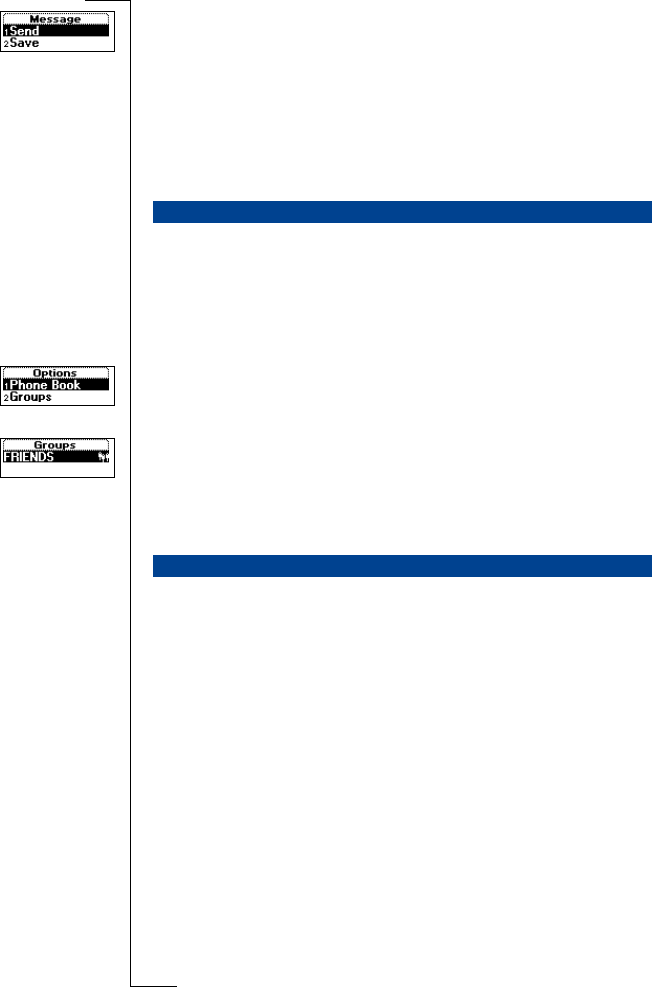
48 Sending and Receiving Text Messages (SMS)
4. Select
Send
.
If you wish, you may now edit your message.
5. Press YES and proceed from step 3 as described in “Sending a New Text
Message” above.
Note! The same procedure is used with all types of messages, for example e-
mail, fax messages etc. Check with your network operator to find out which
message types you can use.
With your T28 WORLD you can send text messages to a pre-defined group.
You need to specify a group and save it in your phone book before you can
send text messages to a group. For more information on how to create groups,
see “Groups” on page 33.
To send a text message to a group
1. Scroll to
Messages
, YES,
Send New
, YES.
2. Enter your message and press YES.
3. Press ç to enter the Phone Book menu.
4. Scroll to
Groups
and press YES.
5. Select the group you want and press YES to send the message.
Note! When you send text messages to a group, you will be charged for each
member included in that group.
Before you send your message, you can set the type of message, the validity
period and if you want the recipient of your message to reply to your message.
Message Type
Your phone can send different types of messages. Your network operator’s
service centre may offer the facility of converting a text message into a format
(e-mail, fax, etc.) that suits the equipment that is going to receive the message.
Please contact your network operator to find out which message types you can
use and how.
You can set a standard message type that you want to use or you can turn on a
Set on Send option, which means that you are asked to select which message
type you want to send, before sending it.
SENDING TEXT MESSAGES TO A GROUP
CUSTOMIZING YOUR TEXT MESSAGES
Marianne.book Page 48 Friday, October 1, 1999 2:00 PM
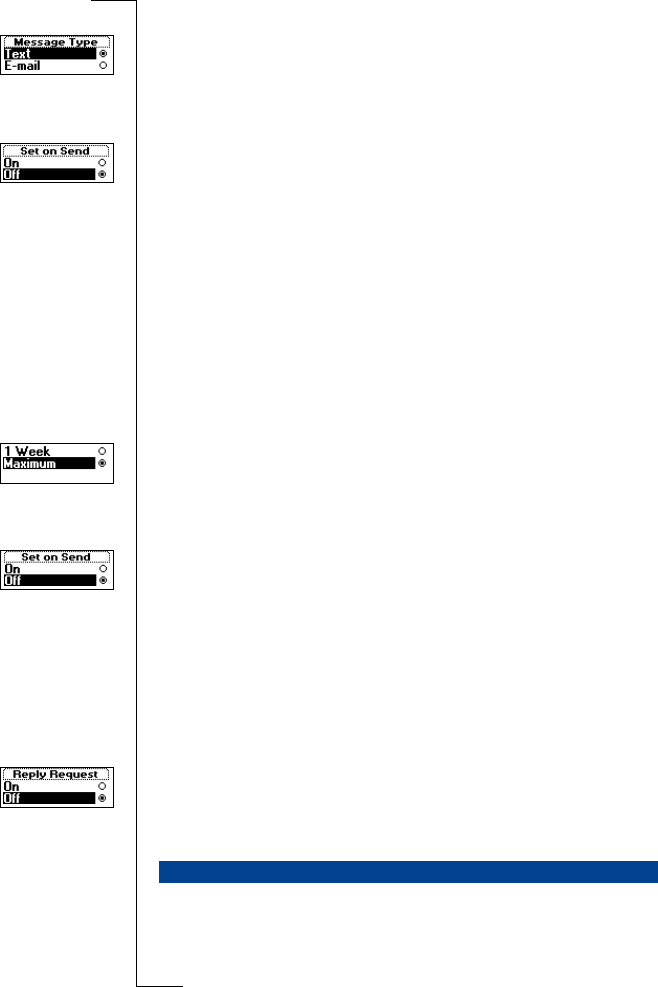
Sending and Receiving Text Messages (SMS) 49
To set a standard message type
1. Scroll to
Messages
, YES,
Options,
YES
, Message Type
, YES,
Set Default
, YES.
2. Select the message type you want.
The selected message type is now standard until you change it.
To turn “Set on Send” on or off
1. Scroll to
Messages
, YES,
Options,
YES
, Message Type
, YES,
Set on Send,
YES.
2. Select
On
or
Off
.
Validity Period
If your message cannot be delivered because the recipient has turned off the
phone, your service centre can save the message to send it later. If the service
centre has not been able to reach the recipient within a certain time, the mes-
sage will be deleted.
You can set a validity period as your standard or you can turn on a Set on
Send option, which means that you are asked to set the validity period before
sending the message.
To set a validity period as your standard
1. Scroll to
Messages
, YES,
Options
, YES,
Validity Period
, YES,
Set Default
,
YES.
2. Select the validity period you want.
The selected validity period is now your standard until you change it.
To turn the Set on Send function on or off
1. Scroll to
Messages
, YES,
Options
YES,
Validity Period
, YES,
Set on Send
, YES.
2. Select
On
or
Off
.
Reply to Messages
If you want the recipient of your message to reply, you can turn on the
Request Reply option. When this function is on, you are asked to choose if
you want the recipient to reply or not before your message is sent. If you want
the recipient to reply, select
On
and press YES.
To turn the Request Reply function on or off
1. Scroll to
Messages
, YES,
Options
, YES,
Reply
Request,
YES.
2. Select
On
or
Off
.
Note! Not all network operators support these functions.
If you have one or more standard messages that you use often, you can save
these as
Templates
to be reused whenever you want. You can save up to 5
TEMPLATES
Marianne.book Page 49 Friday, October 1, 1999 2:00 PM

50 Sending and Receiving Text Messages (SMS)
templates which can consist of 30 characters each. Your templates are saved in
the phone memory.
To save a template
1. Scroll to
Messages
, YES,
Templates
, YES,
Add new?
, YES.
2. Enter the message and press YES.
For more information on how to enter text, see “Composing a Text Mes-
sage” on page 47.
3. If you want to send the message now, press YES when
Send message now?
appears in the display, and proceed as described in “Sending a New Text
Message” on page 47. The message is saved in the list of templates.
4. If you do not want to send the message now, press NO. The message is
saved as a template for later use.
To send a template
1. Scroll to
Messages
, YES,
Templates
, YES.
2. Select the template you want to send.
You may edit the message before sending it. See “Sending a New Text
Message” on page 47.
3. When you have completed the message, press YES.
4. Enter the recipient’s phone number.
5. Press YES to send the template.
To delete a template
1. Scroll to
Messages
, YES,
Templates
, YES.
2. Select the message you want to delete and then press C.
The message
Delete?
appears in the display.
3. Press YES to delete the message.
When you receive a message, you hear a signal, the indicator light on the top
of the phone rapidly flashes green and the message
New message Read now?
appears in the display.
Note! All networks do not send an audible signal.
To read the message now
1. Press YES when you see the question
New message Read now?
.
The display shows when the message was received and from what number
it was sent, if your network supports the Calling Line Identification service
RECEIVING A MESSAGE
New message
Read now?
Marianne.book Page 50 Friday, October 1, 1999 2:00 PM

Sending and Receiving Text Messages (SMS) 51
(CLI). If you have saved the number together with a name in the phone
book, the name is shown instead.
2. Scroll through the message using the arrow keys. é takes you forwards
and ç takes you backwards through the message. An arrow at the
bottom right corner of the display indicates that there is more text in the
message.
3. At the end of the message, when the arrow in the display disappears, press
YES. A new menu with different options appears:
•Delete
•Reply
•Forward
•Save
•Call
•Read Next
The options are described on the following pages.
Note! If the sender of the message wants you to reply, the message ‘Reply
requested Reply?’ appears in the display when you press YES, if this function
is supported by your network operator. If you do not want to reply, press NO.
To read the message later
•Press NO when you see the question
New message Read now?
.
The message is now saved in the phone memory and an envelope icon
appears at the top of the display. The envelope icon disappears as soon as
you have read the message. If you want to read the message later you can
retrieve it from the Inbox menu (see below).
Calling a Phone Number Found in a Message
1. Press YES when the number is highlighted.
2. Select
Call 0990237237
.
Calling the Sender of the Message
1. When you have read the message, press YES.
2. Select
Call
in the option list.
If you have saved the number together with a name in the phone book, the
name of the person who sent the message appears together with
Call
.
Replying to a Message
1. When you have read the message, press YES.
2. Select
Reply
in the option list.
3. Select what message you want to send as a reply (send a new message or
include this message when replying).
Marianne.book Page 51 Friday, October 1, 1999 2:00 PM

52 Sending and Receiving Text Messages (SMS)
4. Enter your message and press YES to send the message.
Note! If the sender of the message wants you to reply, the message ‘Reply
requested Reply?’ appears in the display, if this function is supported by your
network operator, when you press YES at the end of the message. Press YES
again to reply. If you do not want to reply, press NO.
Forwarding a Message
1. When you have read the message, press YES.
2. Select
Forward
in the option list.
You may edit your message before sending it.
3. When you have completed your message, press YES.
4. Enter the recipient’s phone number.
5. Press YES to send the message.
Deleting a Message
1. When you have read the message, press YES.
2. Select
Delete
in the option list.
Tip! You can also delete a message by pressing C while reading it. The
message
Delete?
appears in the display. Press YES to delete the message.
You can delete a message from the list of messages in the Inbox menu
without having to open it.
To delete a message from the list in the Inbox menu
1. Scroll to
Messages
, YES,
Inbox
, YES.
2. Select the message you want to delete and press C.
The message
Delete?
appears in the display.
3. Press YES to delete the message.
If you do not want to read an incoming message at once, it is automatically
saved in the phone memory. This allows you to read it later. If there are any
unread messages in this memory, the envelope icon appears at the top of the
standby display.
The phone memory can hold up to 15 messages. When all memory positions
are full, the oldest read message is overwritten when a new message is
received.
If the phone memory becomes full of unread messages, new messages are
automatically saved on the SIM card.
SAVING INCOMING MESSAGES
Marianne.book Page 52 Friday, October 1, 1999 2:00 PM
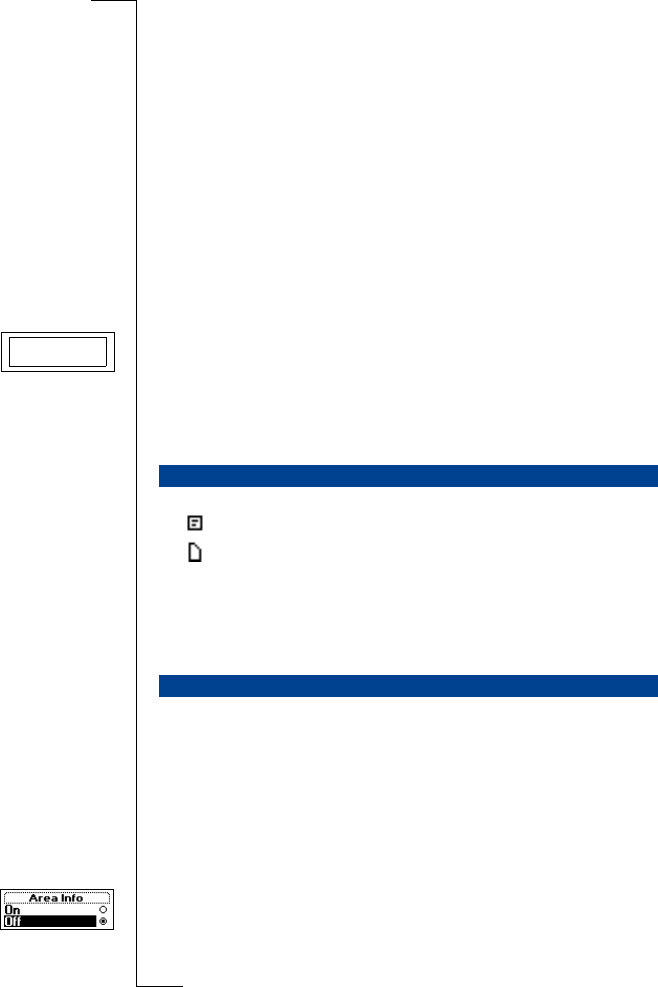
Sending and Receiving Text Messages (SMS) 53
Messages remain in the phone memory until you delete them, until you insert
a different SIM card or until the phone needs the memory space to save new
messages.
The SIM Card Memory
You can save important messages on your SIM card. Messages that are saved
on the SIM card remain there until you delete them, i.e. they will not be over-
written if you receive any new messages. The maximum number of messages
that you can save depends on your SIM card.
To save a received message in the SIM card memory
1. When you have read the message, press YES.
2. Select
Save
in the option list.
The message automatically moves from the phone memory to the SIM
card memory. The display shows the position of the message and the
number of saved messages, for example the third message of fifteen that
can be saved on the SIM card.
Note! If you save your messages on the SIM card, you can reach them if you
should use your SIM card with another phone.
1. Scroll to
Messages
, YES,
Inbox
, YES.
means an unread message.
means that the message is saved on the SIM card.
2. Select the message you want to read.
3. Read the message as described in “Receiving a Message” on page 50.
4. If you want to read the next message, press YES at the end of the message.
5. Select
Read Next
in the option list.
The ordinary Short Message Service is a personal service that carries your
private messages. The Area Information is another type of text message which
is sent to all subscribers in a certain network area.
The information may be a local road report or a phone number to a local taxi.
Note! This feature may not be available on all networks.
To turn Area Information on or off
1. Scroll to
Messages
, YES,
Options
, YES,
Area Info
, YES,
Reception
, YES.
2. Select
On
or
Off
.
READING A SAVED MESSAGE
AREA INFORMATION
Saved on card
3 (15)
Marianne.book Page 53 Friday, October 1, 1999 2:00 PM

54 Sending and Receiving Text Messages (SMS)
Area Information Message Types
Each type of Area Information message is identified by a three-digit code. The
list below shows examples of the Area information codes that exist today.
Note! These codes are operator dependent. For information about the area
information services that you can use, please refer to the information supplied
by your network operator.
Area Information Message List
You can decide which types of area information messages you wish to receive.
The number of Area Info codes that can be saved depends on your SIM card.
To insert an Area Information code
1. Scroll to
Messages
, YES,
Options
, YES,
Area
Info
, YES,
Edit List
, YES,
Add new?
, YES.
2. Enter the new code and press YES.
To delete the code
1. Scroll to
Messages
, YES,
Options
, YES,
Area Info
, YES,
Edit List
, YES.
2. Select the code you want to delete and press C.
The message
Erase?
appears in the display.
3. Press YES to delete the code.
Code: AI Message Type:
000 Index
010 Newsflashes
020 Hospitals
022 Doctors
024 Pharmacies
030 Long-distance road reports
032 Local road reports
034 Taxis
040 Weather
050 District cell information
052 Network information
054 Operator services
056 Directory enquiries (national)
057 Directory enquiries (international)
058 Customer care (national)
059 Customer care (international)
Marianne.book Page 54 Friday, October 1, 1999 2:00 PM
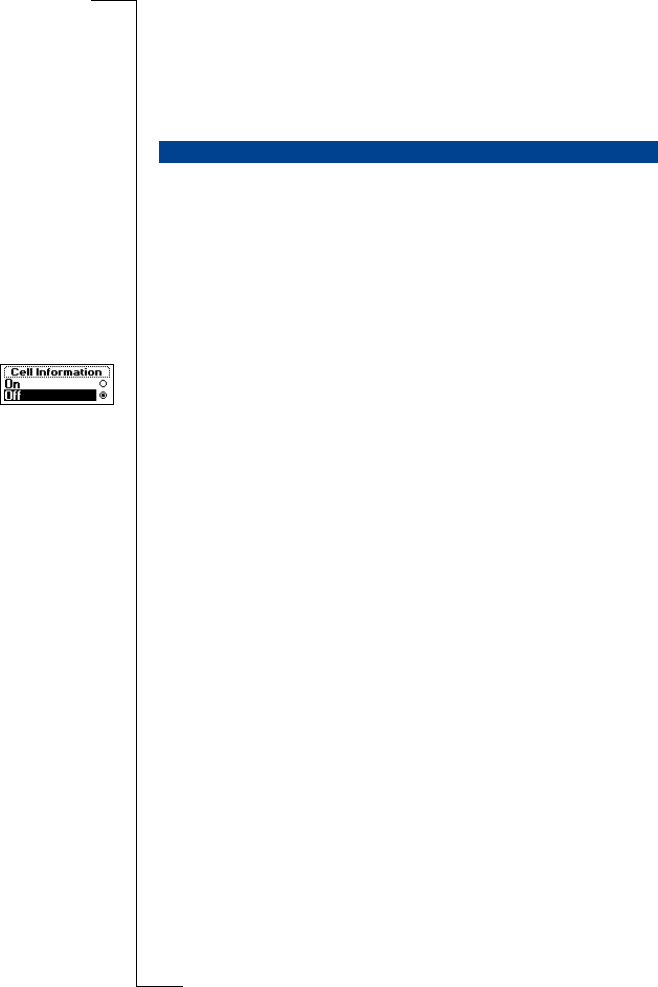
Sending and Receiving Text Messages (SMS) 55
Receiving an Area Message
When you receive an Area Information message, the message automatically
appears in the display. You read the message in the same way as you read an
ordinary text message, see “Receiving a Message” on page 50. When you
have read the message, press YES. The message is deleted.
The Cell information channel (see “Area Information Message List” on page
54) is used by network operators for sending messages to their subscribers
within a certain network area. For example, the operator may inform you that
you are within your home network area and that you can now make calls at a
lower rate.
Note! This feature may not be supported by your network operator.
To turn Cell Information on or off
1. Scroll to
Messages
, YES,
Options
, YES,
Cell Information
, YES,
2. Select
On
or
Off
.
CELL INFORMATION
Marianne.book Page 55 Friday, October 1, 1999 2:00 PM

56 Diverting Incoming Calls
Diverting Incoming Calls
If you want to make certain that your incoming calls are correctly handled
when you are unable to answer them, you can use the Divert Calls service to
divert them to another phone number.
Note! The Divert Calls service may not be available on all networks.
The Divert Calls service lets you divert your voice, fax and data calls respec-
tively – provided your subscription supports fax and data calls.
For voice calls, you may choose between the following divert alternatives:
•divert all voice calls, All Voice Calls
•divert calls if you are already on the phone, When Busy
•divert calls that you do not answer within a specified time limit (operator
dependent), No Reply
•divert calls if your phone is turned off or if you are unreachable, Not
Reachable
Note! These alternatives are only valid for voice calls.
If you subscribe to the Two Line Service, you may set different Divert Calls
for your two voice lines, i.e. Line 1 and Line 2. You will then have an addi-
tional divert alternative, i.e. All Line 2 Calls.
Tip! If you place your T28 WORLD in a specific Ericsson Desktop Charger,
your calls may be diverted automatically. See “Desktop Charger” on page 92.
When you are making a phone call and the phone call is diverted to another
number, this is indicated in your display, if supported by your subscription.
Similarly, when receiving an incoming phone call which has been diverted
from another number, this is indicated in your display, if supported by your
subscription.
To divert a call
1. Scroll to
Settings
, YES,
Call Options
, YES,
Divert Calls
, YES.
2. Scroll to the divert you want to turn on (
All Voice Calls, When Busy
,
No Reply, Not
Reachable, Fax Calls
or
Data Calls
) and press YES.
3. Select
Activate
.
ACTIVATING DIVERT CALLS
Marianne.book Page 56 Friday, October 1, 1999 2:00 PM
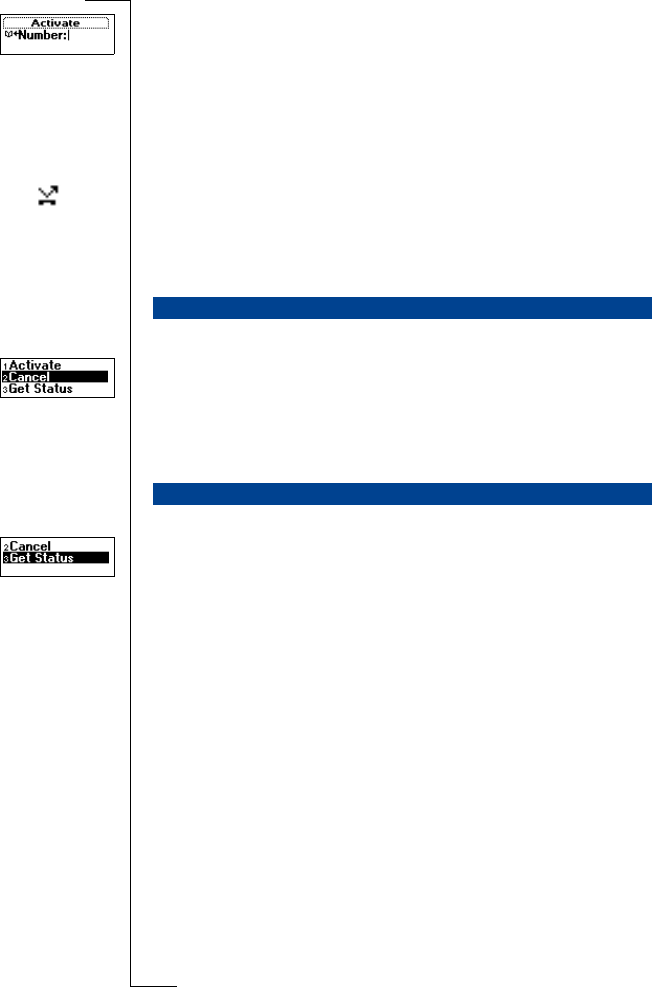
Diverting Incoming Calls 57
4. A phone number recently used for the divert function or a number recently
present in the display will be suggested as a divert number. Enter the
phone number, including the area code, to which you want your calls to be
diverted and then press YES. If you need to delete numbers, press C.
Tip! If the phone number is stored in the phone book, you do not need to enter
it. Press
ç
and then recall the number.
When you turn on the All Voice Calls divert, an icon is shown in standby.
Note! When the Restricted Calls function is on, some Divert Calls options
cannot be activated. See “Security for Your Phone and Subscription” on page
58.
To cancel a certain Divert Calls
1. Scroll to
Settings
, YES,
Call Options
, YES,
Divert Calls,
YES.
2. Scroll to the divert you want to cancel and press YES.
3. Select
Cancel
.
The message
Please wait
appears, followed by a message which informs you
that the Divert Calls has been cancelled.
To check the status of a certain Divert Calls
1. Scroll to
Settings
, YES,
Call Options
, YES,
Divert Calls
, YES.
2. Scroll to the divert you want to check and press YES.
3. Select
Get Status
.
The message
Please wait
appears, followed by a message which informs you
whether the Divert Calls is on or not.
To check the status of all Divert Calls
•Scroll to
Settings
, YES,
Call Options
, YES,
Divert Calls
, YES,
Check All
, YES.
CANCELLING DIVERT CALLS
CHECKING THE DIVERT STATUS
Marianne.book Page 57 Friday, October 1, 1999 2:00 PM
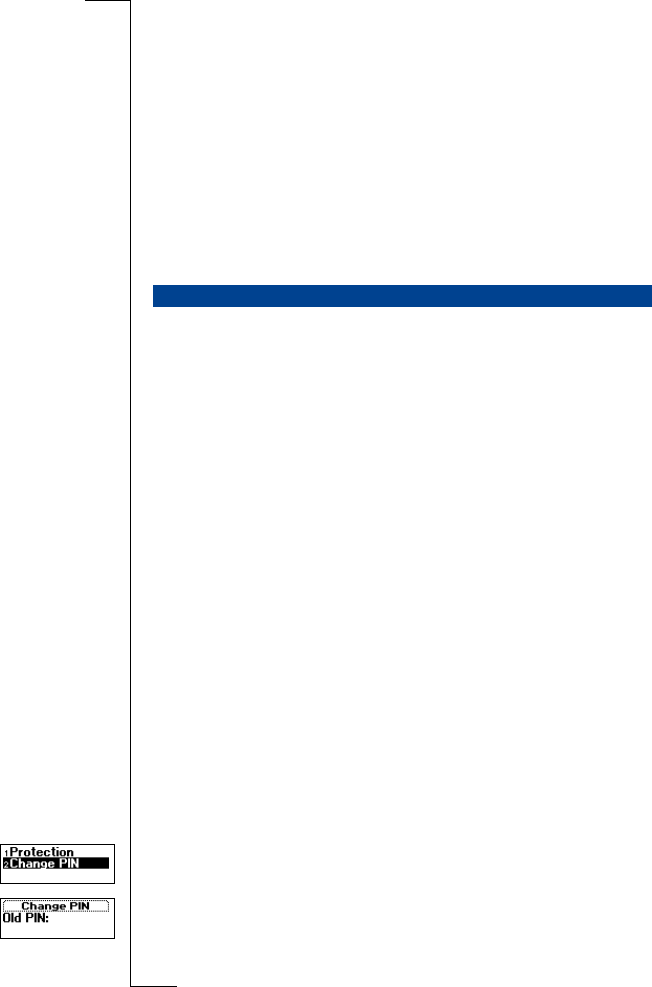
58 Security for Your Phone and Subscription
Security for Your Phone
and Subscription
There are several ways to protect your phone and subscription from
unauthorized use. Anything from a SIM card lock to full phone number
control.
The SIM card lock only protects your subscription and not your phone itself
from unauthorized use. If you change SIM cards, the phone still works with
the new SIM card.
Most SIM cards are locked at the time of purchase. If the SIM card lock is on,
you have to enter the PIN (Personal Identity Number) every time you turn on
your phone. If you enter your PIN incorrectly three times in a row, the SIM
card is blocked. This is indicated by the message PIN blocked. If this
happens you need to unblock it to access your subscription.
To unblock your SIM card
1.
PIN blocked
appears.
2. Enter your PUK (or PUK2) which you will find in the information sup-
plied by your network operator.
3. Press YES.
4. Enter a new four- to eight-digit PIN (or PIN2).
5. Press YES.
6. Re-enter the new PIN (or PIN2) to confirm.
7. Press YES.
Note! If you enter the wrong PUK ten times in a row, your card is permanently
blocked. If this happens, you should contact your network operator.
To change your PIN code
1. Scroll to
Settings
, YES,
Locks
, YES,
Card Lock
, YES,
Change PIN
, YES.
2. Enter your old (current) PIN and press YES.
3. Enter your new PIN and press YES.
The phone asks you to repeat the PIN.
THE SIM CARD LOCK
Marianne.book Page 58 Friday, October 1, 1999 2:00 PM

Security for Your Phone and Subscription 59
4. Enter your new PIN a second time and press YES.
The PIN has now been changed.
Note! If the message Codes do not match appears, this means you entered
the new PIN incorrectly. If the message Wrong PIN appears, followed by Old
PIN:, you entered your old PIN incorrectly.
To change your PIN 2
1. Scroll to
Settings
, YES,
Locks
, YES,
Card Lock
, YES,
Change PIN2
, YES.
2. Follow the same procedure as described in ‘To change your PIN code’
above.
To turn off the SIM card lock
1. Scroll to
Settings
, YES,
Locks
, YES,
Card Lock
, YES,
Protection
, YES,
Off
,
YES.
2. Enter your PIN and press YES.
The message
Unlocked
confirms that the card lock has now been turned off.
Note! This only works if your SIM card allows you to cancel the card lock.
To turn on the SIM card lock
1. Scroll to
Settings
, YES,
Locks
, YES,
Card Lock
, YES,
Protection
, YES,
On
,
YES.
2. Enter your PIN and press YES.
The message
Locked
confirms that the card lock is now on.
The phone lock protects the phone against unauthorized use if it is stolen and
the SIM card is exchanged. It is not on when you buy the phone. You can
change the phone lock code (0000) to any four- to eight-digit personal code.
The phone lock can be On, Automatic or Off.
Phone lock on
If the phone lock is On, the message Phone locked Phone lock code: appears
each time you turn on the phone. You have to enter your code followed by
YES to use your phone.
Automatic
If the phone lock is set to Automatic, you do not need to enter your phone
lock code until a different SIM card is inserted in the phone. After the phone
lock code has been entered correctly, the phone can be used with the new SIM
card. You are not asked to enter the phone lock code again until the original
SIM card or a different SIM card is inserted.
THE PHONE LOCK
Marianne.book Page 59 Friday, October 1, 1999 2:00 PM
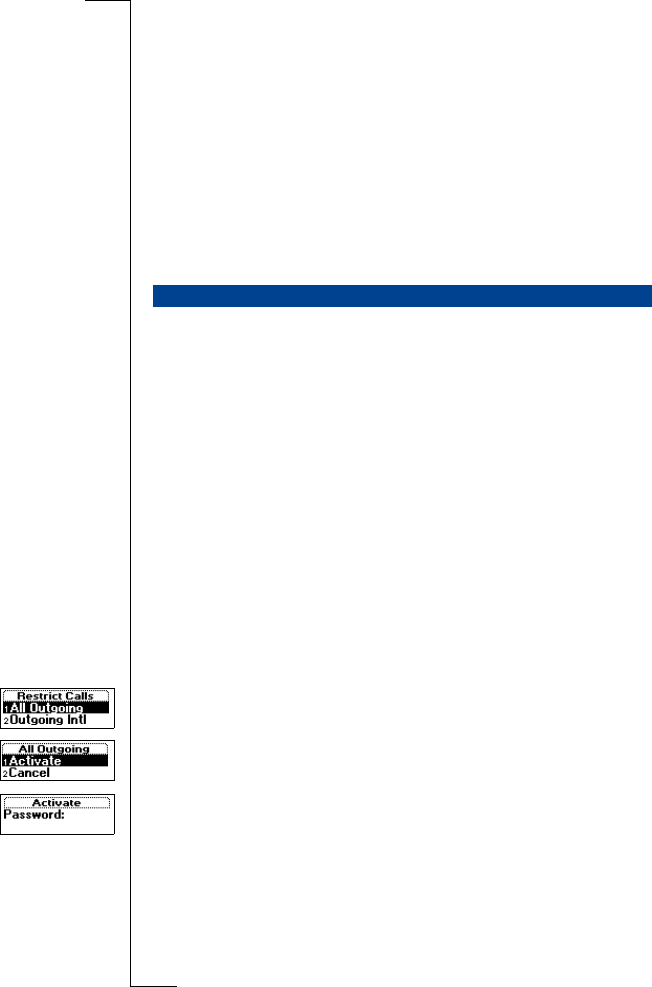
60 Security for Your Phone and Subscription
Changing the phone lock code
1. Scroll to
Settings
, YES,
Locks
, YES,
Phone Lock
, YES,
Change Code
, YES.
2. Follow the steps described in “To change your PIN code” on page 58.
Note! It is important that you remember your new code. If you should forget it,
you have to hand in your phone to your local Ericsson retailer.
To set the phone lock to on, automatic or off
1. Scroll to
Settings
, YES,
Locks
, YES,
Phone Lock
,
Protection
, YES.
2. Select
On
,
Automatic
or
Off
.
3. Enter the phone lock code and press YES.
The new lock status
is shown.
The Restrict Calls service allows you to restrict certain types of calls to be
made and received.
Note! This service may not be available on all networks or may require a
separate subscription.
The following calls can be restricted:
•all outgoing calls,
All Outgoing
•all outgoing international calls,
Outgoing Intl
•all outgoing international calls except to your home country,
Outg Intl Roam
•all incoming calls,
All Incoming
•all incoming calls when you are abroad (when roaming),
Inc when Roam
To make sure that a call restriction is not changed by someone else, you need a
password, which comes with your subscription, to turn on or cancel a call
restriction. You can change the password as often as you like.
To activate/cancel a call restriction
1. Scroll to
Settings
, YES,
Call Options
, YES,
Restrict Calls
, YES.
2. Scroll to the option you want and press YES.
3. Select
Activate
or
Cancel
.
4. Enter your password and press YES.
The message Please wait appears, followed by a message which informs
you whether the call restriction is on or not.
Note! If you divert incoming calls you cannot activate some Restrict Calls
options. Likewise, if you restrict calls, you cannot activate some Divert Calls
options. See “Diverting Incoming Calls” on page 56.
RESTRICT CALLS
Marianne.book Page 60 Friday, October 1, 1999 2:00 PM

Security for Your Phone and Subscription 61
To cancel all call restrictions
1. Scroll to
Settings
, YES,
Call Options
, YES,
Restrict Calls
, YES,
Cancel All
, YES.
2. Enter your password and press YES.
The message
Please wait
appears, followed by a message confirming that all
call restrictions have been cancelled.
To check the status of a call restriction
1. Scroll to
Settings
, YES,
Call Options
, YES,
Restrict Calls
, YES.
2. Scroll to the option you want and press YES.
3. Select
Get Status
.
The message
Please wait
appears, followed by a message which informs you
whether the call restriction is on or not.
To change the password
1. Scroll to
Settings
, YES,
Call Options
, YES,
Restrict Calls
, YES,
Change Passwd
,
YES.
2. Enter the old (current) password and press YES.
3. Enter the new password and press YES.
4. Enter the new password a second time and press YES.
The message
Please wait
appears, followed by a message confirming that the
password has been changed.
Fixed Dialling is a way of restricting outgoing calls. It requires a SIM card
that allows fixed numbers to be saved. The fixed numbers are normally
protected by your PIN2. How many fixed numbers you can save depends on
your SIM card.
The Fixed Dialling function allows calls to be made only to certain numbers
saved on the SIM card. If an attempt is made to call other numbers, the
message Number not permitted appears in the display.
It is possible to save partial numbers, for example an area code, or an area
code followed by the first digits common to several numbers. Storing
0123456 allows calls to be made to all numbers starting with 0123456.
Numbers beginning with the international (+) sign and country code can also
be saved, allowing you to make calls abroad.
Numbers which include question marks can be saved. A question mark should
be read as a wild card, i.e. it can represent any number (0-9). To enter a ques-
tion mark press and hold #.
FIXED DIALLING
Marianne.book Page 61 Friday, October 1, 1999 2:00 PM

62 Security for Your Phone and Subscription
Note! The Fixed Dialling service does not prohibit calls to the international
emergency number 112 (or 911 in the Americas).
To turn the Fixed Dialling service on or off
1. Scroll to
Phone Book
, YES,
Options
, YES,
Fixed Dialling,
YES.
2. Enter your PIN2 and press YES.
3. Select
On
or
Off
.
To save fixed numbers
1. Scroll to
Phone Book
, YES,
Fixed Numbers
, YES,
Add new?
, YES.
2. Enter your PIN2 and press YES.
3. Enter the fixed number and press YES.
4. Enter the name you want to associate with the number and press YES.
To edit a saved fixed number
1. Scroll to
Phone Book
, YES,
Fixed Numbers
, YES.
2. Scroll to the fixed number that you want to edit and press YES.
3. Select
Edit
.
4. Enter your PIN2 and press YES.
5. Edit the fixed number and press YES.
6. Edit the name and press YES.
7. Enter the position number and press YES.
To delete a fixed number
1. Scroll to
Phone Book
, YES,
Fixed Numbers
, YES.
2. Scroll to the fixed number that you want to delete and press YES.
3. Select
Delete
.
4. Enter your PIN2 and press YES.
The fixed number is deleted.
The Closed User Group (CUG) function is another way of lowering call
costs. It depends entirely on your operator and subscription. Not all networks
support this function.
Your network operator can place certain numbers in groups. On some net-
works it is cheaper to make calls within a call group. You can have a maxi-
mum of 10 groups.
To add a Closed User Group
1. Scroll to
Settings
, YES,
Call Options
, YES,
Closed Groups
, YES,
Edit List
, YES,
Add new?
, YES.
2. Enter the name of the Closed User Group and press YES.
CLOSED USER GROUPS
Marianne.book Page 62 Friday, October 1, 1999 2:00 PM
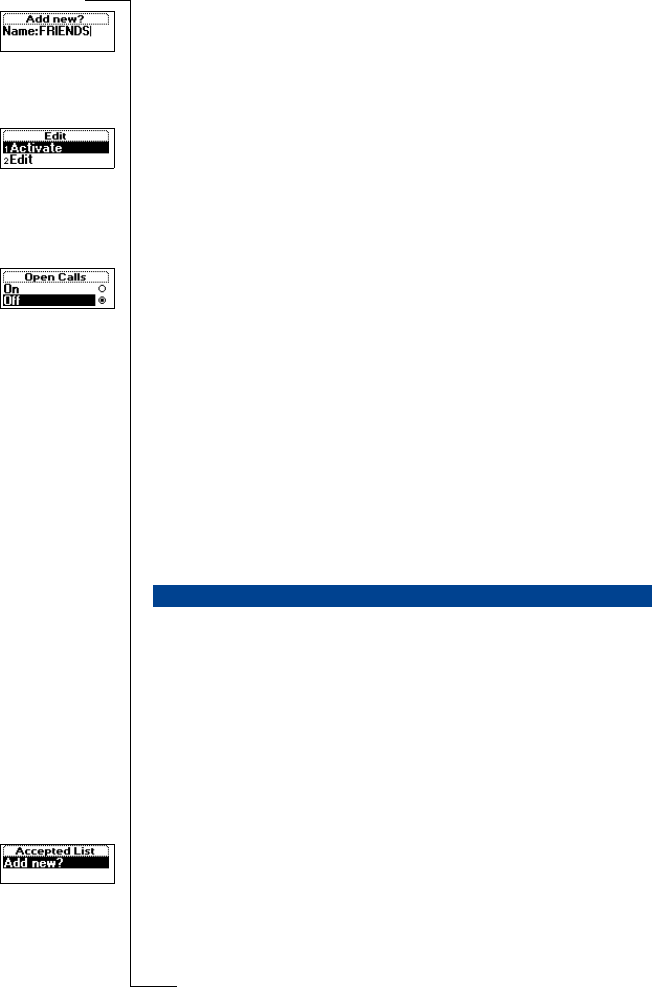
Security for Your Phone and Subscription 63
3. Enter the index number of the group and press YES.
Note! The index numbers are provided by your network operator.
To activate a Closed User Group
1. Scroll to
Settings
, YES,
Call Options
, YES,
Closed Groups
, YES,
Edit List
, YES.
2. Scroll to the group you want to activate and press YES.
3. Select
Activate
.
Calls can only be made within the selected user group.
To call outside Closed User Groups
You can decide whether outgoing calls to a non-CUG number are allowed.
1. Scroll to
Settings
, YES,
Call Options
, YES,
Closed Groups
, YES
, Open Calls
,
YES.
2. Select
On
.
To edit a name in the CUG List
1. Scroll to
Settings
, YES,
Call Options
, YES,
Closed Groups
, YES,
Edit List
, YES.
2. Scroll to the group that you want to edit and press YES.
3. Select
Edit
.
4. Enter a new name and press YES.
To delete a group from the CUG List
1. Scroll to
Settings
, YES,
Call Options
, YES,
Closed Groups
, YES,
Edit List
, YES.
2. Scroll to the group that you want to delete and press YES.
3. Select
Delete
.
With the Accept Calls service, you can choose to receive calls only from
certain numbers. Other calls are automatically rejected by a busy tone. You
have to save the numbers that you want to receive in an Accepted List. The
rejected calls are saved in the Call List in the Call Info menu. When you buy
your phone, the setting for the Accept Calls service is set to From All, i.e.
you receive calls as normal.
To add numbers to the Accepted Callers List
1. Scroll to
Settings
, YES,
Call Options
, YES,
Accept Calls
, YES,
Accepted List
,
YES,
Add new?
, YES. This takes you to your phone book.
2. Select a number.
To add more participants in the
Accepted Callers List
, repeat steps 1 to 2
above. It is possible to choose a number within a group in your phone
book.
ACCEPT CALLS
Marianne.book Page 63 Friday, October 1, 1999 2:00 PM

64 Security for Your Phone and Subscription
To delete numbers from the Accepted Callers List
1. Scroll to
Settings
, YES,
Call Options
, YES,
Accept Calls
, YES,
Accepted List
,
YES.
2. Scroll to the number you want to delete and press C.
To check the Accepted Callers List
1. Scroll to
Settings
, YES,
Call Options
, YES,
Accept Calls
, YES,
Accepted List
,
YES.
To accept calls from the list
1. Scroll to
Settings
, YES,
Call Options
, YES,
Accept Calls
, YES,
Accept Options,
YES.
2. Select
From List
.
Now you will only receive calls from the participants in the
Accepted Callers
List
. An icon is shown in standby.
To reject all calls
1. Scroll to
Settings
, YES,
Call Options
, YES,
Accept Calls
, YES,
Accept Options,
YES.
2. Select
From No One
.
All incoming calls will now be rejected. The caller hears a busy tone and
you get no indication of incoming calls. An icon is shown in standby.
To accept calls from all
1. Scroll to
Settings
, YES,
Call Options
, YES,
Accept Calls
, YES,
Accept Options,
YES.
2. Select
From All
.
You will now receive all calls as normal.
To check the Accepted Calls function
•Scroll to
Settings
, YES,
Call Options
, YES,
Accept Calls
, YES,
Accept Options,
YES.
The Accepted Calls alternative that is on is marked with a filled button.
Marianne.book Page 64 Friday, October 1, 1999 2:00 PM
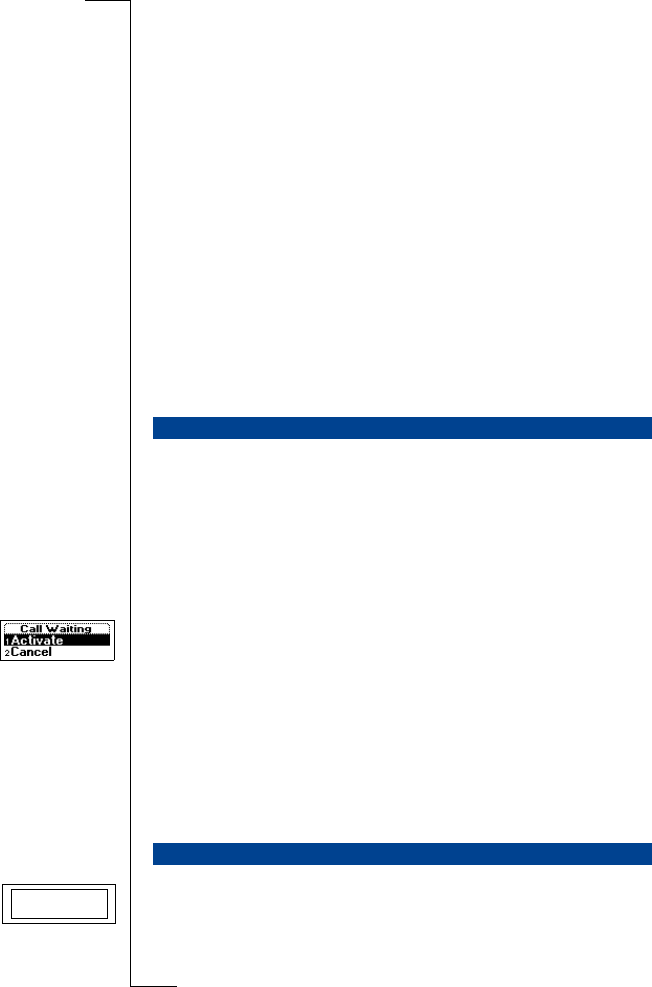
Handling More than One Call Simultaneously 65
Handling More than One
Call Simultaneously
Your phone allows you to handle more than one call simultaneously. This
means that you can put a call that is in progress on hold, while you make or
answer a second call, and then switch between the two calls.
You may also set up a Conference Call to have a joint conversation with up to
five people. You may put an individual or a group of conference members on
hold while you add other people to the conference call. You may also put
conference members on hold while you talk to someone privately. See “Con-
ference Calls” on page 67.
If you wish to be able to receive a second call, while another call is in
progress, you must turn on the Call Waiting service.
Note! The Call Waiting service may not be available on all networks.
If you are engaged in a fax or a data call, you will not hear any incoming
calls. Incoming calls are rejected.
To turn on the Call Waiting service
•Scroll to
Settings
, YES,
Call Options
, YES,
Call Waiting
, YES,
Activate
, YES.
There may be a short delay before the network responds. In the meantime,
the message
Please wait
is displayed. This is followed by the message
Call
Waiting Activated
.
To cancel the Call Waiting service
•Scroll to
Settings
, YES,
Call Options
, YES,
Call Waiting
, YES,
Cancel
, YES.
To check whether the Call Waiting service is on or not
•Scroll to
Settings
, YES,
Call Options
, YES,
Call Waiting
, YES,
Get Status
, YES.
1. Put the current call on hold by pressing YES.
2. Enter the number you wish to call and press YES.
You may also retrieve the number from your phone book by pressing and
holding é.
THE CALL WAITING SERVICE
MAKING A SECOND CALL
Call held
Marianne.book Page 65 Friday, October 1, 1999 2:00 PM

66 Handling More than One Call Simultaneously
Note! You can only put one call on hold.
If the Call Waiting service is on, you hear a tone in the earpiece if you receive
a second call. The number or name of the caller is normally shown at the top
of the display together with a list of the alternatives Answer, Busy and
Release&answer. If the incoming call is a restricted number, the display
shows Withheld. If the incoming call is a number without any CLI service,
Unknown is shown.
You can do one of the following:
Put the current call on hold and answer the waiting call
•Press YES to answer the waiting call.
The current call is now put on hold.
Your held call is marked in grey in the display and the active call is marked
in black.
Continue the current call and reject the waiting call
•Select
Busy
.
The waiting call is rejected. If the caller’s network supports it, the caller
hears a busy tone.
Note! If Divert When Busy is on, the waiting call is diverted to the number
you have specified.
End the current call and answer the waiting call
•Select
Release&answer
.
When you have one active call and one call on hold, you can do one of the
following:
Switch between the two calls
•Press YES.
End the active call and return to the call on hold
1. Press NO. The question
Retrieve call?
appears.
2. Press YES.
If you press NO, also the call on hold will be ended.
End both calls
•Scroll to
Call Handling
, YES,
Release All
, YES.
RECEIVING A SECOND CALL
ONE ACTIVE CALL AND ONE CALL ON HOLD
Marianne.book Page 66 Friday, October 1, 1999 2:00 PM
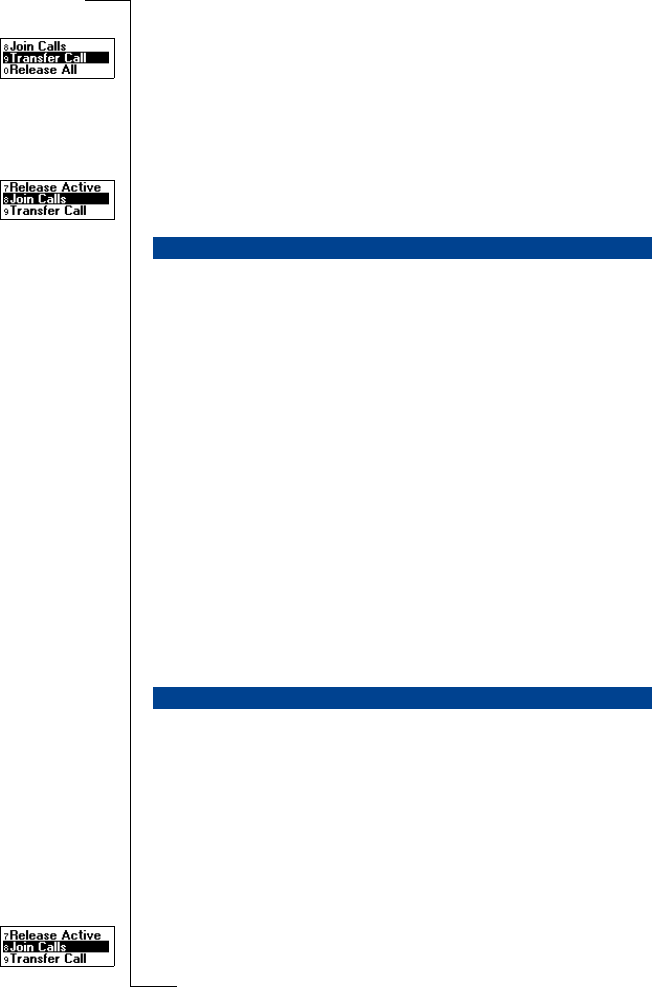
Handling More than One Call Simultaneously 67
Connect the two calls (Call Transfer)
•Scroll to
Call Handling
, YES,
Transfer Call
, YES.
The two calls are now connected to each other, and you are disconnected
from both calls.
Note! The Call Transfer service may not be available on all networks.
Join the two calls into a Conference Call
•Scroll to
Call Handling
, YES,
Join Calls
, YES.
See ‘Conference Calls’ below.
If the Call Waiting service is on, you may receive a third call when you have
one active call and a second call on hold. From now on, you cannot answer
any more calls without disconnecting one, if you do not want to create a
conference call. You hear a tone in the earpiece and Busy and Release&
answer appear in the display.
You can do one of the following:
End the current call and accept the waiting call
•Select
Release&answer
.
The waiting call becomes active and the call on hold remains on hold.
Reject the waiting call
•Select
Busy
.
The third call is rejected. Provided the caller’s network supports this
function, the caller hears a busy tone.
Create a conference call
•See below
Note! The Conference Call service may not be available on all networks.
A conference call is a call with more than two participants. As in an ordinary
conference, all participants can hear each other at the same time. You may
include up to five participants in a conference call.
Creating a Conference Call
To create a conference call, you must have one active call and one call on
hold.
To join the two calls into a conference call
•Scroll to
Call Handling
, YES,
Join Calls
, YES.
RECEIVING A THIRD CALL
CONFERENCE CALLS
Marianne.book Page 67 Friday, October 1, 1999 2:00 PM

68 Handling More than One Call Simultaneously
You have now created a conference call (with yourself, the former active
and held calls as participants).
Adding New Participants to the Conference Group
You may put the conference group on hold and then add new participants.
To add a new participant
1. Press YES to put the conference group on hold.
2. Call the next person you wish to include in the conference group.
3. Scroll to
Call Handling
, YES,
Join Calls
, YES.
You can include up to five participants in the conference group by
repeating steps 1 to 3 above.
To check the participants in the conference group
1. Scroll to
Call Handling
, YES,
Parties in Conf
, YES.
The first participant’s phone number is displayed, if available. If the par-
ticipant’s number and name are stored in your phone book, the name is
displayed instead. Otherwise the display shows part 1, 2 etc.
2. Scroll with é to check the other participants.
Having a Private Conversation with One of the Participants
If you wish to have a private conversation with one of the participants, you
may extract that participant from the conference and put the other participants
on hold.
To extract a participant
1. Scroll to
Call Handling
, YES,
Extract Part
, YES.
2. Select the participant that you want to extract.
To rejoin the participant to the conference group
•Scroll to
Call Handling
, YES,
Join Calls
, YES.
Releasing Participants from the Conference Group
You can release participants from the conference group one by one or all at
once.
To release a certain participant
1. Scroll to
Call Handling
, YES,
Release Part
, YES.
2. Select the participant that you want to release.
To release all participants
•Scroll to
Call Handling
, YES,
Release All
, YES.
Marianne.book Page 68 Friday, October 1, 1999 2:00 PM

Handling More than One Call Simultaneously 69
Making a Call while a Conference Call Is in Progress
You can put the conference group on hold and make another call. You can then
switch between the new call and the conference call.
To put the conference group on hold and make a new call
1. Press YES.
2. Enter the number you wish to call and press YES.
To switch between the new call and the conference group
•Press YES.
To end the new call and return to the conference group
•Press NO and then YES.
Ending the Conference Call
•Close the flip or press NO.
Marianne.book Page 69 Friday, October 1, 1999 2:00 PM

70 Setting Network Preferences
Setting Network
Preferences
When you turn on the phone, it searches for the last accessed network. If this
is not within range, you may use another network, provided your home
network has an agreement that allows you to do so. This is called roaming.
The order of preference in which the phone chooses a network is determined
by a list of preferred networks on your SIM card. Your phone includes a
number of functions that let you determine how it searches for a network. You
may also choose a network yourself from those within range.
To select a network
1. Scroll to
Settings
, YES,
Networks
, YES,
Select Network
, YES.
2. If there is more than one network within range, scroll to the network you
want and press YES to select it.
To start an automatic network search
•Scroll to
Settings
, YES,
Networks
, YES,
New Search
, YES.
The phone automatically starts searching for a network according to the
list of preferred networks stored on your SIM card.
Display Information
The currently used network is marked with a filled button. Together with the
network name, you also get the following information in the display:
SEARCHING FOR NETWORKS
The display shows... meaning...
You are in your home zone.
Does not appear on all networks.
The name of the network is included in a list of
preferred networks on your SIM card. You can use
this network.
The name of the network is included in a list of
forbidden networks on your SIM card. You may not
be allowed to use this network, except for emer-
gency calls.
Marianne.book Page 70 Friday, October 1, 1999 2:00 PM

Setting Network Preferences 71
All other networks without any icons are available, i.e. they are not included
in the preferred or forbidden list on your SIM card but they may be used.
The names of the forbidden networks are stored on your SIM card. If such a
forbidden network is within range, it is left out when the phone searches for a
network (automatic search mode).
If your home network and a forbidden network come to an agreement that
allows you to use the forbidden network, you can select this network even
though the message Forbidden is displayed.
You can create and edit a list that defines in which order your phone will
select a network during automatic network selection, when your home net-
work is not within range.
The number of networks that can be stored in the list depends on your SIM
card.
You can review the network list and rearrange the order of the networks.
You can also add new networks to the list and delete networks from it.
To review the list of networks
1. Scroll to
Settings
, YES,
Networks
, YES,
Preferred Nets
, YES.
The name of the first network is displayed.
Use ç or é to scroll through the networks in the list.
To see a network’s full name
1. Scroll to
Settings
, YES,
Networks
, YES,
Preferred Nets
, YES.
2. Scroll to a network and press YES.
3. Select
Full Name
.
To add a network to the list
1. Scroll to
Settings
, YES,
Networks
, YES,
Preferred Nets
, YES,
Add new?
, YES.
2. Scroll to the network that you want to add and press YES.
If the network you want does not appear in the list, scroll to
Other
and press
YES. Enter the three-digit country number and the two-digit network
number and press YES.
3. Enter a position number and press YES.
Note! All lower prioritized networks will be shifted one step down in the list.
FORBIDDEN NETWORKS
LIST OF PREFERRED NETWORKS
Marianne.book Page 71 Friday, October 1, 1999 2:00 PM
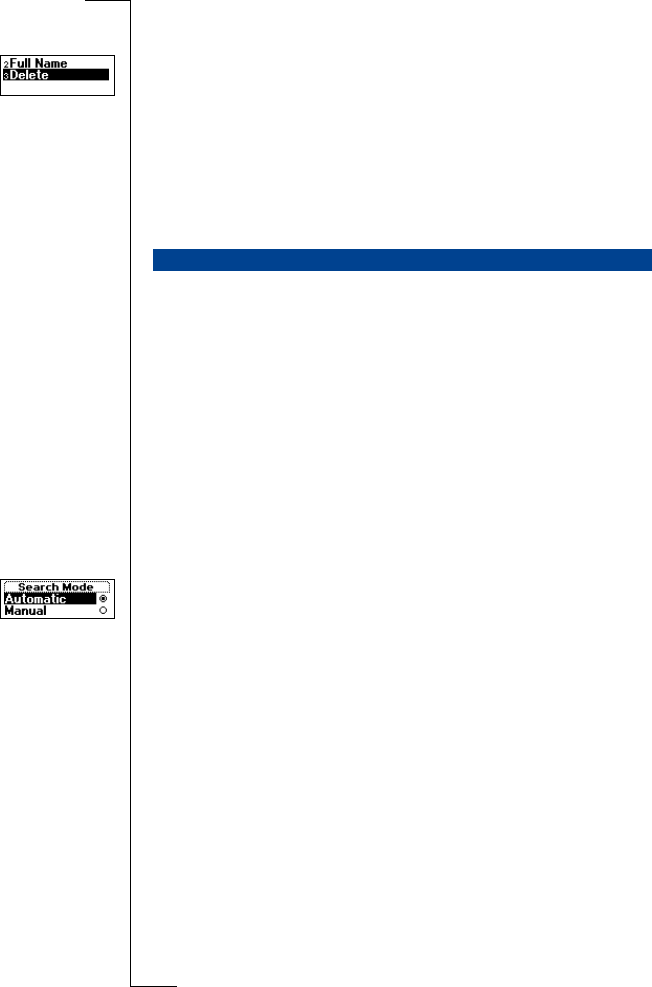
72 Setting Network Preferences
To delete a network from the list
1. Scroll to
Settings
, YES,
Networks
, YES,
Preferred Nets
, YES.
2. Scroll to the network that you want to delete and press YES.
3. Select
Delete
.
To rearrange the list
1. Scroll to
Settings
, YES,
Networks
, YES,
Preferred Nets
, YES.
2. Scroll to the network that you want to move and press YES.
3. Select
Change Priority
.
4. Enter the new position within the list and press YES.
When you turn on your phone, it searches for a network. This can be done in
two different ways, depending on the search mode that is on. When you buy
your phone it is set to automatic search mode.
Automatic search mode means that your phone searches for the last accessed
network first. If this is not available, it automatically searches for another
available network within range.
Manual search mode means that your phone searches for the last accessed
network first. If this is not available, the question Select net? appears. You
then need to choose a network as described in “Searching for Networks” on
page 70.
To turn on the automatic search mode
•Scroll to
Settings,
YES
, Networks
, YES,
Search Mode
, YES,
Automatic
, YES.
To turn on the manual search mode
•Scroll to
Settings
, YES,
Networks
, YES,
Search Mode
, YES,
Manual
, YES.
SEARCH MODES
Marianne.book Page 72 Friday, October 1, 1999 2:00 PM

Knowing the Call Time/Call Cost 73
Knowing the Call Time/
Call Cost
During a call, the duration of the call is shown in the display. When you end
the call, the call duration information is shown for another three seconds. If
you subscribe to cost information, the call cost (or the number of call units) is
displayed instead of the call duration.
The Call Info menu allows you to check the total time or cost of your calls.
To check the time/cost of the last call
•Scroll to
Call Info
, YES,
Last Call
, YES.
Now you can check the duration or cost (if you subscribe to cost
information) of the last call.
To check the time of your outgoing calls
•Scroll to
Call Info
, YES,
Outgoing Time
, YES.
To check the total call time
•Scroll to
Call Info
, YES,
Total Time,
YES.
To check the total call cost
•Scroll to
Call Info
, YES,
Total Cost
, YES.
To reset the total call time/call cost
1. Scroll to
Call Info
, YES,
Reset Counters
, YES.
2. Select
Total Cost
,
Total Time
or
Outgoing time
.
3. Press YES to reset the cost or time.
Note! If you subscribe to cost information, you must enter your PIN2 to clear
the cost or time counter.
The Tariff function lets you enter and specify the price per call unit. The price
entered is stored on your SIM card.
Note! This service must be supported by your subscription and your network.
TOTAL CALL TIME OR CALL COST
DETERMINING THE CALL COST
Marianne.book Page 73 Friday, October 1, 1999 2:00 PM

74 Knowing the Call Time/Call Cost
If you do not specify a price per call unit, the number of call units is displayed
during a call, and in Last Call and Total Cost in the Call Info menu.
To enter the price per call unit
1. Scroll to
Call Info
, YES
Options
, YES,
Set Tariff
, YES.
2. Enter your PIN2 and press YES.
3. Select
Change Tariff
.
4. Enter the code for the currency you want, for example GBP for Pound
Sterling, and then press YES.
5. Enter the price per call unit, for example 0.75, and press YES. To enter the
decimal point, press #.
To revert to call units
1. Scroll to
Call Info
, YES,
Options
, YES,
Set Tariff
, YES.
2. Enter your PIN2 and press YES.
3. Select
Units
.
If both your network and SIM card support this feature, you can enter a total
amount of money that can be used for making calls. This could be useful when
you lend your phone to someone and do not want their call costs to exceed a
certain amount which you can decide. After a call is made, the cost is
deducted from this amount. When the amount reaches zero, no more calls can
be made.
Note! As the price of a call may vary due to where you are calling from, at
what time of the day you are calling and so on, the credit limit is only an
estimated value.
To set a specific credit limit
1. Scroll to
Call Info
, YES,
Options
, YES,
Set Credit
, YES.
2. Enter your PIN2 and press YES.
3. Select
Change Credit
.
4. Enter the amount, for example 30 pounds, and then press YES.
To set unlimited credit
1. Scroll to
Call Info
, YES,
Options
, YES,
Set Credit
, YES.
2. Enter your PIN2 and press YES.
3. Select
Unlimited?
.
Note! If you set the credit to Unlimited, the cost counter starts from zero and
increases.
CREDIT LIMIT FOR CALLS
Marianne.book Page 74 Friday, October 1, 1999 2:00 PM
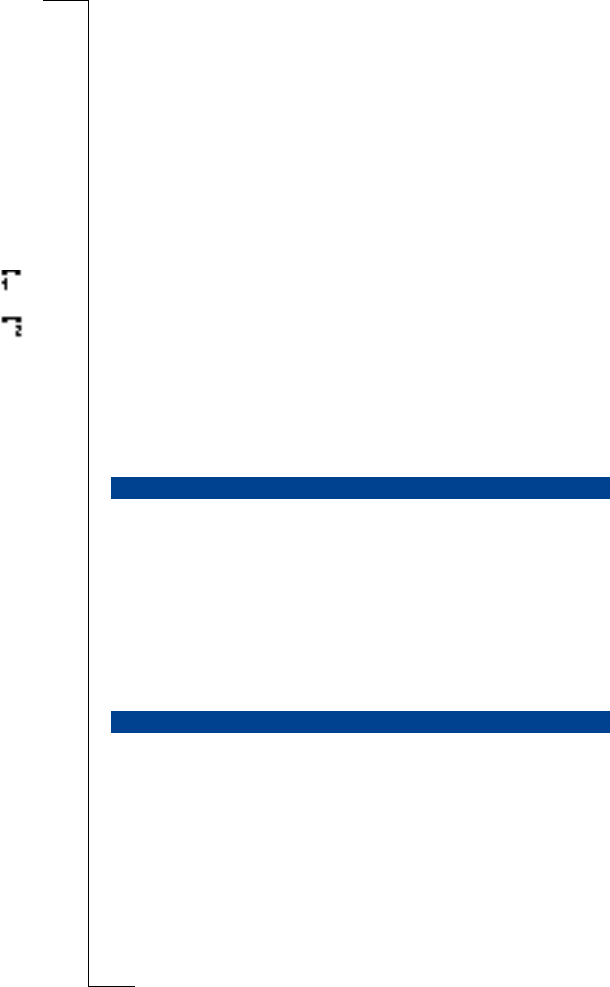
Using Two Voice Lines 75
Using Two Voice Lines
If your subscription supports the Two Line Service, your phone will have two
voice lines with different phone numbers, separate bills and perhaps different
subscription services. This is useful for example if you want to keep business
calls and private calls on separate lines.
When you buy your phone, the names of the lines are normally Line 1 and
Line 2, but you can change their names. You can only send text messages
(SMS) on Line 1. An icon indicates the line currently chosen for outgoing
calls.
To change the name of a line
1. Scroll to
Settings
, YES,
Display
, YES,
Edit Line Tags
, YES.
2. Select a line.
3. Enter a new name and press YES.
When you want to make a call, you need to choose which line to use.
Note! Incoming calls can be received on both lines, irrespective of the line
currently chosen.
To change phone lines
1. Scroll to
Call Handling
, YES.
2. Select
Switch to Line 1
or
Switch to Line 2
.
From now on, all outgoing calls are made on this line.
You may have different settings for each line, for example the ring signal or
divert calls.
Tip! You may also have separate Voice Mail numbers for each phone line, if
supported by your subscription.
Some operators may show the call time or call cost for each line respectively.
CHANGING PHONE LINES
DIFFERENT SETTINGS FOR EACH LINE
Marianne.book Page 75 Friday, October 1, 1999 2:00 PM

76 Voice Control
Voice Control
Your phone allows you to:
•voice dial - call someone by simply saying the name
•answer and reject calls using your voice when connected to a handsfree kit
To call someone, you only need to press YES until you hear a tone, say the
name (voice label) associated with that person and your phone automatically
dials the number. To answer or reject calls, say Answer or Busy.
When you buy your phone, voice dialling is set to on. If, for some reason, it
has been turned off, you will need to turn it on again before you can start using
it.
To turn Voice Dialling on
1. Scroll to
Settings
, YES,
Voice Control
, YES,
Voice Dialling
, YES.
2. Select
On
.
Your phone is now ready to record voice labels.
Note! Once you have turned voice dialling on, you are asked if you want to
record a voice label every time you save a new number in your phone book.
See “Saving a Number Together with a Name” on page 29.
Before you can use voice dialling, you need to record voice labels for your
phone book entries. To get a good result when recording voice labels, make
sure you are in a quiet environment.
To record voice labels for existing phone book entries
1. Scroll to
Phone Book
, YES,
Voice Labels
, YES,
Add voice?
, YES.
2. Select a phone book entry to which you want to add a voice label.
3. Wait for the tone and say the name (voice label) that you want to save.
The voice label is played back to you.
4. Press YES to save the voice label you have recorded.
If you do not find the recording OK, repeat step 3.
An icon appears next to those phone book entries for which you have saved a
voice label. You can save 10 voice labels in the phone.
You can also record voice labels in Find and Edit in the Phone Book menu.
PREPARING YOUR PHONE FOR VOICE DIALLING
Marianne.book Page 76 Friday, October 1, 1999 2:00 PM

Voice Control 77
Note! To use voice dialling with a vehicle handsfree unit, you need to record
your voice labels in the car, when connected to a vehicle handsfree.
Voice labels for phone book entries recorded in the phone will not be available
in the car, and vice versa. For more information about the Vehicle Handsfree
unit, see “Vehicle Handsfree” on page 94.
Recording Problems
If your phone cannot detect any speech, one of the following might have
happened:
•you spoke too softly - try speaking louder
•the voice label was too short - it should be around one second long
•you spoke too late or too soon - speak after the tone
Go back to step 1 of ‘To record voice labels for phone book entries’.
Listening to and Editing Voice Labels
Your phone allows you to listen to and edit a list of the phone book entries that
have voice labels.
To listen to and/or edit the voice labels saved in your phone book
1. Scroll to
Phone Book
, YES,
Voice Labels
, YES.
2. Scroll to the entry that you want to edit.
The voice label is played back to you.
3. Press YES.
4. Select
Replace Voice
if you want to re-record the voice label or select
Erase
Voice
if you want to erase the recorded voice label.
5. Continue according to the instructions.
You can also listen to and/or edit your voice labels in Find and Edit in the
Phone Book menu.
Voice Label Playback
If you have recorded a voice label for an entry in your phone book, the voice
label is played back to you in the following cases:
•when you move through the phone book or voice label list and reach
this entry
•when you receive a call from the number corresponding to this entry
•when you voice dial this entry (before the call is connected)
To make a call
1. Press and hold YES until you hear a tone.
2. Release YES and say a name that you have recorded earlier.
The name (voice label) is played back to you, and the call is connected.
MAKING CALLS USING YOUR VOICE
Marianne.book Page 77 Friday, October 1, 1999 2:00 PM

78 Voice Control
Instead of pressing and holding YES, as in step 1 above, you can slide and
hold the volume key when the flip is open. A third alternative is to initiate
voice dialling by just opening the flip, but then Start on Flip must be on.
To turn on Start on flip
1. Scroll to
Settings
, YES,
Voice Control
, YES,
Start on Flip
, YES.
2. Select
On
.
When Start on Flip is on, an icon appears in standby.
When connected to a portable or vehicle handsfree unit, you can answer or
reject incoming calls by using your voice.
Before you can use voice answering, you need to turn on the voice answering
function and record your voice commands.
To turn on Voice Answering
1. Scroll to
Settings
, YES,
Handsfree
, YES,
Voice Answer
, YES.
2. Select
On
.
You now have to train your phone to recognize your voice answering
commands.
3. Press YES to continue.
4. Follow the instructions in the phone display, i.e. say the word Answer and
press YES to save your recording. (Use the microphone of the Handsfree
unit.) If the recording was not OK, repeat step 3.
5. Say the word Busy and press YES to save your recordings.
Note! If you prefer, you can use other words instead of ‘Answer’ and ‘Busy’.
To answer an incoming call using your voice
• When the phone rings, say the word Answer.
The word Answer is played back to you and the call will be connected.
To reject an incoming call
• When the phone rings, say the word Busy.
The word Busy is played back to you, and the call is rejected, i.e. the caller
hears a busy tone.
Note! For more information about handsfree units, see “Portable Handsfree”
on page 93 and “Vehicle Handsfree” on page 94.
VOICE ANSWERING
Marianne.book Page 78 Friday, October 1, 1999 2:00 PM

Calling Card Calls 79
Calling Card Calls
When making international or long distance calls, you may not want your
operator to charge you for these calls on your normal account. If you have a
credit card or a calling card, you may want to redirect the charges to one of
these accounts instead. The Calling card service lets you redirect the charges
to either a credit card account or to a calling card account.
You can save two separate card numbers in your phone. These numbers are
protected by a four- to eight-digit phone lock code. When you buy your phone
the code is set to 0000. You may change the code to one that you choose your-
self. See “The Phone Lock” on page 59.
Note! You cannot use the Calling card service when making a fax or a data
call.
To be able to make calling card calls, you need to turn on the service.
To turn on the Calling card service
1. Scroll to
Phone Book
, YES,
Options
, YES,
Set CallingCards
, YES.
2. Enter your phone lock code (
0000
) and press YES.
3. Select
On
.
The Calling card service is now on and the sub-menu Calling Cards
is
available in the Phone Book menu.
You can save two calling card numbers in your phone.
To save a card number
1. Scroll to
Phone Book
, YES,
Calling Cards
, YES.
2. Enter your phone lock code and press YES.
3. Select
Add new?
.
4. Enter the access number of the calling card server and press YES.
5. Enter a name that you want to associate with your calling card server and
press YES.
6. Enter the verification code of the calling card server and press YES.
ACTIVATING THE CALLING CARD SERVICE
SAVING CALLING CARD NUMBERS
Marianne.book Page 79 Friday, October 1, 1999 2:00 PM

80 Calling Card Calls
7. Select whether you want to send the number that you want to call or
the verification code first and press YES to confirm your choice.
Note! Your service provider will give you the information needed for the
verification codes.
To delete a card number
1. Scroll to
Phone Book
, YES,
Calling Cards
, YES.
2. Scroll to the card number that you want to delete and press YES.
3. Select
Delete
.
The question
Delete?
appears in the display.
4. Press YES.
The card number has been deleted.
To edit a card number
1. Scroll to
Phone Book
, YES,
Calling Cards
, YES.
2. Scroll to the card number that you want to edit and press YES.
3. Select
Edit
.
You may now edit the card number.
4. Press YES to confirm the new number.
You may now also edit the name and code.
If you have saved two card numbers, you must choose which card you want to
use before making a calling card call.
To select a card
1. Scroll to
Phone Book
, YES,
Calling Cards
, YES.
2. Enter your phone lock code and press YES.
3. Select the card that you want to use.
4. Select
Activate card
.
1. Enter the phone number of your calling card server or retrieve it from the
Phone Book by pressing and holding é.
2. Press and hold YES.
The access number of the calling card server is called and during the
connecting phase, you are asked to send the phone number of the person
that you want to call and the verification code, in the order chosen earlier
(see above).
CHOOSING A CARD
MAKING A CALLING CARD CALL
Marianne.book Page 80 Friday, October 1, 1999 2:00 PM

Calling Card Calls 81
3. To send the number and verification code during the connecting phase,
press YES when the display shows
Send
or wait a few seconds and they are
sent automatically. Now you are connected to your personal phone call.
Marianne.book Page 81 Friday, October 1, 1999 2:00 PM

82 Sending and Receiving Fax and Data Calls
Sending and Receiving
Fax and Data Calls
Note! To be able to use various communications services you need the appro-
priate software such as a fax program, an e-mail program or an Internet
browser.
All fax and data calls are initiated from the appropriate computer software. To
send fax and data calls you need to connect your phone to a computer, for
example by means of an infrared modem and then start the appropriate soft-
ware program.
The procedure of receiving fax and data calls depends on your network and
subscription. If you have different numbers for voice, fax and data calls, this is
referred to as multi numbering. This means that you can have up to three
numbers in your subscription. If you only have one number for all call types,
this is referred to as single numbering.
Receiving Fax and Data Calls – Multi Numbering
If your network and subscription support multi numbering, the type of incom-
ing call is shown in the display. There are two possible calls apart from voice
calls:
•Fax calls
•Data calls
The display shows the type of call.
To receive a fax or data call
1. Connect your computer to the phone.
2. Answer the call from within the software program (if it does not answer
automatically).
Note! You cannot answer an incoming fax or data call by pressing the YES
key on the phone but you may reject the call by pressing NO.
SENDING FAX AND DATA CALLS
RECEIVING FAX AND DATA CALLS
Marianne.book Page 82 Friday, October 1, 1999 2:00 PM

Sending and Receiving Fax and Data Calls 83
Receiving Fax and Data Calls – Single Numbering
If you have a SIM card that does not support separate fax and data numbers,
the phone does not recognize the type of incoming call.
Next Incoming Call Type
If you want to receive a fax or data call you have to set the phone to one of
these options in the Next Incoming sub-menu. You only see this menu if your
phone detects that you do not have separate numbers for data, fax and voice.
Once you have set your phone for a specific incoming call, it stays like this
until you change it. The normal setting is Voice.
To set the next incoming call type
1. Scroll to
Call Handling
, YES,
Next Incoming
, YES.
2. Select the call type you want (Voice, Data or Fax).
Marianne.book Page 83 Friday, October 1, 1999 2:00 PM
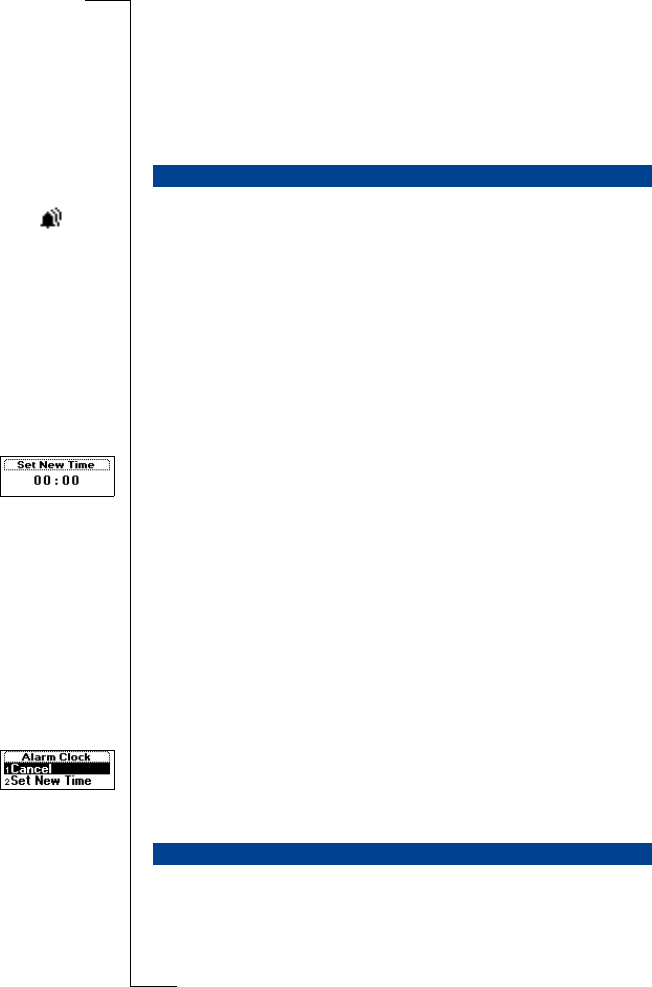
84 Extras
Extras
The phone has an alarm clock, which you may find useful when travelling.
When it is on, an icon is shown in the display.
The alarm rings at the time set and the display flashes, even if the phone is
turned off. The volume of the alarm signal is always increasing, provided the
battery is attached and charged.
The alarm rings for 60 seconds and is repeated every nine minutes, if you do
not turn it off. After 60 minutes, the repeat function is turned off
automatically.
To set the time of the alarm
1. Scroll to
Extras
, YES,
Alarm Clock
, YES.
2. Enter the time.
3. Press YES to confirm your setting.
To change the alarm time
1. Scroll to
Extras
, YES,
Alarm Clock
, YES,
Set New Time
, YES.
2. Enter the time.
3. Press YES to confirm your setting.
To turn the alarm signal off
•Press any key to turn the alarm off when it rings.
If you do not want the alarm to be repeated, press YES.
To turn off the alarm function
1. Scroll to
Extras
, YES,
Alarm Clock
, YES.
2. Select
Cancel
.
You can also find the Alarm Clock in Time and Date in the Settings menu.
The phone has a built-in calculator, which can add, subtract, divide and
multiply.
•Press # to get
+
,
-
,
x
,
/
.
•Press C to erase a figure to the left of the cursor.
ALARM CLOCK
CALCULATOR
Marianne.book Page 84 Friday, October 1, 1999 2:00 PM
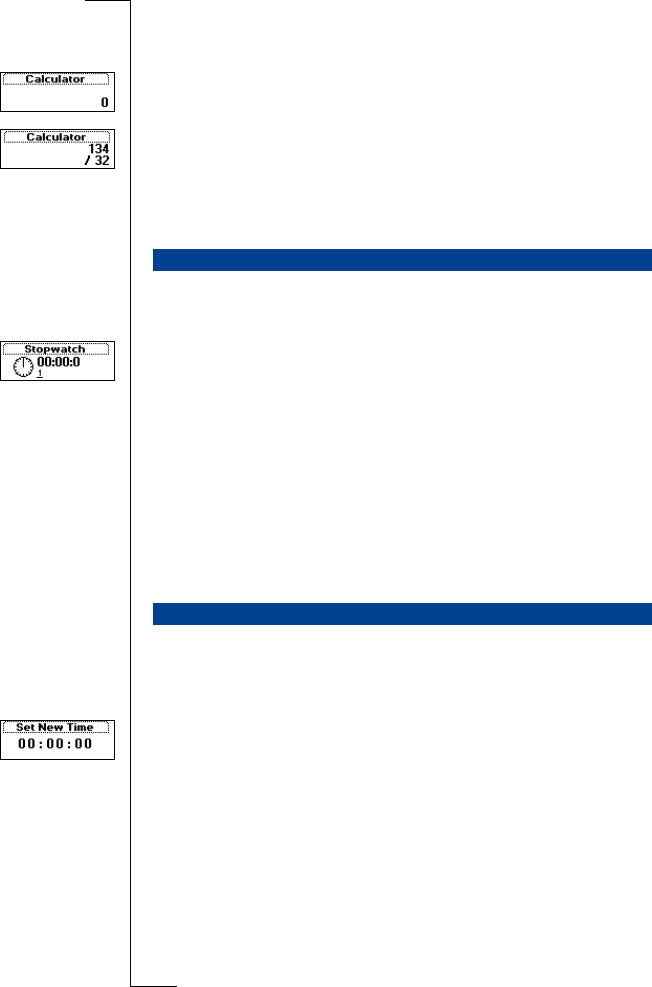
Extras 85
•Press * to enter a decimal point.
To use the calculator
In this example we are going to divide 134 by 32.
1. Scroll to
Extras
, YES,
Calculator
, YES.
2. Enter 134.
3. Press # repeatedly until the division sign (/) appears.
4. Enter 32.
5. Press YES to get the answer.
6. To clear the display, press C.
The phone has a built-in stopwatch for you to time a certain activity.
To run the stopwatch
1. Scroll to
Extras
, YES,
Stopwatch
, YES.
2. Press YES to start the stopwatch. Press YES again to stop it.
To reset the stopwatch
•Press C when the stopwatch is not running.
Tip! By pressing # when the stopwatch is running, you can store up to 9 lap
times. Press
ç
or
é
to check your stored lap times.
Note! If you receive an incoming call or voice or text message while the stop-
watch is running, the stopwatch is turned off. If you exit the stop watch menu
the stop watch is turned off.
The phone has a built-in 24-hour timer. You set the time you want and when
that time is out, an alert signal sounds.
To set the timer
1. Scroll to
Extras
, YES,
Timer
, YES.
2. Enter the time and press YES.
The countdown begins. The timer is shown in standby mode.
When the alert sounds, press any key to turn it off.
To set a new time when the timer is running
1. Scroll to
Extras
, YES,
Timer
, YES,
Set New Time
, YES.
2. Enter the time and press YES.
The countdown begins. The timer is shown in standby mode.
When the alert sounds, press any key to turn it off.
STOPWATCH
TIMER
Marianne.book Page 85 Friday, October 1, 1999 2:00 PM
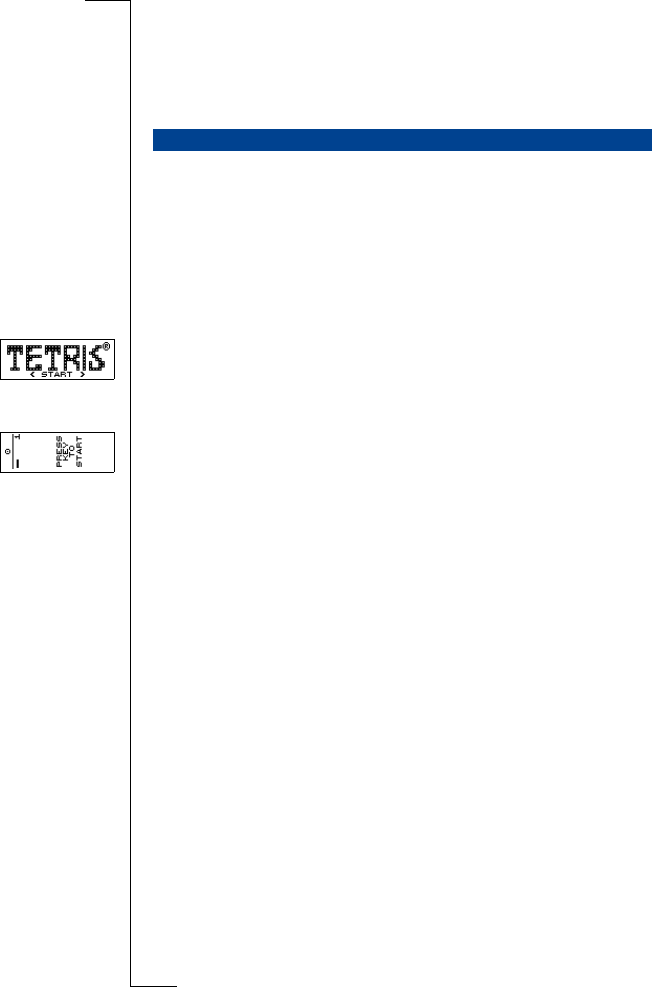
86 Extras
To turn off the timer
1. Scroll to
Extras
, YES,
Timer
, YES.
2. Select
Cancel
.
Note! The timer does not work when the phone is turned off.
Your phone has two different games for your enjoyment. There are help texts
available in each game as a guide for you to get started.
Tetris®
The object of Tetris is to prevent the blocks from reaching the top. Each time
you fill a line, the line disappears.
To start Tetris
1. Scroll to
Extras
, YES,
Games
, YES,
Tetris
, YES.
Tetris
appears in the display.
2. To start a game, select
Start
.
3. Select level (1–10).
4. Press any key to start.
•Instead of choosing Start you can scroll with é to select
High-score, Help or Quit (at step 2 above).
To control the game
•8 or slide the volume key downwards = move left
•2 or slide the volume key upwards = move right
•5 or 9 = rotate
•3 or 6 = drop faster
•C = pause
•NO = quit
Tetris®; © Elorg 1987. Classic Tetris™; © Elorg 1998
Tetris Logo by Roger Dean; © The Tetris Company 1997
All Rights Reserved
Solitaire
The object of Solitaire is to form four piles of cards, one per suit, running
from ace to king. The cards are dealt out into seven columns. The last six
columns have one or more cards facing downwards. If the top card in a
column is removed, revealing the face-down card, you may turn it face up.
Only kings, or stacks of cards beginning with a king may be moved to an
empty column.
GAMES
Marianne.book Page 86 Friday, October 1, 1999 2:00 PM

Extras 87
Columns of cards are built up in descending order and alternating colour. For
example, the eight of hearts may be placed on either the nine of clubs or
spades.
The remaining cards in the deck are available for play. You can turn these
cards one at a time. The card in the discard pile may be placed on the columns
or the ace piles. When you run out of cards in the deck, you can flip it over
and continue.
To start Solitaire
1. Scroll to
Extras
, YES,
Games
, YES,
Solitaire
, YES.
Solitaire
appears in the display.
2. To start a game select
New game
(or
Resume game
if you have played before).
•Instead of choosing Start you can scroll with é to select
Resume game or Help (at step 2 above).
To control the game
•1 = Select card/pile, Confirm move, Flip card
•2 = Turn up new card from game deck
•3 = Put card on ace pile
•4 = View a pile (selection and move is possible)
Marianne.book Page 87 Friday, October 1, 1999 2:00 PM

88 The Profile Concept
The Profile Concept
Your phone includes a number of pre-programmed profiles. A profile is a
group of settings which are set to suit a certain environment. For example,
when you go to a meeting, you can just choose the Meeting profile and a
number of settings that suit a meeting are set.
Some accessories can choose a profile automatically. For example, when you
place your phone in a vehicle handsfree unit, the In Car profile is chosen. For
more information on automatic activation of profiles. See “Accessories” on
page 91.
There are six pre-programmed profiles:
•Normal
•Meeting
•In Car
•Outdoors
•Port H-free
•Home
Your phone is always set to one of the six profiles. When you buy your phone,
it is set to the Normal profile. You cannot create more profiles, but you can
change the name of a profile, change the settings included in a profile or add
an accessory to a certain profile.
Note! You cannot change the name of the ‘Normal’ profile and you cannot
add an accessory to the ‘Normal’ profile.
For information on how to add an accessory to a profile, see “Adding Acces-
sories to a Profile” on page 97.
Tip! To find out which profile you are using, slide the volume key upwards or
downwards in standby mode.
The table below shows the settings of each profile.
THE PROFILES
Normal Meeting In Car Outdoors Port H-free Home
Ring Volume
5(6) 0(6) 6(6) 6(6) 6(6) 5(6)
Increasing Ring
Off Off Off Off Off Off
Marianne.book Page 88 Friday, October 1, 1999 2:00 PM

The Profile Concept 89
You can always choose a profile manually.
To select a profile manually
1. Scroll to
Settings
, YES,
Profiles
, YES,
Select Profile
, YES.
2. Select the profile you want.
You can also find Select Profile in the My Shortcuts menu. The quickest way
to reach this sub-menu is to press and hold ç.
If you choose a profile other than Normal, an icon is shown in standby.
Note! A profile which is not associated with any accessory, such as ‘Meeting’
or ‘Normal’, must be chosen manually, even if automatic activation is on. The
profiles associated with accessories can be chosen automatically. See “Acces-
sories” on page 91.
You can re-name the pre-programmed profiles and change the settings
according to your wishes.
To change the name of a profile
1. Scroll to
Settings
, YES,
Profiles
, YES,
Profile Name
, YES.
2. Enter a new name and press YES.
To change a profile setting
1. Scroll to
Settings
, YES,
Profiles
, YES,
Edit
Profile
, YES.
A list of the profile settings appears.
2. Select a setting by pressing YES.
3. Change the profile setting according to your wishes.
For information, see the relevant chapters “Personalizing Your Phone” on
page 39, “Security for Your Phone and Subscription” on page 58,
Vibrating Alert
On On if silent Off On On Off
Accept Calls
From All From All From All From All From All From All
Divert Calls
Off Off Off Off Off Off
Calling Cards
None None None None None None
Light
Auto Auto On Auto Auto Auto
Line 1/2
L1 L1 L1 L1 L1 L1
Silent
Off On Off Off Off Off
Auto Activation
Off Off On Off On Off
Accessories
- - Vehicle HF - Handsfree -
CHANGING THE PROFILE SETTINGS
Normal Meeting In Car Outdoors Port H-free Home
Marianne.book Page 89 Friday, October 1, 1999 2:00 PM

90 The Profile Concept
“Calling Card Calls” on page 79 and “Accessories” on page 91.
If you change a setting which is included in a certain profile, the profile is
updated. With the Reset Profiles function, you can change all profile settings
back to the way they were set when you bought your phone.
To reset the profile settings
1. Scroll to
Settings
, YES,
Profiles
, YES,
Reset Profiles
, YES.
The profile settings are reset.
Marianne.book Page 90 Friday, October 1, 1999 2:00 PM

Accessories 91
Accessories
By using your T28 WORLD together with Ericsson original accessories, you
have access to a large range of useful features, in addition to those you have
when the phone is used separately.
•Automatic divert of incoming calls when the phone is placed in a desktop
charger
•Portable handsfree calling
•Handsfree calling in your car
•Infrared communication between your phone and computer
Note! This is on condition that the specific accessories exist in your market.
The Profiles concept, see “The Profile Concept” on page 88, allows you to
instruct your phone to activate a specific profile automatically when used
together with a certain accessory. On the following pages you can find infor-
mation on how different accessories interact with your phone and its different
profiles.
Note! You are informed of the current profile when you slide the volume key
upwards or downwards in standby mode or when you choose another profile.
Every time you disconnect your phone from the accessory, the profile is
changed to the one which was active before, if the current profile was
activated automatically.
For the profiles associated with an accessory to change automatically, the
automatic activation must be on. When you buy your phone, the automatic
activation is set to On for the Vehicle and Portable handsfree units. If you
wish, you may turn it off.
To turn automatic activation on or off
1. Scroll to
Settings
, YES,
Profiles
, YES,
Auto Activation,
YES.
2. Select
On
or
Off
.
Note! You can always choose a profile manually, even if a profile has been
activated automatically. See “The Profiles” on page 88.
Marianne.book Page 91 Friday, October 1, 1999 2:00 PM

92 Accessories
If you use the T28 WORLD with a specific Ericsson Desktop Charger you
have access to some useful features besides ordinary charging. You can
choose to make the phone switch to the Home profile automatically and divert
all calls to your home number when you place your phone in the charger.
To be able to use these features, you need to make some settings the first time
you place your phone in the desktop charger.
Placing the Phone in the Desktop Charger
Note! For further instructions on how to connect the desktop charger, please
contact your local Ericsson retailer.
To associate the desktop charger with a profile and a divert number
1. Place the phone in the desktop charger. The message
Choose profile?
appears
in the display.
2. Press YES. (If you press NO, the desktop charger will not be associated
with any profile).
3. Select a profile that you want to associate with the desktop charger, for
example the Home profile.
4. The message
Divert when connected to accessory?
appears. Press YES.
This means that you want to divert your calls to your home number when,
for example, you place the phone in the desktop charger.
(If you press NO, your calls will not be diverted).
DESKTOP CHARGER
1. Place the phone in the desktop
charger as shown and press
backwards to attach the phone.
2. Pull the phone towards you and
upwards to detach the phone
from the charger.
Marianne.book Page 92 Friday, October 1, 1999 2:00 PM

Accessories 93
5. Enter a phone number including the area code (for example, your home
number) and press YES.
A number you used before may be suggested to you. If so, press YES to
choose the number, or enter another number.
6. The message
Automatic activation on?
appears. Press YES.
The message
Profile: Home
appears to confirm your choice.
You can also make these settings later, if you wish. In this case, you need to
add the desktop charger to the Home profile, or another profile. See “To add
an accessory to a profile” on page 97. You may set the divert number in the
Edit Profile sub-menu, where all profile settings are included (
Settings
, YES,
Profiles,
YES,
Edit Profile
, YES). See “Changing the profile settings” on page 89.
Note! The phone must be switched on and the automatic activation must be on
for the phone to switch profile automatically when connected to an accessory.
Tip! If you have several desktop chargers, they can each be added to a profile
or they can all be added to the same profile.
When you connect a specific Ericsson Portable Handsfree to the
T28 WORLD, the Port H-free profile is set automatically. This means that all
profile settings are set to the values specified for the Port H-free profile. See
“The Profile Concept” on page 88.
Tip! If you do not want your phone to switch profile automatically when you
connect it to the Portable Handsfree, you need to turn the Auto activation off.
To do this, manually select the ‘Port H-free’ profile, and set the Auto activa-
tion to off.
Using the Portable Handsfree
To answer an incoming call
•When the phone rings, press the button on your Portable Handsfree once.
Tip! You can also answer a call by using your voice. See “Voice Answering”
on page 78.
To end a call
•Press the button on your Portable Handsfree once.
If the Call Waiting service is on, see “The Call Waiting Service” on page 65,
you can answer a second call by pressing the button on your Portable Hands-
free.
PORTABLE HANDSFREE
Marianne.book Page 93 Friday, October 1, 1999 2:00 PM
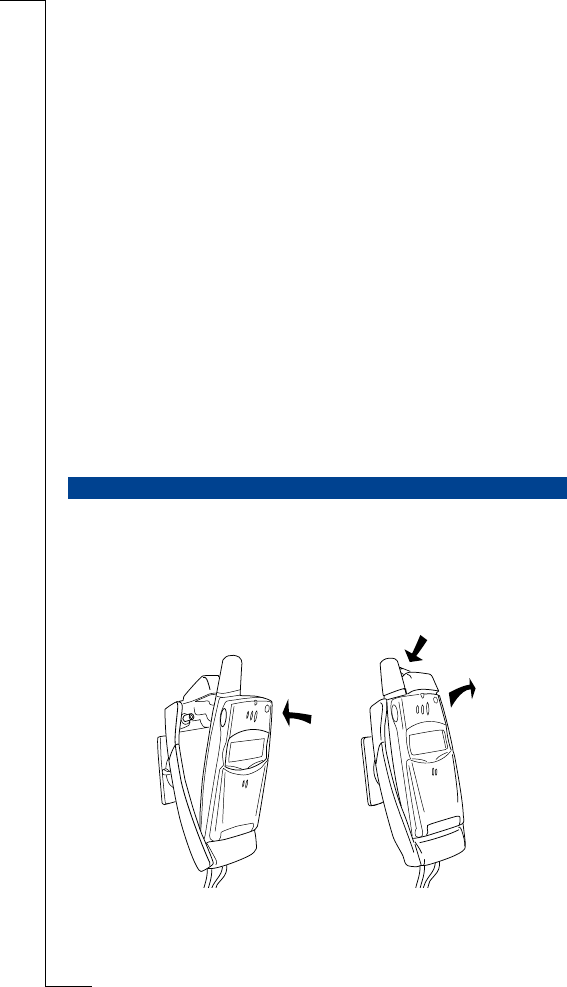
94 Accessories
To answer a second call
•Press the button on your Portable Handsfree once to answer the waiting
call.
The current call is now put on hold.
When you press the button on your Portable Handsfree again, the second
call is disconnected and the first call is retrieved automatically.
To voice dial using the Portable Handsfree
1. Press and hold the button on your Portable Handsfree until you hear a
tone.
2. Release the button and say a name (voice label) that you have recorded
previously.
The name is played back to you and the call is connected.
Note! Before you can use voice dialling, you need to record voice labels for
entries in your phone book. See “Preparing your Phone for Voice Dialling”
on page 76.
For best performance when voice dialling and voice answering with a
Portable Handsfree unit, we recommend recording your voice labels when
connected to a Portable Handsfree unit.
When you connect an Ericsson Advanced Vehicle Handsfree to the
T28 WORLD, the In Car profile is set automatically. This means that all pro-
file settings are set to the values specified for the In Car profile. See “The
Profile Concept” on page 88.
Placing the Phone in the Vehicle Handsfree
VEHICLE HANDSFREE
1. Place the phone in the
holder as shown and press
backwards to attach it.
2. Press the button on top of
the holder to release the
phone.
Marianne.book Page 94 Friday, October 1, 1999 2:00 PM

Accessories 95
Tip! If you do not want your phone to switch profile automatically when you
connect it to the Advanced Vehicle Handsfree, you need to turn the Auto
Activation off. To do this, manually select the ‘In Car’ profile and set the Auto
Activation to off.
Note! Your Advanced Vehicle Handsfree should be installed by professional
personnel. For more information, please contact your local Ericsson retailer.
Voice Control
The Advanced Vehicle handsfree unit is equipped with its own voice control
system which allows you to:
•voice dial - call someone by simply saying the name
•answer and reject calls using your voice
Before you can use voice dialling, you need to record voice labels to entries in
your phone book and the Voice Dialling function needs to be on. See “Pre-
paring your Phone for Voice Dialling” on page 76. To use voice dialling with
the Vehicle Handsfree unit, you need to record the voice labels in the car.
Voice labels for phone book entries recorded in the phone will not be available
in the car, and vice versa.
The vehicle handsfree can store up to 100 voice labels. The icons for the
phone book entries with voice labels saved when connected to a vehicle
handsfree kit look slightly different from those that you save in the phone, see
margin.
To voice dial using the Vehicle Handsfree
1. Slide and hold the volume key (when the flip is closed) or press YES until
you hear a tone.
2. Release and say a name (voice label) that you recorded in the car earlier.
(Use the microphone of the Vehicle Handsfree unit.)
The name is played back to you, and the call is connected.
To answer a call using your voice
•See “Voice Answering” on page 78.
If you use a Vehicle Handsfree Unit, you can choose between two different
ways in which your phone can handle speech. This is done in the Handsfree
sub-menu.
Basic Handsfree
Basic Handsfree means that the phone handles the call in semi-duplex mode.
This means that you cannot speak at the same time as the person at the other
HANDSFREE TYPES
Marianne.book Page 95 Friday, October 1, 1999 2:00 PM

96 Accessories
end of the line. Use this alternative only if Full Handsfree does not work
properly.
Full Handsfree
Full Handsfree means that the phone handles the call in full duplex mode.
This considerably increases the quality of speech, since you do not have to
wait until it is your turn to speak.
For Full Handsfree to work properly, your phone adapts to the sound
environment around the handsfree equipment. This adaptation might take a
few calls. During this learning phase, the person you are talking to might hear
an echo of his or her own voice (because the sound goes from the speaker into
the microphone again). However, this disappears as the other person speaks.
If the echo lasts longer than the first few calls, try Basic Handsfree instead.
Tip! Set the handsfree type to ‘Full Handsfree’ first. If speech quality is poor,
set the ‘Basic Handsfree’ type instead.
To set the handsfree type
1. Scroll to
Settings
, YES,
Handsfree
, YES,
Handsfree Type
, YES.
2. Select the type you want.
When using a Portable or Vehicle Handsfree unit, you may choose to answer
incoming calls with Any Key or Auto.
•Any Key: If you use the phone with handsfree equipment and this function
is turned on, you can answer an incoming call by pressing any key, except
the NO key.
•Auto: If you choose the automatic answering mode, an incoming call is
answered automatically after one ring signal, if the phone is used with
handsfree equipment.
To set an answering mode
1. Scroll to
Settings
, YES,
Handsfree
, YES,
Answering Mode
, YES.
2. Select a mode.
If you choose the Normal alternative, you have to answer calls as normal.
Tip! You can also answer calls by using the Voice Answering function. See
“Voice Answering” on page 78.
ANSWERING MODE
Marianne.book Page 96 Friday, October 1, 1999 2:00 PM
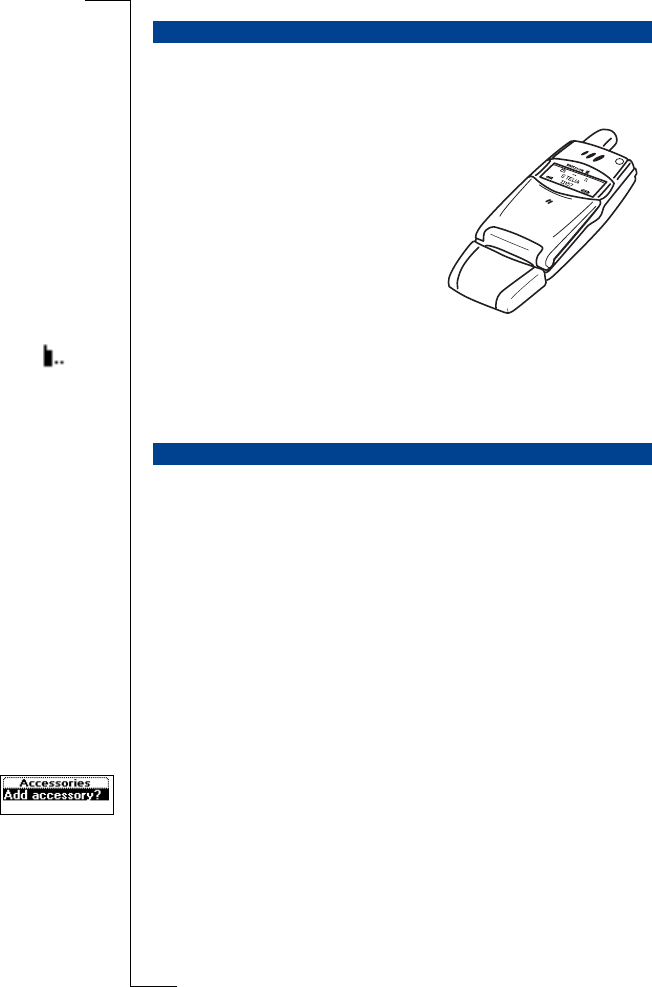
Accessories 97
With an Ericsson infrared modem you can connect your T28 WORLD to a
computer via an infrared link. This makes the cable and PC card obsolete.
When you have connected the infrared modem to the phone, an icon appears
in the display.
Note! For more information, please contact your local Ericsson retailer.
You can add one or more accessories to a profile. For example, if you usually
use a portable handsfree together with a specific desktop charger, you can add
the desktop charger to the Port H-free profile. The phone recognizes the first
accessory when it is connected and switches profile automatically.
Note! Only profiles associated with accessories can be activated automati-
cally. Apart from the desktop charger and the portable and vehicle handsfree
units, you can also add an infrared modem to a profile.
Before you can add an accessory to a profile, you must choose the profile
manually to which you want to add the accessory. See “To select a profile
manually” on page 89.
To add an accessory to a profile
1. Scroll to
Settings
, YES,
Profiles
, YES,
Accessories
, YES.
Now you are in the list of the accessories which have already been added
to the profile.
2. Select
Add accessory?
.
Now you are in the list of all accessories that you can add to the profile.
3. Select an accessory.
4. The question
Automatic activation on?
appears, if automatic activation is not
on already.
INFRARED MODEM
ADDING ACCESSORIES TO A PROFILE
If you want to use the infrared modem
with a computer that is running Win-
dows 95/98/NT 4.0, you can install PC
software which allows you to manage
the phone book in your mobile phone,
send and receive SMS messages, fax and
data calls, edit your mobile phone’s set-
tings, browse the Internet or connect to
your corporate network.
Marianne.book Page 97 Friday, October 1, 1999 2:00 PM

98 Accessories
Press YES to turn automatic activation on, which means that the profile
will be chosen automatically when the accessory is connected.
Note! In addition to the portable and vehicle handsfree units, you can add
another 12 accessories to a profile. Any accessory above this number will
work as ordinary non-profile accessories. You cannot have the same acces-
sory associated with several profiles.
To remove an accessory from a profile
1. Scroll to
Settings
, YES,
Profiles
, YES,
Accessories
, YES.
2. Scroll to the accessory that you want to remove and press C.
3.
Delete?
appears. Press YES.
Marianne.book Page 98 Friday, October 1, 1999 2:00 PM

Online Services 99
Online Services
Imagine that you hear about a new service that your network operator is
offering. You call your operator, explain that you want to subscribe to the
service and suddenly, within seconds, you have a new menu in your phone
that instantly lets you use the new service.
You do not need upgraded software for your phone, but you may need to visit
your network operator to get a new SIM card. The rest is all taken care of over
the air.
This is just one example of the added value services that are made possible
through the ‘Online Services’.
Note! The T28 WORLD does not support all services offered by the Online
Services.
The Online Services is the network operators’ way of offering
customized services, independently of mobile phones and mobile phone
manufacturers.
Compatibility
Added value services based on the Online Services require two things in order
to work:
•a mobile phone that supports the Online Services. Your Ericsson
T28 WORLD is such a phone.
•a network operator offering the Online Services.
Note! The Online Services on the SIM are designed and run by network oper-
ators and not by mobile phone manufacturers. If you require further
information about the Online Services, please contact your network operator.
A SIM card which supports the Online Services works in the same way as a
normal SIM card.
When you have inserted your SIM card and turned on your phone, your net-
work operator may download data to your SIM card. After the first data down-
WHAT IS ONLINE SERVICES?
NEW MENU
Marianne.book Page 99 Friday, October 1, 1999 2:00 PM

100 Online Services
load and after restarting your phone, the proactive SIM offers a new menu in
the phone. The menu offers you new features and services, which can be used
instantly.
On your T28 WORLD, this menu appears under the Extras menu. There can
only be one new sub-menu entry under the main menu, but there can be sev-
eral sub-menus under the new sub-menu entry.
To enter your new menu system
1. Scroll to
Extras
, YES,
Online Services
, YES.
If any sub-menus appear, select the one that you want and press YES.
2. Press NO to go back to the standby menu.
Note! Some operators may not use the name Online Services for this menu.
Please consult your network operator for more information.
The Online Services provides a proactive SIM. This means that the SIM can
tell the phone to take certain actions. These actions could include:
•showing text from the SIM in the phone’s display
•setting up a call to a number on the SIM
•initiating a dialogue with the user
Note! All these actions are taken by the SIM card and, consequently, they have
nothing to do with the phone’s software.
Your network operator may at any time download new data to your SIM card
over the air. This new data could consist of new features or a new menu.
Resetting your SIM Card
When the operator updates your SIM card over the air, the phone notifies you
by showing a message in your display. You also hear a beep.
In order for your new SIM settings to take effect, you have to turn off your
phone and then turn it on again.
Note! After a data download the phone may not work and you will not be able
to use it until you restart it. This feature is operator dependent and will proba-
bly not happen very often.
The SIM card may prompt you to make a call. This could happen even if you
are already engaged in a call.
PROACTIVE SIM
DATA DOWNLOAD TO THE SIM OVER THE AIR
SIM CARD INITIATED FEATURES
Marianne.book Page 100 Friday, October 1, 1999 2:00 PM

Online Services 101
When this happens, the phone will notify you by producing a sound and
showing a message in the display.
•If you are not engaged in a call, a message is shown in the display, asking
you whether you want to confirm and make the SIM card initiated call.
•If you want to make the SIM card initiated call, press YES.
•If you do not want to make the SIM card initiated call, press NO.
•If you are already engaged in a call, you are asked either to put the current
call on hold or to end it.
A message appears in the display, asking you whether you want to confirm
and make the SIM card initiated call.
•If you want to make the SIM card initiated call, press YES.
•If you do not want to make the SIM card initiated call, (you may want
to continue with the ongoing call) press NO.
Send a SIM Card Initiated SMS
The SIM card may set up an SMS (text message) and ask you to send this
message, for example by the question Send now?. Press YES if you want to
send the SMS.
All services and functions that come with the Online Services are
network dependent. Please contact your network operator for details of
services offered by the Online Services.
DETAILS OF SERVICES OFFERED
Marianne.book Page 101 Friday, October 1, 1999 2:00 PM

102 Online Services
Marianne.book Page 102 Friday, October 1, 1999 2:00 PM

104 Quick Keys
Quick Keys
Several keys on your phone can be used to optimize the phone’s functionality
and decrease the number of times you need to press a key. Some of the key
combinations demand that your phone is in a certain mode and some can be
made from the standby mode.
The table describes some of the most useful key combinations.
To... Do this: Mode:
enter the Call List press YES when in standby
voice dial press and hold YES when in standby
voice dial slide and hold the volume
key upwards or downwards
when in standby and
when the flip is open
call your Voice Mail press and hold 1when in standby
enter the + sign to
make an international
phone call
press and hold 0when in standby
set the phone silent press and hold Cwhen in standby
mute the microphone press and hold down Cduring a call
reach a phone book
entry press the position number
and #when in standby
reach a phone book
entry beginning with a
specific letter
press and hold any of the
keys 2-9when in standby
speed dial press any of the number
keys 1-9 and YES
when in standby
enter Find and Call press and hold éwhen in standby
put a call on hold press YES during a call
retrieve a call press YES again during a call
reject a call quickly slide the volume key
upwards or downwards twice when receiving a call
enter the menu system press ç or éwhen in standby
move through menus
or lists slide (and hold) the volume
key upwards or downwards when in the menus
select a menu or
setting press YES when in the menus
delete an item press and hold Cwhen in lists
go back to standby press and hold NO when in the menus
Marianne.book Page 104 Friday, October 1, 1999 2:00 PM

Quick Keys 105
A quick way to move through the menus is to use shortcuts. You simply enter
the number of the menu or sub-menu to which you want to go. See “Using
Shortcuts” on page 23 and “To set the key sound” on page 24.
To quickly and easily reach the settings you use most, you can place your
favourite settings in the menu My Shortcuts. See “My Shortcuts” on page 25.
For more information about key functions, see “Key Functions” on page 12,
“Moving through the Menus” on page 23 and “Entering Letters” on page 28.
enter the first sub-menu
of the My Shortcuts
menu
press and hold çwhen in standby
find out which profile
you are using slide the volume key
upwards or downwards when in standby
change the language
to Automatic press ç 8888 éwhen in standby
change the language
to English press ç 0000 éwhen in standby
reach the second letter
or character of a key slide the volume key
upwards and press any
of the number keys
when entering letters
reach the third letter
or character of a key slide the volume key
downwards and press
any of the number keys
when entering letters
change between lower-
and upper-case letters press and hold *when entering letters
enter numbers press and hold any of the
number keys when entering letters
enter a space press 1 once when entering letters
enter a question mark slide the volume key
downwards and press 1when entering letters
enter the @-sign slide the volume key
downwards and press 0when entering letters
enter a
p
(pause) press and hold *when saving codes
erase letters and
numbers press Cwhen entering letters
and numbers
To... Do this: Mode:
Marianne.book Page 105 Friday, October 1, 1999 2:00 PM

106 Troubleshooting
Troubleshooting
This chapter lists some problems that you might encounter while using your
phone. Some problems require that you call your service provider, but most of
the problems you encounter are easy to correct yourself.
Insert Card
There is no SIM card in the phone or you may have inserted it incorrectly.
Insert a SIM card. See “The SIM Card” on page 5.
Insert Correct Card
The phone is set to only work with certain SIM cards. Insert the correct SIM
card.
SOS Calls Only
You are within range of a network but you are not allowed to use it. However,
in an emergency, some operators allow you to call the international emergency
number 112 (or 911 in the Americas). See “Making Emergency Calls” on
page 14.
No Network
There is no network within range or the received signal is too weak. You have
to move to get a signal that is strong enough.
Wrong PIN, Wrong PIN2
You have entered your PIN or PIN2 incorrectly.
•Enter the correct PIN or PIN2, and press YES.
See “The SIM Card Lock” on page 58.
Codes do not match
When you want to change a security code (for example your PIN) you have to
confirm the new code by entering it again. The two codes that you have
entered do not match. See “The SIM Card Lock” on page 58.
PIN/PIN2 Blocked
You have entered your PIN or PIN2 incorrectly three times in a row. To
unblock, see “The SIM Card Lock” on page 58.
ERROR MESSAGES
Insert card
Insert correct card
SOS calls only
No network
Wrong PIN
Codes do not
match
PIN blocked
Marianne.book Page 106 Friday, October 1, 1999 2:00 PM
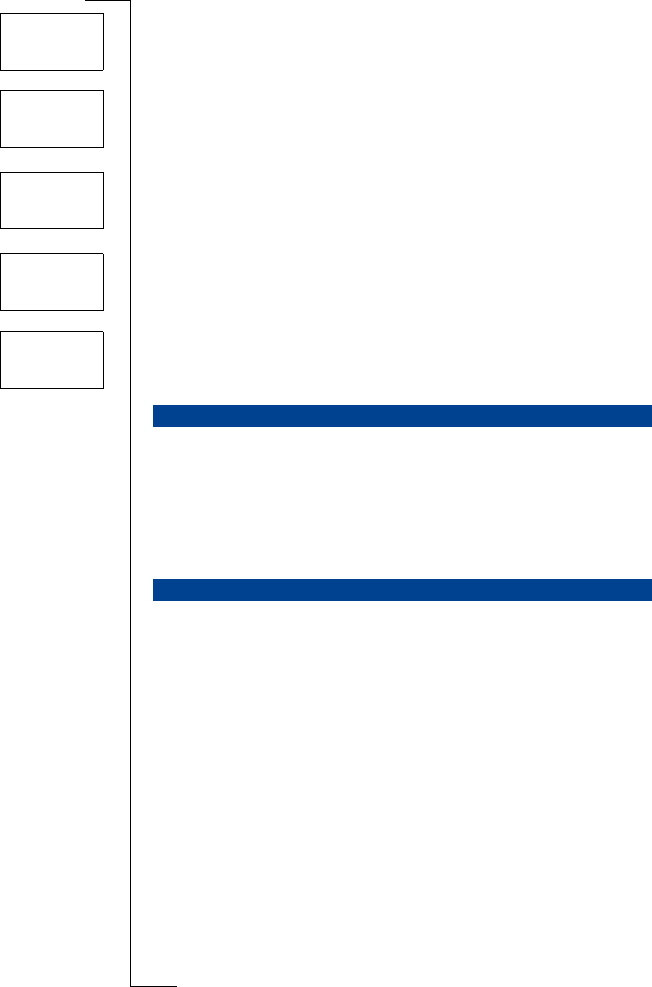
Troubleshooting 107
Blocked Contact Operator
You entered your personal unblocking key code (PUK) incorrectly 10 times in
a row. Contact your network provider or service operator.
Phone Locked
The phone is locked. To unlock the phone, see “The Phone Lock” on page 59.
Phone Lock Code:
Your phone comes with the phone lock code, 0000. You can change it to any
four-to eight-digit code. See “The Phone Lock” on page 59.
Number not Permitted
The Fixed Dialling function is on and the number you have dialled is not part
of your fixed numbers list. See “Fixed Dialling” on page 61.
Alien Battery - Slow Charging Only
The battery you are using is not an Ericsson-approved battery and is charging
slowly for safety reasons.
Handheld Phone
•Recharge or replace the battery. See “The Battery” on page 6.
Handsfree Phone in Vehicle
•Make sure that the phone is properly inserted into its holder. See “Vehicle
Handsfree” on page 94.
No Indication of Charging
When you start charging a battery that is empty or a battery that has not been
used for a long time, it may take a while until the indicator on the top of the
phone shows a red light and the battery meter appears. Only then can you
switch on and use your phone.
No Indication of Missed Calls
To be able to see if you have missed a call, the Call List must be on.
THE PHONE CANNOT BE SWITCHED ON
OTHER PROBLEMS
Blocked
Contact operator
Phone locked
Phone lock code:
Number not
permitted
Alien battery -
Slow charging only
Marianne.book Page 107 Friday, October 1, 1999 2:00 PM

108 Ericsson Mobile Internet
Ericsson Mobile Internet
When you are on the move and in need of communication and information,
the Mobile Internet is the answer.
The Mobile Internet is a service supplied by Ericsson to make it easier for you
to communicate and receive information quickly, wherever you are. It gives
you access to various messaging services, on-line customer services, user
manuals and other useful information. With the Mobile Internet you can also
download communications software to ensure you get the best out of your
Ericsson products.
The Ericsson Mobile Internet address is
http://mobileinternet.ericsson.com
Marianne.book Page 108 Friday, October 1, 1999 2:00 PM

Technical Data 109
Technical Data
HUMIDITY
General
Product name T28 WORLD
System GSM 900/GSM1900
SIM card Small plug-in card, 3V or 5V type
Type number 110 1101-BV
Dimensions
Size 95 x 49 x 15 mm
Weight with Ultra Slim battery 83g
Weight without battery 60g
Ambient temperatures
Max +55°C
Min -10°C
Marianne.book Page 109 Friday, October 1, 1999 2:00 PM

110 Glossary
Glossary
Advice of Charge (AoC)
enables you to monitor the cost of calls made from your mobile phone. Details
of the last call and total calls made are shown in the phone
display. To use this service, it must be supported by your network.
Area Information (AI)
is a service that allows you to receive messages about pre-set topics i.e.
weather forecasts, road reports, etc. To use this service, it must be supported
by your network.
Calling Line Identification (CLI)
shows the number of the person calling you in your mobile phone display. You
can then make an informed choice as to whether or not to take the call. Bear in
mind that not all numbers can be displayed. To use this service, it must be sup-
ported by your network.
Divert
enables you to forward calls to another number, for example your voice mail
or home phone.
DTMF or Touch Tone
Dual Tone Multi Frequency signal – codes sent as tone signals. Used for tele-
phone banking, for accessing an answering machine, etc.
Dual Band GSM 900/1900
The Ericsson T28 WORLD is a dual band phone, which means that you can
use your phone on two different kinds of networks – the GSM 900 and the
GSM 1900 systems.
The switching between the two systems is down automatically at initial power
up. When you turn on the phone, the phone automatically scans the network to
identify if it is a GSM900 or a GSM1900 network.
The difference compared to Ericssons GSM900/1800 phones is that the
T28 WORLD does not provide seamless handover during conversation.
Seamless handover is not a useful feature in this dual band product since there
Marianne.book Page 110 Friday, October 1, 1999 2:00 PM

Glossary 111
are no networks in the world that are GSM900/1900 systems.
Enter
is used for keying in letters or numbers from the keypad.
Fixed Numbers
enables you to allow only numbers beginning with certain pre-defined figures
to be dialled from your mobile phone. The service is protected by your PIN2.
To use this service, it must be supported by your network.
Full Duplex
in handsfree equipment, means that both parties on the phone can talk at the
same time. The opposite is simplex mode when one party talks and the other
must wait for his/her turn.
Fax Class
Standards for fax transmission are set as classes. Class I and II allow data
transfer speeds of between 2400 up to 9600 bps.
GSM 900
GSM is the world's most widely-used digital network, now operating in over
100 countries around the world, particularly in Europe and Asia-Pacific.
The Global System for Mobile Communications is the most-widely used dig-
ital mobile phone system. The GSM systems family also includes GSM 1800
and GSM 1900. There are different phases of roll-out for the GSM system and
GSM phones are either phase 1 or phase 2 compliant.
GSM 1900
is a digital network working on a frequency of 1900 MHz. It is used in the
Americas.
International (+) sign
mobile phone (+) sign that automatically adds the correct international code in
front of a telephone number when dialling out of a country. You then have to
enter the code of the country you are calling.
International Roaming
a mobile phone feature that allows you to switch between networks offering
coverage abroad. Your mobile phone automatically selects a network or sys-
tem (your home network), but if it is not in range or unavailable, it selects
another system. International roaming is based on agreements between net-
work operators in different countries.
Marianne.book Page 111 Friday, October 1, 1999 2:00 PM

112 Glossary
Line 1/Line 2
see Two Line Service.
Menu System
is where you can access all the phone’s functions. The menus can be accessed
and viewed by scrolling with the arrow keys.
Network
a mobile phone network or system consists of a network of cells or areas. A
radio base station serves each cell from where calls are forwarded to and
received from your mobile phone by wireless radio signals.
Network Operator
to be able to use your phone, you need a subscription to a network. You get
this subscription from a network operator, together with a SIM card that you
need to use with your phone.
Phone Book
a memory in your mobile phone or SIM card where phone numbers can be
stored and accessed by name or position.
PC-Card
also called PCMCIA, the PC-card can act as a modem and connect your
mobile phone to a laptop or organizer, enabling data and fax transmission. The
thin type II card is the most common size.
PIN
Personal Identification Number – a code used for all GSM-based phones to
establish authorization for access to certain functions or information. The PIN
code comes with your subscription.
PIN2
Personal Identification Number 2 – an authorization code which is used only
for special services. The PIN2 code comes with your subscription.
PUK
Personal Unblocking Key Code – used to unlock a blocked SIM card. This
comes with your subscription.
Restrict Calls
enables you to restrict or bar certain or all types of calls to and from your
mobile phone, i.e. outgoing calls, outgoing international calls, incoming calls.
Barring is switched on with a personal code. To use this service, it must be
supported by your network.
Marianne.book Page 112 Friday, October 1, 1999 2:00 PM

Glossary 113
Roaming
Within your home network, this means that your mobile phone automatically
sets up communication procedures with different radio base stations when on
the move.
Scroll
move between the menus and functions by pressing ç or é.
Select
choose a menu or function by pressing the YES key.
Semi-Duplex
In handsfree equipment, full duplex means that the connection is open for
both parties to talk simultaneously. The opposite, simplex, is when it is open
to one at a time. Semi-duplex gives close to, but not complete, duplex
functionality.
Service Provider
a company that provides services and subscriptions to mobile phone users.
Short Message Service (SMS)
allows messages of up to 160 characters to be sent and received via the net-
work operator's message centre to your mobile phone. Messages are stored if
the phone is off or out of reach ensuring that they reach you. To use this serv-
ice, it must be supported by your network.
SIM card
Subscriber Identity Module card – a card that must be inserted in any GSM-
based mobile phone. It contains subscriber details, security information and
memory for a personal directory of numbers. The card can be a small plug-in
type or credit card sized but both types have the same functions. The
T28 WORLD uses the small plug-in card.
Subscription
is the contract that you have with the service/network provider. To use your
phone, you need to have a subscription to a network. You get a SIM (Sub-
scriber Identity Module) card with your subscription. The services included in
your subscription depend on your choice of operator and/or subscription. So
some of the services and functions described in this manual may not be acces-
sible to you. If you want a complete list of the services included in your sub-
scription, please contact your network operator.
Marianne.book Page 113 Friday, October 1, 1999 2:00 PM

114 Glossary
Two Line Service
enables you to have two lines and two different phone numbers on one
subscription for your mobile phone. This makes it possible to have separate
numbers for business and personal calls. To use this service, it must be sup-
ported by your network.
Marianne.book Page 114 Friday, October 1, 1999 2:00 PM

Guidelines for Safe and Efficient Use 115
Guidelines for Safe
and Efficient Use
Note! Read this information before using your mobile phone.
Your mobile phone is a highly sophisticated electronic device. To get the most
out of your mobile phone read this text about product care, safe and efficient
use.
•Keep your mobile phone dry.
•Avoid exposing your mobile phone to extreme hot or cold temperatures.
•Avoid placing your mobile phone close to lit candles, cigarettes, naked
flames or any heat source.
•As with all sophisticated electronic devices rough treatment could damage
your mobile phone.
•Only use a soft damp cloth to clean your mobile phone.
•Do not paint your mobile phone as the paint could obstruct the earphone,
microphone or any moveable parts and prevent normal use.
•Do not attempt to disassemble your mobile phone, a broken warranty seal
will void the warranty. The phone does not contain consumer serviceable
components. Service should only be performed by Certified Service
Partners.
•Only use Ericsson original accessories. Failure to do so may result in loss
of performance, damage to the phone, fire, electric shock or injury. The
warranty does not cover product failures which have been caused by use of
non-Ericsson original accessories.
•Treat your mobile phone with care, keep it in a clean and dust free place.
•To avoid impaired performance please ensure your mobile phone's
antenna is not bent or damaged.
•Do not remove the antenna yourself. If your phone's antenna is damaged
please take it to a Certified Service Partner.
PRODUCT CARE AND MAINTENANCE
PRODUCT CARE
ANTENNA CARE AND REPLACEMENT
Marianne.book Page 115 Friday, October 1, 1999 2:00 PM
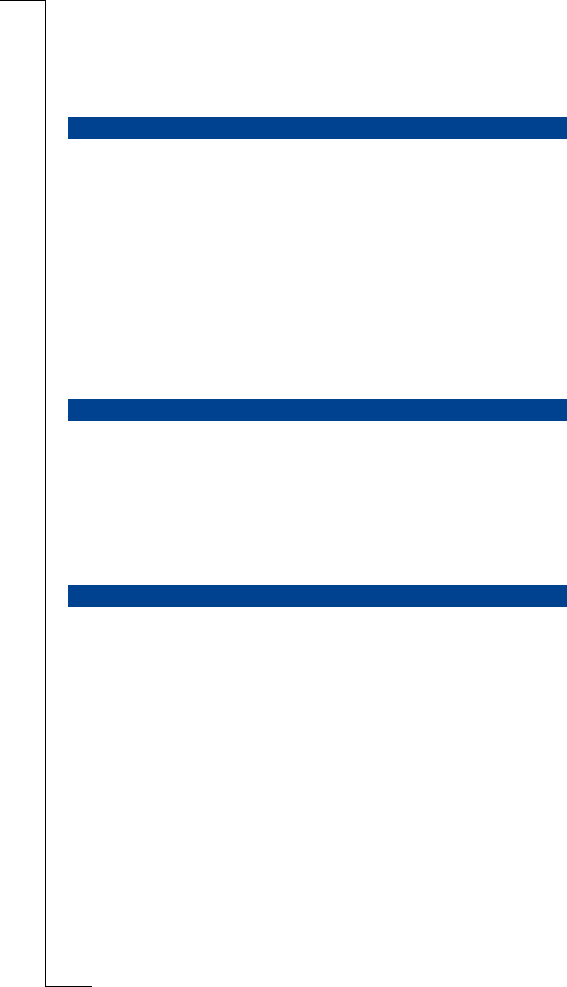
116 Guidelines for Safe and Efficient Use
•Only use an antenna that has been specifically designed for your phone.
Unauthorised antennas, modifications, or attachments could damage the
phone and may violate the appropriate regulations causing loss of per-
formance and radio frequency (RF) energy above the recommended limits.
To enjoy optimum performance with minimum power consumption please:
•Hold the phone as you would any other telephone. While speaking directly
into the mouthpiece, angle the antenna in a direction up and over your
shoulder. If the antenna is extendable/retractable, it should be extended
during a call.
•Do not hold the antenna when the phone is in use. Holding the antenna
affects call quality, may cause the phone to operate at a higher power level
than needed and shorten talk and standby times. If your mobile phone is
equipped with an infrared eye, never direct the infrared ray at anyone's eye
and make sure that it does not disturb any other infrared units.
Your mobile phone is a radio transmitter and receiver. When the phone is
turned on, it receives and transmits radio frequency (RF) energy. Depending
on the type of mobile phone you possess, it operates on different frequency
ranges and employs commonly used modulation techniques. The system that
handles your call when you are using your phone controls the power level at
which your phone transmits.
The International Commission on Non-Ionising Radiation Protection
(ICNIRP), supported by the World Health Organisation (WHO), published
during1996 a statement and in 1998 guidelines which set recommended limits
for exposure to RF fields from handheld mobile telephones. According to
ICNIRP statement, which is based on the available body of research, there is
no evidence that mobile terminals meeting the recommended limits can cause
any adverse health effects. All Ericsson telephones conform to the ICNIRP
guidelines and other international exposure standards, such as:
•CENELEC European Pre-standard ENV50166-2:1995 (Europe)
•ANSI/IEEE C95.1-1992 (USA, Asia-Pacific)
•AS/NZS 2772.1 (Int):1998 (Australia, New Zealand)
EFFICIENT PHONE OPERATION
RADIO FREQUENCY ENERGY
EXPOSURE TO RADIO FREQUENCY ENERGY
Marianne.book Page 116 Friday, October 1, 1999 2:00 PM

Guidelines for Safe and Efficient Use 117
Check the laws and regulations on the use of mobile phones in the areas where
you drive. If you are going to use your phone while driving, please:
•Give full attention to driving.
•Use an Ericsson Vehicle Handsfree Solution, if available. Law in many
countries requires vehicle Handsfree Solution. Read the installation
instructions carefully before installing a vehicle Handsfree Solution.
•Pull off the road and park before making or answering a call if driving
conditions so require.
RF energy may affect some electronic systems in motor vehicles such as car
stereo, safety equipment etc. In addition, some vehicle manufacturers do not
allow use of mobile phones, unless the installation is supported by a handsfree
kit with an external antenna, in their vehicles. Check with your vehicle manu-
facturer's representative to be sure that your mobile phone will not affect the
electronic systems in your vehicle.
Vehicles Equipped with an Air Bag
An air bag inflates with great force. Do not place objects, including either
installed or portable wireless equipment, in the area over the air bag or in the
air bag deployment area. If in-vehicle wireless equipment is improperly
installed and the air bag inflates, serious injury could result.
Most modern electronic equipment, for example equipment in hospitals and
cars, is shielded from RF energy. However, certain electronic equipment is
not, therefore:
•Do not use your mobile phone near medical equipment without requesting
permission.
Mobile phones may affect the operation of some implanted cardiac pace-
makers and other medically implanted equipment. Pacemaker patients should
be aware that the use of a mobile phone very close to a pacemaker might
cause the device to malfunction. Avoid placing the phone over the pacemaker,
i.e. in your breast pocket. When using the phone, place it at your ear opposite
the pacemaker. If a minimum distance of 15 cm is kept between the phone and
the pacemaker, the risk of interference is limited. If you have any reason to
suspect that interference is taking place, immediately turn off your phone.
Contact your cardiologist for more information.
DRIVING
ELECTRONIC DEVICES
Marianne.book Page 117 Friday, October 1, 1999 2:00 PM
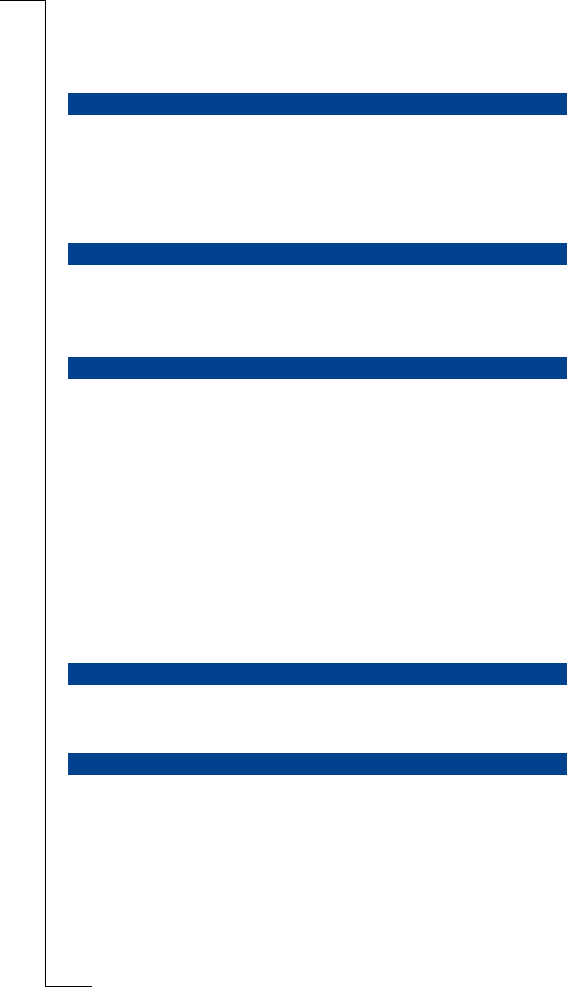
118 Guidelines for Safe and Efficient Use
Some hearing aids might be disturbed by mobile phones. In the event of such
disturbance, you may want to consult your service provider, or call the cus-
tomer services line to discuss alternatives.
•Turn off your mobile phone before boarding any aircraft.
•Do not use it on the ground without crew permission.
To prevent interference with communication systems, you must not use your
mobile phone while the plane is in the air.
Turn off your mobile phone when in a blasting area or in areas posted “turn
off two-way radio” to avoid interfering with blasting operations. Construction
crews often use remote control RF devices to set off explosives.
Turn off your mobile phone when in any area with a potentially explosive
atmosphere. It is rare, but your phone or its accessories could generate sparks.
Sparks in such areas could cause an explosion or fire resulting in bodily injury
or even death.
Areas with a potentially explosive atmosphere are often, but not always,
clearly marked. They include fuelling areas, such as petrol stations, below
deck on boats, fuel or chemical transfer or storage facilities, and areas where
the air contains chemicals or particles, such as grain, dust, or metal powders.
Do not transport or store flammable gas, liquid, or explosives in the compart-
ment of your vehicle, which contains your mobile phone and accessories.
This phone is designed for an operating temperature range of –10 °C to
+55 °C. Operation guaranteed at this range.
•Connect AC (Power supply) only to designated power sources as marked
on the product.
•To reduce risk of damage to the electric cord, remove it from the outlet by
holding onto the AC adapter rather than the cord.
•Make sure the cord is positioned so that it will not be stepped on, tripped
over or otherwise subjected to damage or stress.
•To reduce risk of electric shock, unplug the unit from any power source
before attempting to clean it.
AIRCRAFT
BLASTING AREAS
POTENTIALLY EXPLOSIVE ATMOSPHERES
OPERATING TEMPERATURE
POWER SUPPLY
Marianne.book Page 118 Friday, October 1, 1999 2:00 PM

Guidelines for Safe and Efficient Use 119
•The charger must not be used outdoors or in damp areas.
Do not allow children to play with your mobile phone since it contains small
parts that could become detached and create a choking hazard.
IMPORTANT!
This phone, like any mobile phone, operates using radio signals, cellular and
landline networks as well as user-programmed functions, which cannot guar-
antee connection under all conditions. Therefore you should never rely solely
upon any mobile phone for essential communications (for example medical
emergencies).
Remember, in order to make or receive calls the phone must be switched on
and in a service area with adequate cellular signal strength. Emergency calls
may not be possible on all cellular phone networks or when certain network
services and/or phone features are in use. Check with your local service
provider.
New Batteries
The battery delivered with your phone is not fully charged.
Battery Use and Care
A rechargeable battery has a long service life if treated properly. A new
battery, or one that has not been used for a long period of time could have
reduced capacity the first few times it is being used.
•The talk and standby times depend on the actual transmission conditions
when using the phone. If the phone is used nearby a base station less
power is required and talk and standby times are prolonged.
•Use only Ericsson original batteries and the AC/DC adapter supplied with
your battery charger. Using non original Ericsson accessories could be
dangerous and the warranty does not cover product failures which have
been caused by use of non-Ericsson original accessories.
•Do not expose your battery to extreme temperatures, never above +60°C
(+140°F). For maximum battery capacity use your battery in room temper-
ature. If the battery is used in cold temperatures the battery capacity will
be reduced.
•The battery can only be charged when the temperature is between +5°C
(+41°F) and +45°C (+113°F).
•Turn off your phone before removing the battery.
CHILDREN
EMERGENCY CALLS
BATTERY INFORMATION
Marianne.book Page 119 Friday, October 1, 1999 2:00 PM

120 Guidelines for Safe and Efficient Use
•Use only the battery for the intended purpose.
•Do not attempt to take a battery apart.
•Do not let the metal contacts on the battery touch another metal object.
This could short-circuit and damage the battery.
•Do not expose a battery to open flames. This could cause the battery to
explode.
•Do not expose a battery to liquid.
•Do not allow the battery to be placed into the mouth. Battery electrolytes
may be toxic if swallowed.
The battery must be disposed of properly and should never be placed in
municipal waste. Check local regulations for proper disposal instructions.
RECYCLING YOUR BATTERY
Marianne.book Page 120 Friday, October 1, 1999 2:00 PM
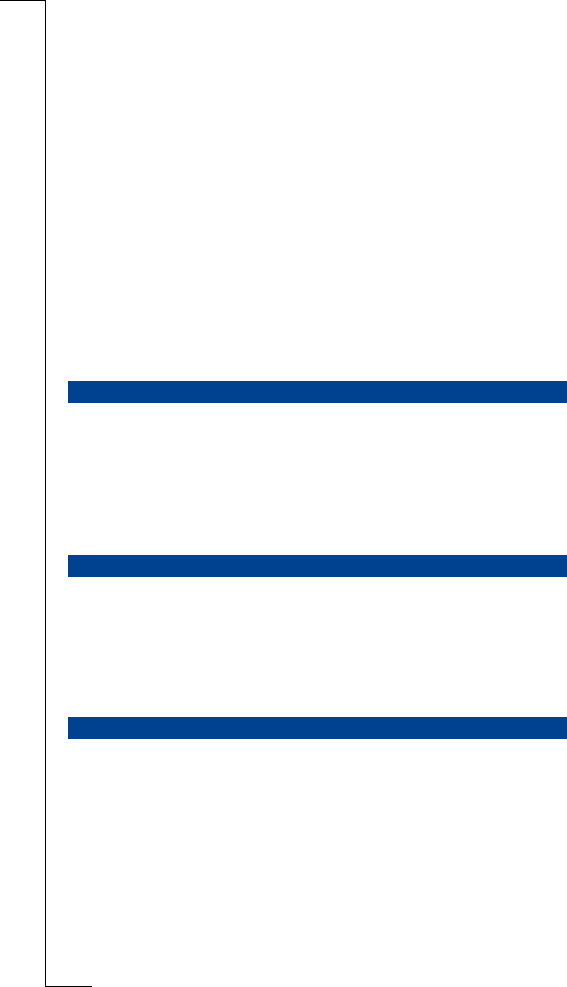
Warranty 121
Warranty
Thank you for purchasing this Ericsson Product. To get maximum use of the
features of your new product we recommend that you follow a few simple
steps:
•Read the Guidelines for safe and efficient use.
•Read all the terms and conditions of your Ericsson Warranty.
•Save your original receipt. You will need it for warranty repair claims.
Should your Ericsson Product need warranty service, you should return it
to the dealer from whom it was purchased or contact your local Ericsson
helpdesk to get further information.
Ericsson warrants this Product to be free from defects in material and work-
manship at the time of its original purchase by a consumer, and for a subse-
quent period of one (1) year.
All accessories for the Product are covered by a warranty for a period of one
(1) year from the date of its original purchase by a consumer.
If, during the warranty period, this Product fails to operate under normal use
and service, due to improper materials or workmanship, Ericsson subsidiaries,
authorised distributors or authorised service partners will, at its option, either
repair or replace the Product in accordance with the terms and conditions
stipulated herein.
1. The warranty is valid only if the original receipt issued to the original
purchaser by the dealer, specifying the date of purchase and serial number,
is presented with the product to be repaired or replaced. Ericsson reserves
the right to refuse warranty service if this information has been removed or
changed after the original purchase of the product from the dealer.
2. If Ericsson repairs or replaces the Product, the repaired or replaced Prod-
uct shall be warranted for the remaining time of the original warranty
period or for ninety (90) days from the date of repair, whichever is longer.
Repair or replacement may be via functionally equivalent reconditioned
OUR WARRANTY
WHAT WE WILL DO
CONDITIONS
Marianne.book Page 121 Friday, October 1, 1999 2:00 PM

122 Warranty
units. Replaced faulty parts or components will become the property of
Ericsson.
3. This warranty does not cover any failure of the Product due to normal
wear and tear, misuse, including but not limited to use in other than the
normal and customary manner, in accordance with Ericsson´s instructions
for use and maintenance of the Product, accident, modification or adjust-
ment, acts of God, improper ventilation and damages resulting from liquid.
4. This warranty does not cover product failures due to repair installations,
modifications or improper service performed by a non-Ericsson authorised
service workshop or opening of the product by non-Ericsson authorised
persons.
5. The warranty does not cover product failures which have been caused by
use of non-Ericsson original accessories.
6. Batteries are warranted only if battery capacity falls below 80% of rated
capacity. This warranty becomes void if the batteries are charged by non-
Ericsson original battery chargers.
7. Tampering with any of the seals on the products will void the warranty.
8. THERE ARE NO OTHER EXPRESS WARRANTIES, WHETHER
WRITTEN OR ORAL, OTHER THAN THIS PRINTED LIMITED
WARRANTY. ALL IMPLIED WARRANTIES, INCLUDING WITH-
OUT LIMITATION THE IMPLIED WARRANTIES OR MERCHANTA-
BILITY OR FITNESS FOR A PARTICULAR PURPOSE, ARE
LIMITED TO THE DURATION OF THIS LIMITED WARRANTY. IN
NO EVENT SHALL ERICSSON BE LIABLE FOR INCIDENTAL OR
CONSEQUENTIAL DAMAGES OF ANY NATURE WHATSOEVER,
INCLUDING BUT NOT LIMITED TO LOST PROFITS OR COMMER-
CIAL LOSS. TO THE FULL EXTENT THOSE DAMAGES CAN BE
DISCLAIMED BY LAW.
Some countries do not allow the exclusion or limitation of incidental or conse-
quential damage, or limitation of the duration of implied warranties, so the
preceding limitations or exclusions may not apply to you. This warranty gives
you specific legal rights, and you may also have other rights which may vary
from country to country.
Marianne.book Page 122 Friday, October 1, 1999 2:00 PM

Declaration of Conformity 123
Declaration
of Conformity
We, Ericsson Mobile Communications AB of
Nya Vattentornet
221 83 Lund, Sweden
declare under our sole responsibility that our product
Ericsson type 110 1101-BV
to which this declaration relates, conforms to the appropriate standards
TBR 19, TBR 20, TBR31, TBR32, ETS 300 342-1 and EN 60950,
following the provisions of Teleterminals directive 91/263/EEC,
EMC directive 89/336/EEC, and Low voltage directive 73/23/EEC.
Stockholm June 8, 1999
(Place & date of issue)
Marianne.book Page 123 Friday, October 1, 1999 2:00 PM

124 Declaration of Conformity
Marianne.book Page 124 Friday, October 1, 1999 2:00 PM

Index 125
Index
A
Accept calls 63
Add accessories to a profile 97
Alarm 84
Alarm indicator 11
Alarm signal 42
Answered calls indicator 35
Answering calls 15
Answering mode 96
Answering service. See Voice Mail
Area information 53
message types 54
receiving area messages 55
Assembling the phone 5
B
Banking by phone 32
Barring calls. See Restrict calls
Battery 6
attaching 6
charging 6, 7
detaching 6
Bell. See Alarm indicator
C
Calculator 84
Call barring. See Restrict calls
Call cost 73
setting a credit limit 74
specifying price per unit 73
Call divert
activating 56
Call list
calling from call list 35
using the call list 35
Call restrictions. See Restrict calls
Call time 73
Call waiting 65
Call waiting service
activating 65
cancelling 65
Calling
from call list 35
Calling card
making a call 80
saving number 79
Calling card services
activating 79
Calling Line Identification (CLI) 35
Calls
answering 12, 15
making 13
putting on hold 16, 65, 66, 68, 69
receiving 14
redialling 13
rejecting 15
switching between calls 66
CB. See Area information
Cell broadcast. See Area information
Changing phone lines 75
Charging 6, 7
disconnecting the charger 8
Choosing a card 80
Clock. See Time
Closed user groups 62
Conference calls 67
adding new participants 68
creating 67
extracting a participant 68
releasing a participant 68
reviewing participants 68
Credit card
making a call 80
saving number 79
D
Date 44
format 45
setting 45
Marianne.book Page 125 Friday, October 1, 1999 2:00 PM

126 Index
Desktop charger 92
Dialled numbers indicator 35
Display
greeting text 43
language 10, 43
light 43
Display information 11
Divert Calls 56
activating 56
checking status 57
divert indicator 11, 57
incoming calls 56
Divert calls
cancelling 57
Divert indicator 11, 57
DTMF tones 16
Dual Band 110
E
Emergency calls 14
Error messages 106
F
Fax, sending and receiving 82
Features 20
Fixed dialling 61
activating 62
Fixed numbers 62
editing 62
storing 62
Flip 13, 69
G
Games 86
Glossary 110
Greeting text in the display 43
H
Handsfree usage 95
Help functions 25
Hide my number 36
I
Indicators in display 35
alarm 11
answered calls 35
battery meter 11
dialled numbers 35
divert 11
line 11
missed calls 11, 35
signal strength meter 11
silent ring 11
SMS 11
Infrared modem 97
Initial settings 10
International calls 14
International emergency number 14
K
Key functions 12
Keypad 4
L
Language in the display 10, 43
Letters, entering 28
Line
chosing a line 75
Line indicator 11
M
Making a call 13
Menu system 21
display text 24
moving through 23
shortcuts 25
Message signal 41
Message types (SMS) 49
Microphone
muting 16
Minute minder 42
Missed calls 36
Missed calls indicator 11, 35
Muting microphone 16
N
Name label 29
Marianne.book Page 126 Friday, October 1, 1999 2:00 PM

Index 127
Network
forbidden networks 71
preferences 70
preferred networks 71
search modes 72
selecting 70
Note Pad 17
O
Online services 99
Overview 4
P
Personal ring signal 40
Phone book 27
checking status of memory 34
creating 27
edit a phone number 30
e-mail addresses 34
entering letters 28
erasing phone number 31
groups 33
international numbers 27
keeping up to date 30
memory 27
memory full 31
overwrite protection 31
shortcuts 30
Phone lock 59
activating/cancelling 60
auto lock 59
changing the security code 60
full lock 59
Phone number
displaying own 44
Phone number in SMS
replying to 51
PIN 5, 9
changing 58
PIN2 5
changing 59
Plus sign (+) 14
Portable handsfree 93
Preparing the phone 4
Profile
change name of 89
indicator 11
Profiles 88, 93
automatic activation 88
change settings 89
selecting 89
PUK 6, 58
Q
Quick keys 104
R
Receive calls 14
Receiving messages (SMS) 50
Redialling numbers 13
Rejecting calls 15
Request reply (SMS) 49
Resetting phone 45
Restrict calls 60
cancelling all 61
changing password 61
changing status 60
Ring signal
choosing 40
composing own 41
personal 40
type 40
volume 39
S
Scroll 12
Sending messages (SMS) 47
Settings
initial 10
Show my number 36
Silent ring signal 11
SIM
Application Toolkit 99
data download to 100
proactive 100
SIM card 5
features initiated by 100
inserting 5
resetting 100
unblocking 58
SIM card lock
activating 59
cancelling 59
unlocking 58
Marianne.book Page 127 Friday, October 1, 1999 2:00 PM

128 Index
SMS 46
composing messages 47
deleting a message 52
editing messages 47
enabling phone for sending 46
forwarding messages 52
message types 48
reading stored messages 53
receiving messages 50
reply requested 49
replying to messages 51
sending messages 47
storing messages 52
templates 49
types 49
SMS indicator 11
Speed dialling 30
Stop watch 85
Stored messages (SMS)
reading 53
T
Technical data 109
Telephone banking 32
Text messages (SMS) 46
Time 44
format 44
setting 44
Timer 85
Tone signals 16
Touch tones 16
Troubleshooting 106
Turning your phone off 10
Turning your phone on 9
Two Line Service 75
V
Vehicle handsfree 94
Vibrating alert 41
Vibrating unit 41
Voice control
answering 76, 78
dialling 76
labels 76
making calls 77
rejecting 76
Voice label 76
Voice mail 37
activating 37
calling 37
changing number 38
changing signal 38
Voice Mail indicator 11
Volume
changing 16
Volume keys 12, 15
Marianne.book Page 128 Friday, October 1, 1999 2:00 PM

